How to use buyer journey keyword research to unlock SEO-generated revenue
I know the impact of ignoring buyer’s journey keywords all too well. Early in my SEO career, I generated two million clicks for an ecommerce store. The client and I were thrilled. The graph on Google Search Console was trending strongly up. The problem? I […]
MarketingHow to create an effective Facebook ads strategy in 2025
Facebook ads can be incredibly powerful — when they’re done right. Most marketers say it consistently delivers a better ROI than any other social media platform. There’s just one catch — you need a solid Facebook ad strategy in place before you dive in. Otherwise, […]
Marketing28 free advertising tips for your small, large, or local business
When I first started my small business, advertising seemed daunting. With a limited budget, I couldn’t fathom spending thousands on TV commercials or ad campaigns. But over the years, I‘ve discovered that free advertising can be just as effective as paid. In fact, some of […]
Marketing


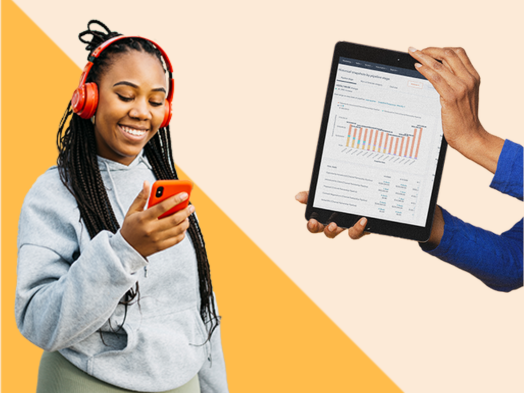
I Took a Deep Dive Into Market Segmentation — Here's Everything I Learned
When I started my own online store with Printify and created social media shops, I found out that marketing segmentation was very important for making steady sales. At first, I tried to sell to everyone, thinking that reaching more people would bring in more customers. […]
ServiceWhen I started my own online store with Printify and created social media shops, I found out that marketing segmentation was very important for making steady sales.
At first, I tried to sell to everyone, thinking that reaching more people would bring in more customers. Instead, my messages were unclear, and my sales were inconsistent.
But when I began dividing my possible customers into specific groups by looking at their interests, shopping habits, and how they interact, it revolutionized how I did marketing and positioned my products.
The result? More sales, better customer service interactions, and a shop that connected well with its audience.
My practical experience taught me a lot, but I wanted to learn more. I took a deep dive into market segmentation –– what it is, why it’s important, and how businesses of all kinds can use it to improve their strategies.
Here’s everything I learned.
Table of Contents
- What is market segmentation?
- Benefits of Market Segmentation
- Challenges of Market Segmentation
- Types of Market Segmentation
- How to Identify Your Best Market Segments
- Examples of Market Segmentation IRL
Think of it like this –– instead of casting a wide net and hoping to catch fish, market segmentation allows you to use a spear, targeting particular types of fish in their natural habitats.
This focused method makes sure your marketing and services reach people who are truly interested, helping you better connect with potential loyal customers.
Benefits of Market Segmentation
Market segmentation has many advantages, especially for improving customer service and support. Here are some important perks I’ve personally noticed and am also learning more about.
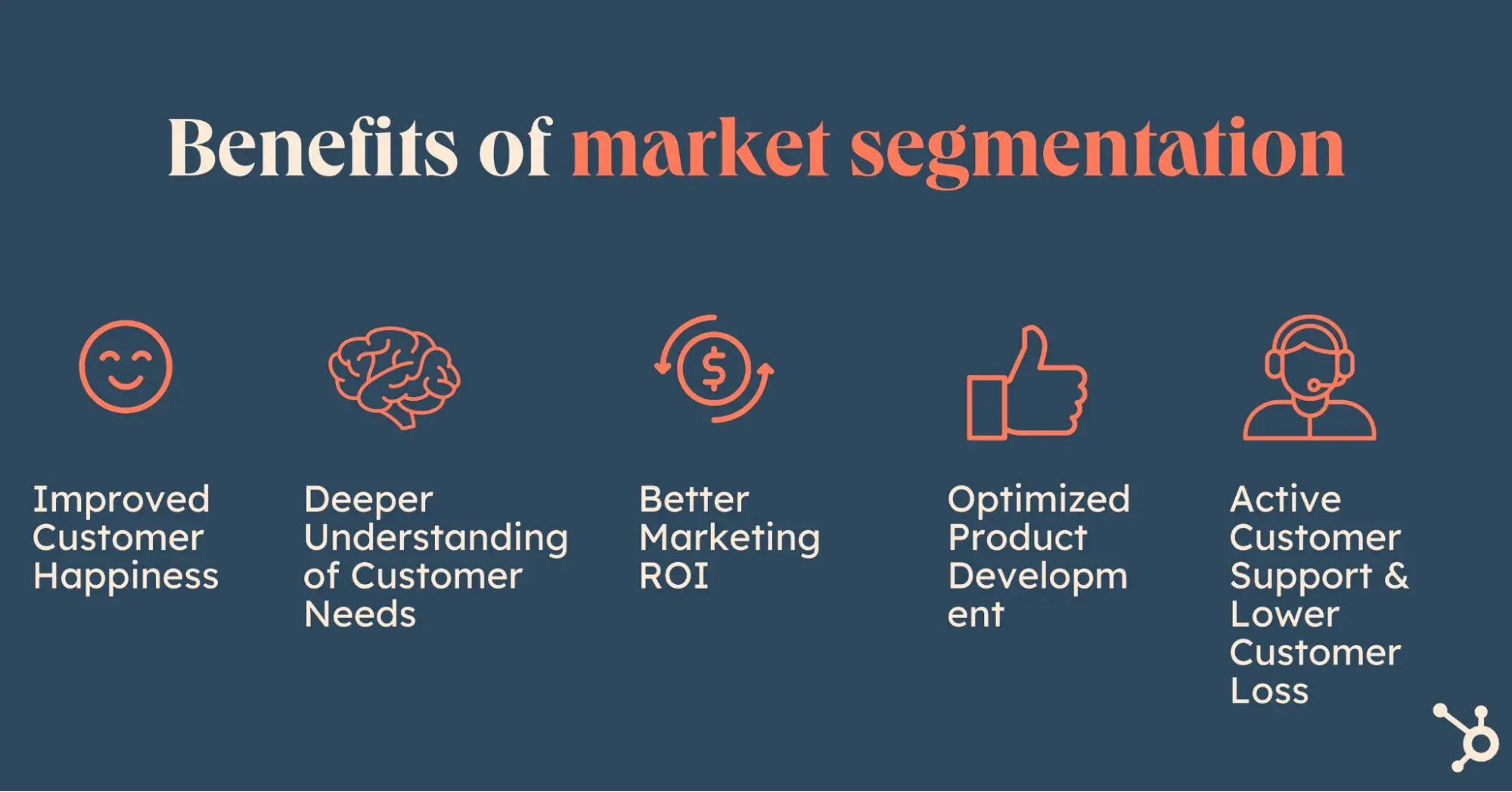
1. Improved Customer Happiness
By knowing what different customers want and need, companies can create more personalized and relevant experiences for them.
For example, if you know some of your customers want quick delivery, you can provide faster shipping choices. On the other hand, price-sensitive groups might like deals or sales.
Market segmentation helps you customize your service for different groups, which makes customers happier. And happy customers are more likely to return and recommend your brand to others.
In fact, the data shows that typically, 72% of customers share a really great customer experience with six or more people.
2. Deeper Understanding of Customer Needs
Segmentation helps you go beyond general ideas and understand exactly what your customers want.
By looking at different groups based on how they act, what they like, and how they shop, you can find similarities and useful information that might not be obvious otherwise.
For instance, you might find out that one group of customers cares a lot about eco-friendly goods, while another group prefers high-quality items. This understanding helps you tailor products, marketing messages, and customer service to fit those unique needs.
3. Better Marketing ROI
When you focus on specific groups of customers with messages that suit them, your marketing efforts work much better.
Market segmentation helps you find and focus on valuable customers who are most likely to be interested in your brand or buy your goods and services.
This focused strategy helps you get the most out of your investment by:
- Cutting down on lost advertising dollars for people who aren’t interested.
- Boosting the number of potential sales or sign-ups.
4. Optimized Product Development
Market segmentation offers important insights for creating products. By knowing what different groups like and struggle with, you can improve your goods and services to meet their specific needs better.
For example, a software company might analyze segmentation data to find features that appeal most to small businesses versus enterprise clients. This understanding can help sell products more successfully and gain a larger market share.
5. Active Customer Support and Lower Customer Loss
By identifying customer segments, you can also predict potential churn risks and directly address them.
RFM research helps you find “at-risk” customers who are losing interest. It looks at how recently they’ve bought something, how often they buy, and how much they spend. Try making win-back campaigns with personalized offers to reconnect with these groups. Taking a proactive approach to customer service can help keep customers and build trust.
Challenges of Market Segmentation
Market segmentation is no doubt a useful tool for businesses, but I’ve found it has notable challenges in today’s environment. Here are the main hurdles marketers are currently facing based on recent studies and industry trends.

1. Data Quality and Access
The growth of data has both benefits and challenges for market analysis. It provides new insights but also creates big privacy issues.
According to some research done by FasterCapital, data quality issues are among the most common problems in customer segmentation, with inaccurate or incomplete data leading to misclassified segments.
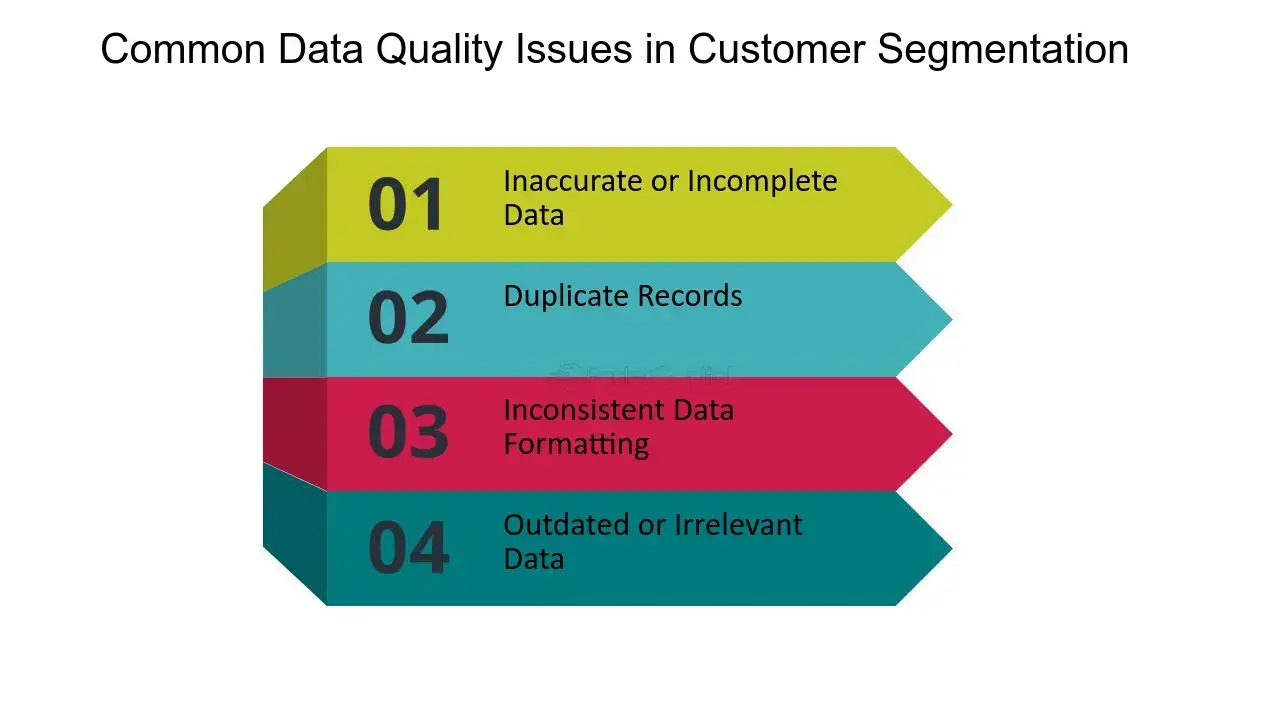
To solve for this problem:
- Keep customer data clean and up-to-date.
- Check data for accuracy.
- Use different sources for a complete understanding.
2. Advanced Skills and Tools Required
Modern segmentation methods are complicated and require special skills and tools. Now, AI and machine learning are changing how businesses target their markets. These days, some AI systems can predict future customer behavior with more than 90% accuracy.
However, many marketing teams don’t have the skills to make the most of these tools.
To solve for this problem:
- Spend more money on training programs to improve data analysis and assessment skills.
- Think about teaming up with tech companies and data experts. Businesses that invest in AI and ML technology will most likely see an increase in their ability to make money from data in 2025.
3. Over Segmentation and Missed Opportunities
Some caution is necessary when segmenting. Research shows you can divide your market too much, making too many small segments that are hard to handle and require a lot of resources.
In customer service, dividing customers into too many groups can make processes more complicated, create disjointed experiences for customers, and waste precious company resources.
To solve for this problem:
- It’s important to find the right mix in your segments and focus on areas that are both important and easy to handle.
4. Changing Nature of Markets
Markets are always changing and developing, and customer needs, wants, and actions change over time due to different outside influences. This means you should regularly update how you handle and analyze your data.
But it’s not always easy: 82% of market researchers cite keeping up with market changes as a major challenge. For customer service, this can mean that the definitions of customer groups and strategies you provide should be checked and updated regularly to stay useful and effective.
In my experience:
During my time building the conversational AI chatbot at Dapper Labs, we regularly analyzed the chatbot interaction data and optimized the chatbot based on how our customers were engaging with it. This really helped identify what they were looking for.
5. Resource Intensity
Maintaining and applying successful market segmentation techniques can be somewhat expensive and demanding in terms of time, money, and human capital.
In regards to customer service, this can mean investing in new technologies, training support agents on segment-specific approaches, and committing ongoing segment analysis and refinement. You may want to check out HubSpot’s Service Hub if you’re in the market for new technologies.
To solve for this problem:
- Carefully consider the expenses and advantages of segmentation and give segments with the highest possible return top priority.
Types of Market Segmentation
The way you go about market segmentation should not be the same for everyone. There are different ways to split markets, each using different methods to make the divisions.
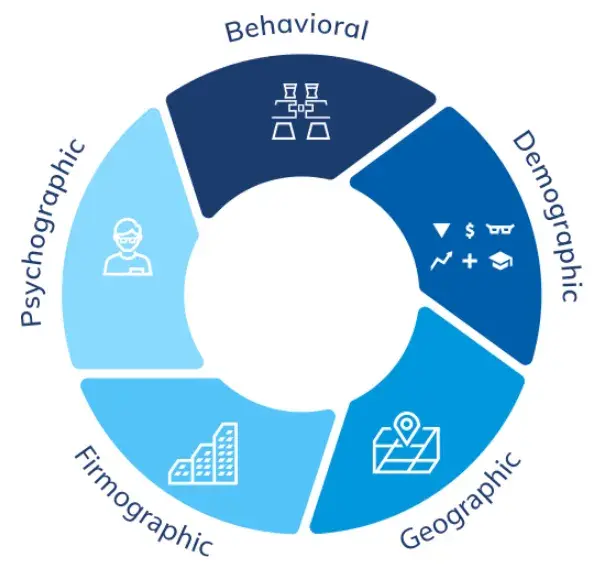
Here are the five main types that I looked into.
1. Demographic Segmentation
This is a simple and popular type that separates the market using clear demographical factors. These factors can be measured and are clear, which makes population segmentation a useful place to start.
How to do it: Collect demographic information using surveys, market study reports, and analytics tools. You can use tools like our HubSpot CRM to help you gather and study demographic information while storing it for future uses.
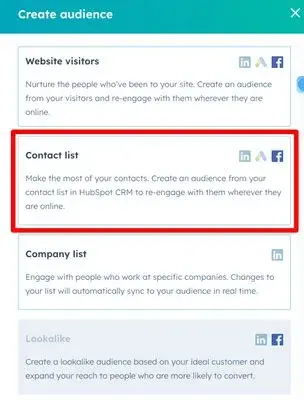
Where it works best: Products and services whose target audience is highly influenced by demographic factors.
Here are some examples that I came across:
- Age-specific products. Toys and clothes of certain ages, retirement planning services.
- Services based on income. Expensive products, affordable flights, money management services.
- Family life stage products. Baby items, family holiday deals, retirement communities.
Real-world example: A financial services company might offer different retirement planning options for various age groups.
2. Psychographic Segmentation
This type of segmentation looks at the psychological factors that influence how consumers behave, paying attention to their lifestyles, values, hobbies, and personality traits.
Psychographic segmentation looks at the reasons behind customers’ decisions, focusing on their thoughts and feelings rather than just their age or gender.
How to do it: Utilize polls, questionnaires, focus groups, and social listening to gather psychographic data. Look at customer feedback, online activities, and how they interact with the brand to understand their ideals and interests.
Where it works best: Products and services that depend a lot on what consumers value, how they live, and their personalities when deciding to buy.
Here are some examples that I came across:
- Lifestyle brands. Eco-friendly clothing, outdoor equipment, health and fitness items.
- Hobbies and interests. Sports tools, art supplies, travel and tourism.
- Products that focus on values. Fair trade coffee, goods bought ethically, and donations to charities.
Real-world example: A sustainable food business would connect with environmentally aware customers by promoting their eco-friendly values.
3. Geographic Segmention
This method segments the market by physical geography. It understands that what people want and like can change a lot depending on where they live and work.
How to do it: Use location data from your CRM system, marketing automations tools, and geographic data providers (if available). Think about all the tools that help you target ads based on location.
Where it works best: Businesses whose products or services are influenced by location.
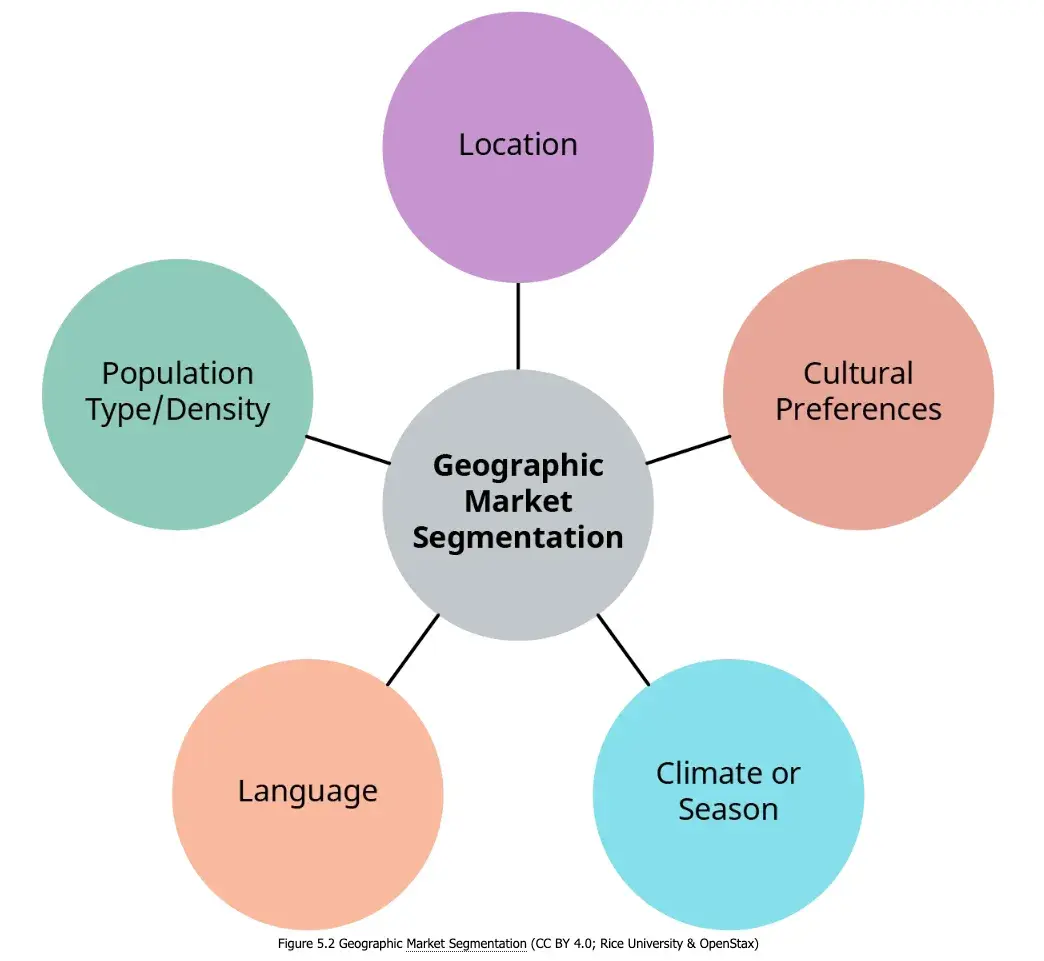
Here are some examples that I came across:
- Climate. Clothes for different seasons, air conditions, services for removing snow.
- Population density. Differences in goods, services, and transportation choices for rural versus urban.
- Culture. Looking into what people eat and drink, what they wear, how they choose to have fun.
Real-world example: A snowboard store would target its marketing in places where people come for winter activities or where it snows regularly.
4. Behavioral Segmentation
In my experience with online shopping and running my ecommerce stores, I’ve noticed how helpful it is to group customers based on their behaviors. This method groups customers based on what they do –– how they shop, talk to brands, and use goods. It’s about knowing who people are and how they choose to buy things.
I actually did my graduating project from San Francisco State on behavioral patterns for online shopping differences between men and women back in 2013. This kind of information can greatly enhance your understanding of your customers and how to keep them coming back.
A study by McKinsey found that companies that use behavioral data to tailor their marketing can boost their revenue by 5% to 15% and improve marketing efficiency by 10% to 30%. This shows that watching how customers behave is not just a luxury, it can be extremely beneficial.
How to do it: Look at website data, buying habits, CRM information, and customer reviews to spot trends in customer behavior. Also, don’t just look at the buying habits but how visitor traffic is engaging with your business, whether that be physical foot traffic or digital.
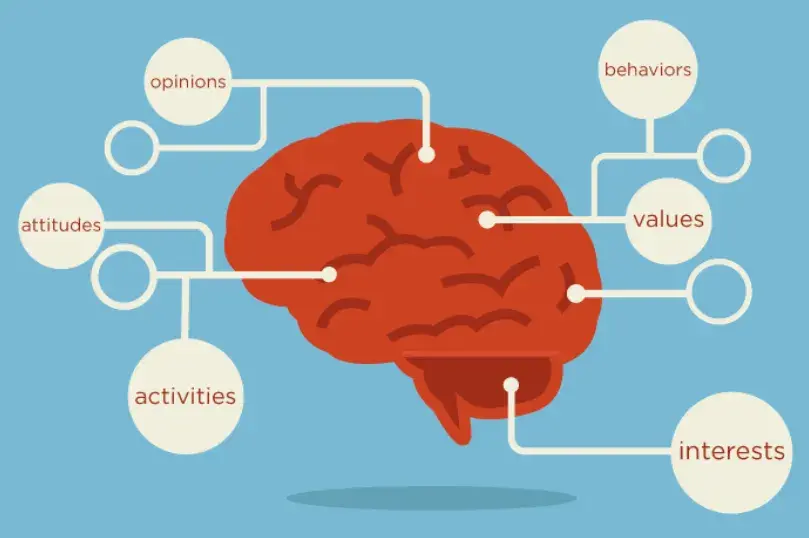
Where it works best: Customer-centric industries where understanding and predicting consumer actions is crucial.
Here are some examples that I came across:
- Ecommerce. Online retailers can leverage this type of data to personalize product recommendations, optimize pricing, and tailor marketing campaigns based on browsing and purchase history.
- Subscription-based services. Companies offering recurring services can use behavioral segmentation to reduce churn, improve retention, and enhance overall customer experience.
- Financial services. Banks and fintech companies can employ this method to offer products and services based on spending patterns and financial goals.
- Travel and hospitality. This industry can benefit by tailoring offers and experiences based on past travel behavior or desired preferences.
5. Firmographic Segmentation
Firmographic segmentation is one that I had to dive a little deeper into as it’s a bit new for me, even considering my years of B2B SaaS experience. It’s similar to demographic segmentation, but instead of looking at individual customer traits, it focuses on the characteristics of organizations in B2B markets.
How to do it: Use B2B data providers like ZoomInfo, Demandbase, Clearbit, Crunchbase, and Dun & Bradstreet for information about company size, revenue, and business type. You can also leverage CRM and sales tools like HubSpot CRM or LinkedIn Sales Navigator to organize businesses and find people who make decisions.
Where it works best: B2B products and services where company characteristics influence purchasing decisions. Essentially, where factors like company size, industry, and revenue shape buying needs.
Here are some examples that I came across:
- SaaS solutions. They enable companies to customize their offerings according to factors such as company size, industry, and technology adoption levels.
- Business services. Helps organizations like consulting, finance, and logistics firms to effectively segment their business services based on industry, revenue, and employee count.
- Industrial equipment. Focuses efforts on businesses based on their production scale and geographic location.
How to Identify Your Best Market Segments
Identifying the most promising market segments is a crucial step in the process. Here’s an outline of the general best practices that I discovered while doing my research.
1. Begin with market research.
First, gather comprehensive insights about your existing and prospective customers. This involves executing surveys, interviews, and focus groups to gather both quantitative and qualitative insights. Your market research is the foundation of your market segmentation capabilities.
Pro tip: Here are 28 tools and resources you can use for conducting market research. You can also download our free market research kit to get you started.
2. Analyze your data.
Once you’ve collected sufficient data, the subsequent step is to review it to identify patterns and trends. Leveraging statistical analysis enables the identification of common traits and behaviors across diverse customer segments.
Pro tip: Use data visualization tools to quickly spot patterns and trends in your data. Basic charts will do, but I personally love using heat maps and scatter plots. This will help you identify common behaviors and traits across customer segments more effectively, turning raw data into actionable insights.
3. Develop buyer personas.
Now is the time to leverage your data to craft detailed profiles of your ideal customers for each segment.
Buyer personas must accurately reflect your target segments, encompassing details about their objectives, obstacles, preferences, motivations, and both demographic and psychographic traits. These characters enhance the relatability of your groups and streamline collaboration.
Pro tip: Check out our free “Make My Persona” buyer persona generator.
4. Segment your market.
From here, you’ll want to use these buyer personas to divide your total market into distinct segments.
Consider trying various segmentation strategies to establish more defined and actionable groups. You want to ensure that each group consists of individuals with similar characteristics, distinct from other groups, and sufficiently sized to drive profitability.
Pro tip: When segmenting your market, ensure each segment is measurable, substantial, and actionable. Use a mix of segmentation strategies so you have more to work with as you enter the testing stage. These customer segmentation templates can help.
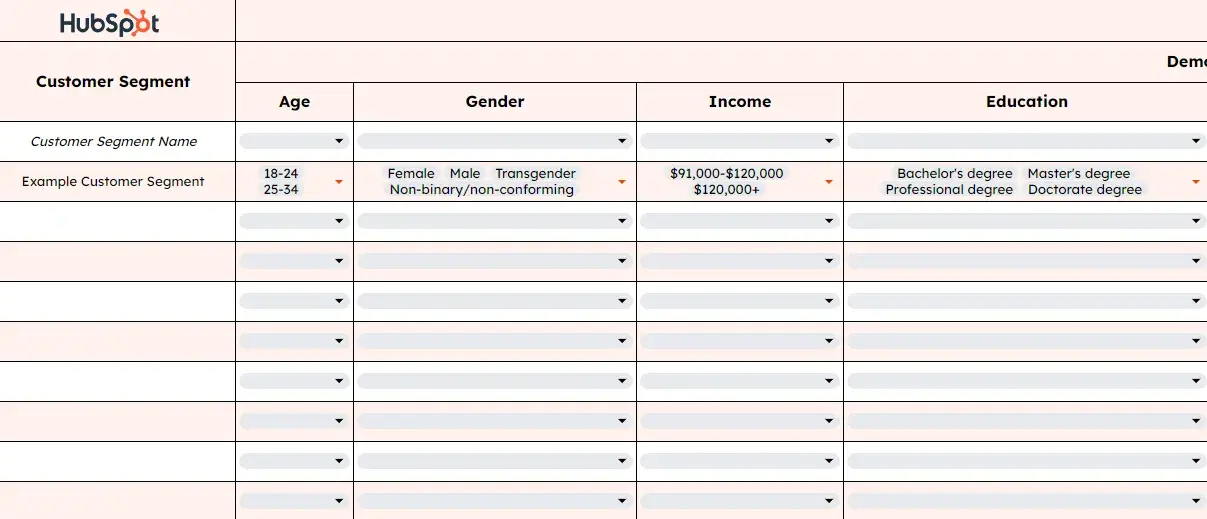
5. Test and optimize.
Once you’ve identified your segments, implement your marketing and customer service strategies for each group. Monitor the feedback and outcomes to refine your approach. Market segmentation is a continuous endeavour.
Pro tip: Instead of just testing marketing tactics within existing segments, I came across this advice to A/B test different variations of the segment definitions –– like adjusting the age ranges or psychographic criteria –– to find the most responsive and profitable groups.
This type of continuous refinement is something I saw at Trendy Butler. It ensures your segments stay aligned with evolving customer behaviors rather than relying on outdated assumptions.
6. Leverage segmentation tools.
Implement technology to streamline your segmentation process. CRM platforms offer functionalities that enable users to categorize and organize contacts into lists according to various criteria.
Utilizing marketing automation tools enables the segmentation of audiences based on their behaviors, allowing for the delivery of tailored campaigns that resonate with individual preferences.
HubSpot’s list segmentation empowers businesses to gain insights into their customers, enabling them to deliver more tailored experience.
Examples of Market Segmentation IRL
While I’ve gained valuable insights into segmentation through my own work in subscription-based businesses and ecommerce, this article is the result of a deeper dive into the subject, building on both what I already knew and new discoveries I’ve made along the way.
Below, I’ll break down some real-world examples of how companies implement market segmentation strategies, what I’ve learned from them, and how they align with the principles of market segmentation.
1. Nike – Master of Psychographics
When it comes to demographic and psychographic segmentation, Nike is a master. The strategy that Nike employs to target various customer groups has been an essential component of the company’s success on a global scale.
On the surface, it may appear that Nike’s market strategy consists solely of categorizing customers according to demographic factors like age, gender, or sports interest. Nevertheless, the incorporation of psychographics is what truly stands out in their approach.
A mindset of attaining personal objectives, conquering problems, and pushing boundaries is something Nike encourages its customers to adopt.
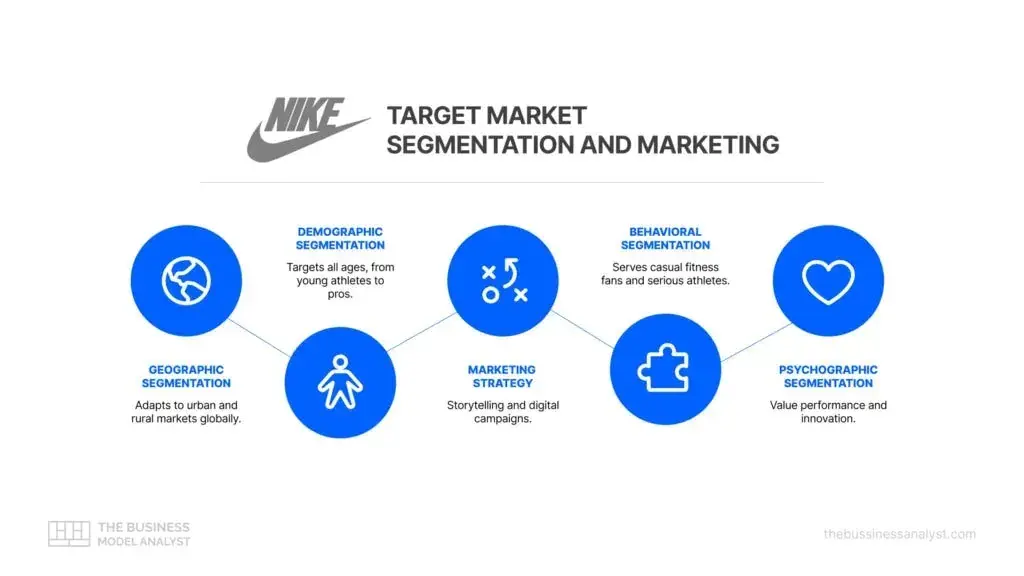
Through a deep customer awareness and an understanding of purchasing decisions, Nike is able to establish a strong connection with their community. Their “Just Do It” slogan places an emphasis on personal identity, as well as goals and motivation.
Despite the fact that I was already familiar with the concept of market segmentation, my research on Nike further showed me how essential it is to understand your consumers values and viewpoints.
2. Starbucks – Personalization Through Geography
Starbucks is an excellent example of how businesses can blend location and customer interests to develop a brand that is successful on a global scale — all while maintaining a sense of personalization for customers in their own local markets.
As a result of my research, I discovered that the company actually modifies both the products they sell and the layout of their stores in order to cater to the interests and cultural customs of other regions.
For example, in China they cater to the preferences of the locals by offering beverages such as red bean frappuccinos. On the other hand, during the fall season in the United States, pumpkin spice lattes are all the rage.
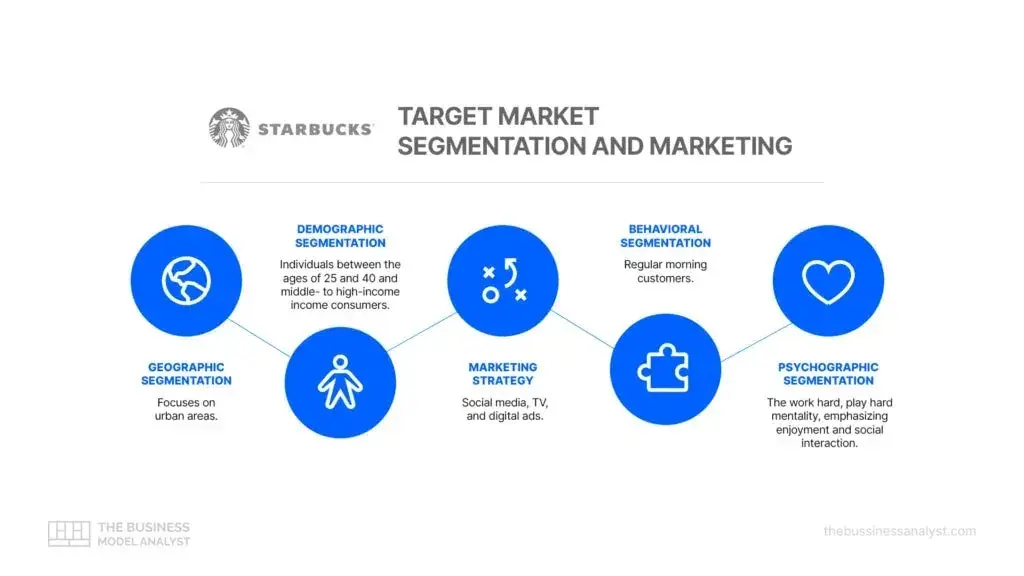
Customers who view Starbucks stores as a “third place” where they can relax or hang out doing their work is exactly the type of customers they are looking to attract.
As someone who has worked in customer service for many years, I am very aware of how important it is for a company to establish a genuine human connection with the people who use its products.
I can see why Starbucks has found much success in striking a balance between a worldwide brand that is consistent and provides local flavors, ensuring that their products and experiences seem personal in each and every market.
3. Netflix – Behavioral Segmentation Beast
Netflix is a great example of how splitting customers into groups according to their activity and region may help keep customers interested in the service and lower the number of people who cancel their memberships.
Netflix is able to learn how their viewers watch episodes through the use of behavioral segmentation, which helps them provide those very accurate, personalized recommendations.
Understanding and being able to predict consumer behavior is something I’ve personally witnessed in both my scholastic endeavours and professional career, and it can really enhance your approach to customer experience, too.
If you are aware of how customers use your service, you’ll be able to better predict their demands and boost the amount of engagement you have with them.
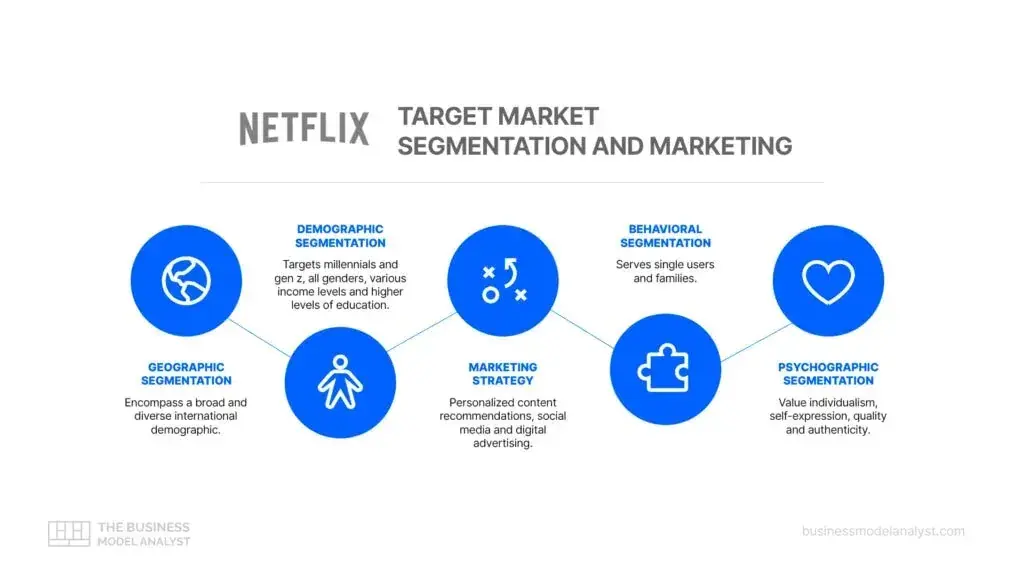
The manner in which Netflix utilizes geographic and behavioral segmentation is something that I found to be very interesting about their strategy. They really think above and beyond when it comes to their offerings.
In order to provide viewers in different regions the impression that their viewing experience is tailored specifically to them, Netflix adapts its content to the languages, cultures, and preferences of the local community. That, tied in with viewing behavior, can be incredibly powerful.
Market Segmentation Learnings
Deep diving into market segmentation for this post? Honestly, pretty eye-opening stuff.
It’s evident that proper market segmentation is one of the fundamental blueprints for scalable growth and creating a truly customer-centric brand. Understanding and executing on market segmentation is necessary for everyone in the startup trenches looking to optimize their GTM strategy and create long-term success.
Thinking back to my online store launch, that initial broad-stroke marketing was a classic startup move, but totally inefficient. The biggest learning curve was realizing it’s not about volume — it’s about precision. Shifting from mass marketing to truly understanding and targeting specific customer segments? That’s where the real leverage is.
![]()
Testimonial Questions Reps Need to Ask Their Customers
I love a good success story, especially when the main character has worked hard to overcome a specific problem. In the SaaS world, a testimonial that communicates that win is gold. The best way to share that story is by asking happy customers a few […]
ServiceI love a good success story, especially when the main character has worked hard to overcome a specific problem. In the SaaS world, a testimonial that communicates that win is gold. The best way to share that story is by asking happy customers a few testimonial questions.
In today’s buying market, it’s no secret that customer acquisition costs continue to rise and consumers require more information than ever to make a buying decision. Advocacy efforts like customer testimonials unlock a more cost-effective way to generate leads and drive new business.
Whether they’re written, visualized, or recorded as a video, customer testimonials can be a powerful deciding factor in the sales process as they increase the level of trust that consumers have in a business. The foundation of any great testimonial is the story, and these testimonial questions will help you craft a compelling story that helps pitch your offering in an authentic way.
In this article, we’ll cover:
Testimonial Questions to Ask Your Customers
I’ve grouped these client testimonial questions into sections based on their overall theme, and I’d recommend choosing one to two questions from each section. By choosing questions from different sections that compliment each other, you’re able to easily thread the story of your customer’s success.
Setting the Stage: Questions About the Buying Journey
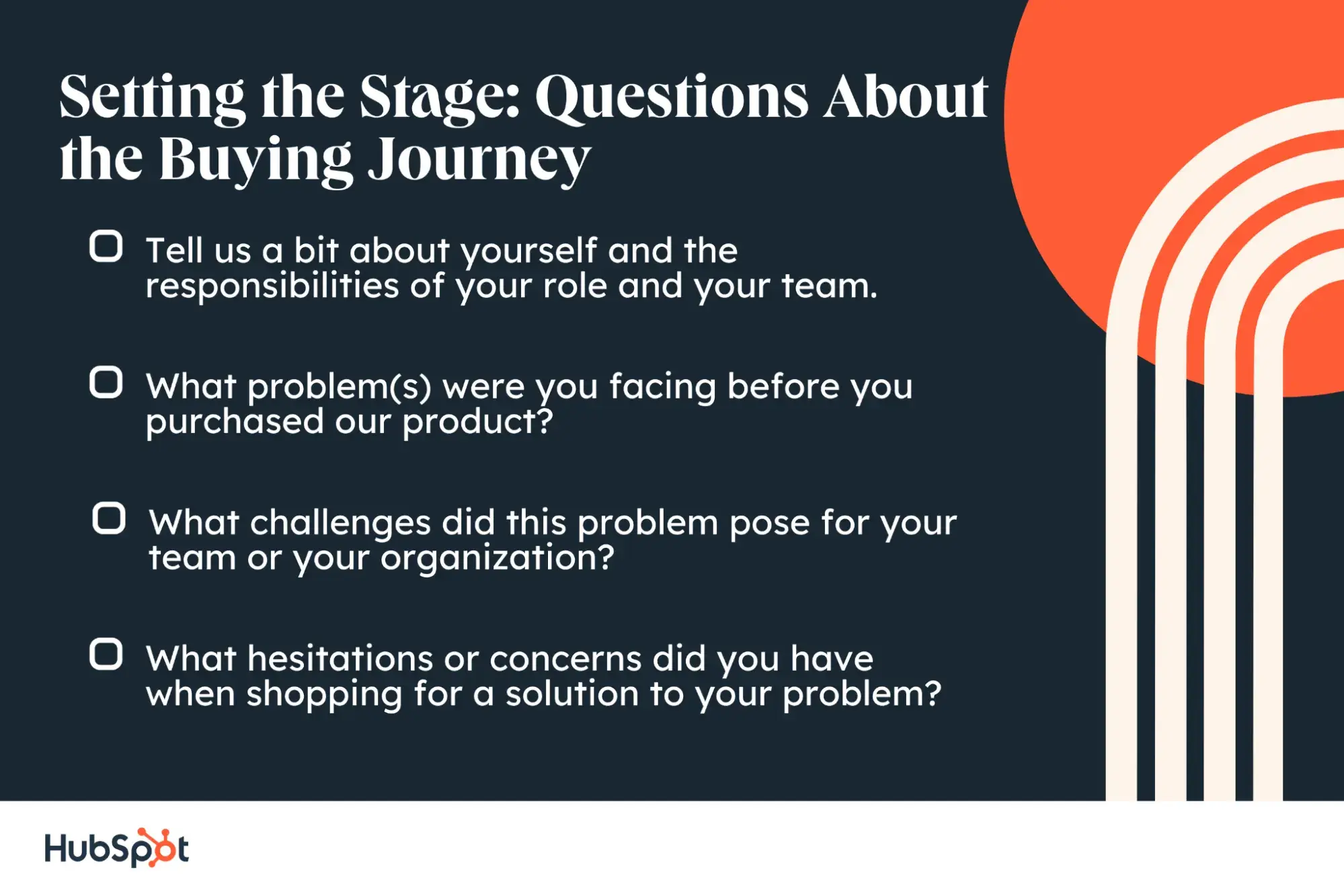
1. Tell us a bit about yourself and the responsibilities of your role and your team.
When I ask this question, I want my customer to describe their role and the responsibilities of their team. With that information, I can better understand the daily tasks that my product impacts. The answer I get helps the reader see what processes my product might simplify.
If I’m talking to a few different people from the same organization, I can show that the impact of my offering can be felt across multiple people in an organization.
2. What problem(s) were you facing before you purchased our product?
This question prompts your customers to share the challenges and struggles they had before buying your product or service. You can use their response to demonstrate how your business can solve other customers’ needs.
I like this question because your customer probably isn‘t alone in the problem your product helped them to solve. If you’re segmenting your customer base into buyer personas, then it’s likely that other customers will be experiencing the same problem. By including their story in your testimonial, leads will see a proven track record of customer success.
3. What challenges did this problem pose for your team or your organization?
I always ask this question to show how my customer’s business problem goes beyond just their daily role and affects the broader team or organization. With that information, my reader can envision how important it is to curb the impacts of this shared problem. This insight is a great way to make potential buyers realize what purchasing your product could do to mitigate the problem’s spread.
4. What hesitations or concerns did you have when shopping for a solution to your problem?
It‘s hard for any person to pull the trigger and make a big purchase. And, it’s likely that your customers will share similar concerns when undergoing difficult buying decisions. Detailing their objections — and how they overcame them — will empower other prospective customers to do the same.
Additionally, I’ve seen marketing and customer service teams use this feedback to improve the customer’s journey. By understanding the biggest roadblocks affecting your leads, you can remove these distractions and increase lead conversion.
Differentiators: Questions About How Your Company Stands Out
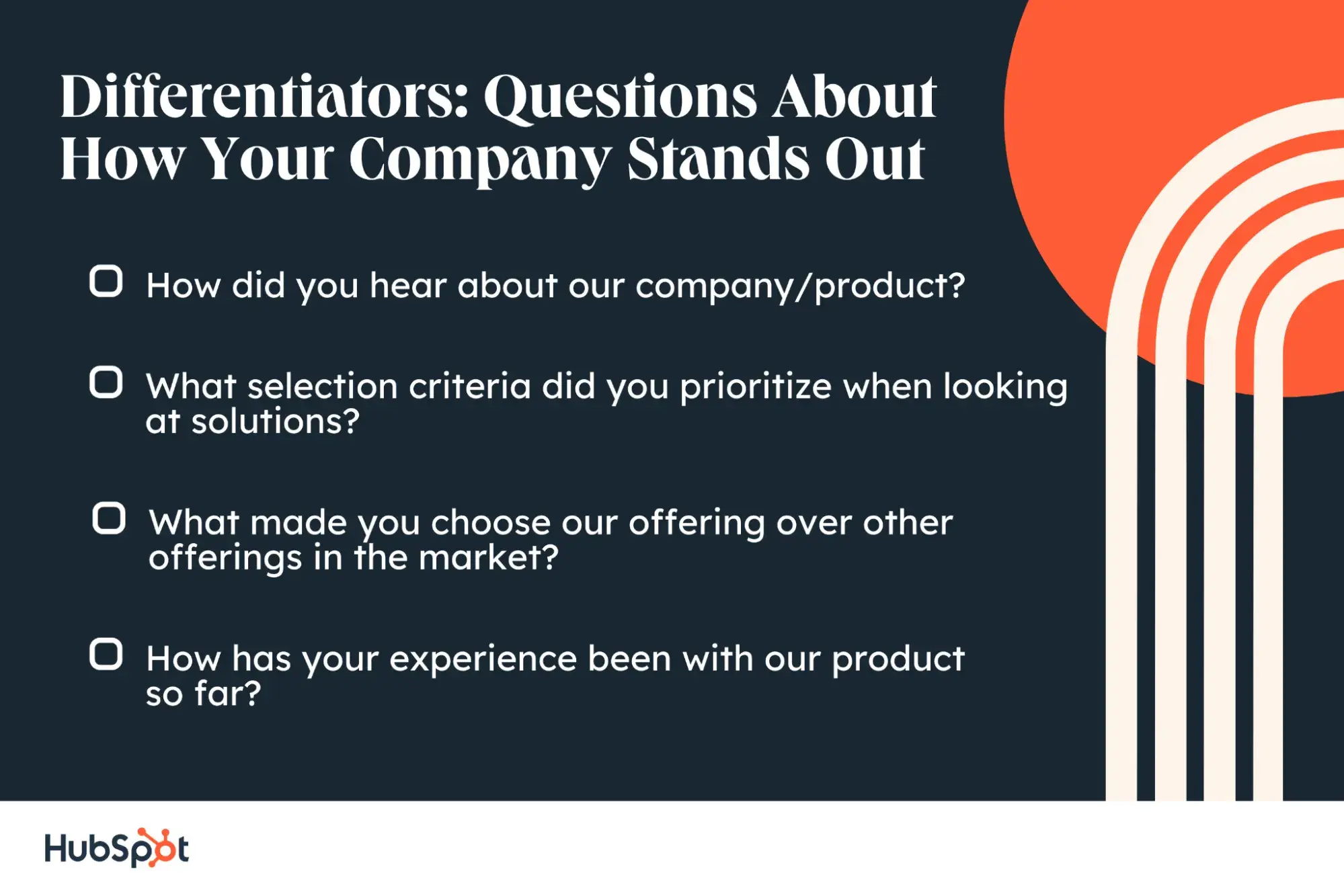
5. How did you hear about our company/product?
By explaining how they started searching for a solution and where, the customer can subconsciously guide someone to do what they did. This gives customers a clear path to purchasing your product, making buying decisions much easier.
I’ve noticed that if leads can relate to your customer‘s starting point, they’ll see my business as a shortcut to long-term success.
6. What selection criteria did you prioritize when looking at solutions?
Customers may have different buying criteria when shopping for solutions. Having your customer narrow down what was important to them is like a bat signal for folks in the same predicament. The answer to this question can encourage others in your customer persona to consider a similar prioritization strategy.
The response to this question can also reinforce that there are often more important factors to consider than just the final cost of a product. That lightbulb can help customers who may be on the fence to consider more than just the price tag in their final decision.
7. What made you choose our offering over other offerings in the market?
Leads often compare products between competitors. This question will make it extremely clear to prospects what your product’s X factor is.
What was the bottom line that contributed to your customer’s decision to buy? Was it a product feature? Your customer service team? The price? In my experience, these answers help prospective customers reading or listening to the testimonial evaluate their priorities. This will also let your marketing team know which aspects of your business are most desirable to customers.
Leads will be more likely to trust testimonials than traditional advertising. It‘s one thing if your business says it’s better than your competitors. However, I’ve seen greater impact when a real-life customer says it. Customer advocacy plays a major role in lead acquisition and customer retention.
8. How has your experience been with our product so far?
I ask this question when I’m looking for a high-level answer about my product or looking for something I can easily use as a quote in promotional materials. When answering, customers can hone in on whichever area of the product experience stands out the most to them.
If you’re looking to get more granular, I’ve included more experience-specific questions later in this post.
Impact: Questions About the Benefits of Your Product
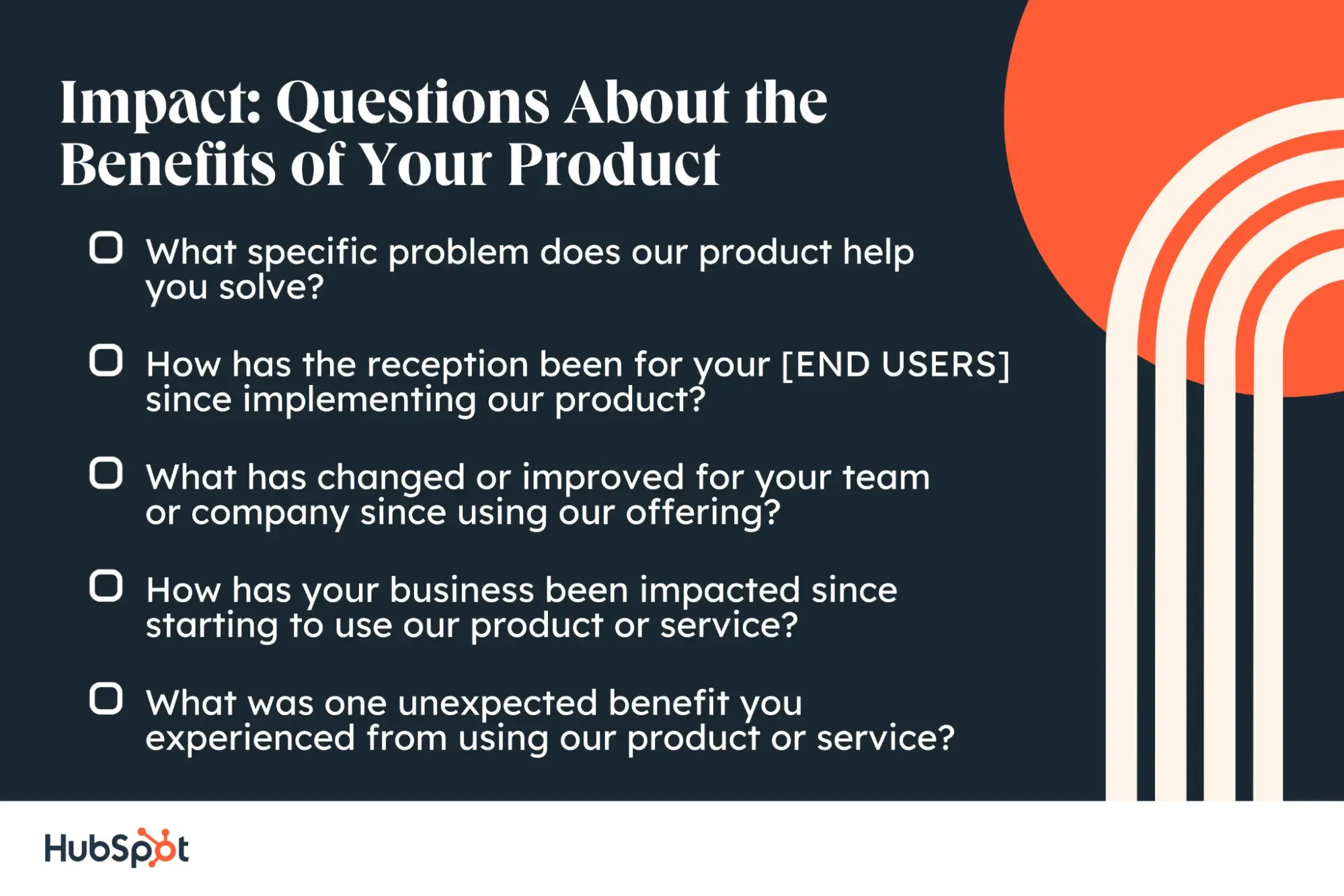
9. What specific problem does our product help you solve?
I’ve personally discovered that by asking this question customers tell us exactly how our product helped them solve their problem or challenge. This answer helps connect the dots in the story if you’ve already asked question two. You’ve already mentioned the problem, and now you can highlight the solution (your product!).
10. How has the reception been for your [END USERS] since implementing our product?
If your product has different personas, like buyers and end users, I highly recommend asking this question. This question highlights how your product or offering makes an impact across teams within the organization. I’ve found that including this question ensures you’re highlighting the experience of the individuals who will be using your tool on a daily basis.
For example, when I worked in martech, I routinely asked my customers (who were marketing leaders) what they were hearing from their sales development representatives (our end users). More often than not, their SDRs were seeing an increase in lead conversion from using our product. Naturally, their feedback about the tool was positive!
11. What has changed or improved for your team or company since using our offering?
This goes back to highlighting the broader impact of your offering. We all know that budgets are tight, specifically in SaaS. In my experience, most commercial conversations now happen with a CFO or even procurement teams. This creates even more pressure to prove value realization.
If you can highlight that your product is making a difference across multiple areas of the company, you’re giving your potential buyer an even better proof point to use in their internal budget conversations. If you can get specific numbers to show your impact, even better.
12. How has your business been impacted since starting to use our product or service?
Results can be exceedingly persuasive. With this question, I can prompt my customers to think about their experience with my product in terms of the impact it created. Maybe their revenue increased by $30,000, or they won 15% more customers than they did last year. These quantifiable, tangible wins sell your product for you.
13. What was one unexpected benefit you experienced from using our product or service?
The great thing about this question is that it’s completely up for interpretation. Your customer can share a financial, personal, or team-related benefit.
For instance, your customer might be averse to carrying out report meetings, because they don’t like public speaking. Your marketing software made it much easier to compile performance data for stakeholders, negating a need for a meeting. These sorts of anecdotes communicate the strength of your product in small but impactful ways.
Questions to Highlight Specific Selling Points

14. What was your buying experience like with us?
I don’t think anyone likes the process of buying a new product or piece of software. It’s typically a lengthy and time-consuming process that requires multiple steps. But, if your sales team built trust and left the customer with a positive experience, then that’s worth highlighting.
A company’s reputation has been noted as the most influential factor in choosing a vendor. Highlighting a positive buying experience with your brand can help build trust and credibility for new prospects who are considering entering the sales process.
15. How smooth was the implementation stage?
The implementation stage is where your company has to start delivering on what you promised. When prospects are shopping, they want to know if your company will help them get onboarded in a way that sets them up for success.
In fact, nearly two-thirds of customers said that they take the onboarding period into consideration when deciding whether or not to make a purchase. I’ve noticed that highlighting your customer’s positive experience with onboarding can help reassure a prospect that you’ll deliver a great implementation experience.
16. How has your support experience been with us?
I have seen the post-sale support experience make or break the relationship between a brand and its customers. Prospects are weighing customer support as part of their buying criteria. Over 50% of customers are willing to make a purchase solely on the support they expect to receive.
Of organizations, 81% already cite customer experience as a leading differentiator, so I highly recommend highlighting a positive post-sale experience when you can.
17. Was our product worth the initial investment? If so, why?
In my experience, every contract signer or executive sponsor wants to know one thing: Was this purchase worth the investment? This question allows the customer to answer in their own words. Plus, you’ll have a powerful sound bite to use in your testimonial.
18. How has this product helped you do/solve [SPECIFIC VALUE PROPOSITION]?
If your product has specific and defined value propositions, your marketing team likely already knows which one(s) are the top value drivers for customers. If you know your personas, you can draw out common pain points and clearly explain how your product helps.
By putting a specific value proposition into this question, your customers can tell prospects that your product solved a very specific pain point for them. This helps prospects envision your product solving that same point for themselves.
19. What has exceeded your expectations since working with us?
Sometimes, business is cut and dry. However, it’s always a smart idea to surprise and delight your customers so they’ll keep talking about it in their recommendations. Customers will remember the times that your business provided above-and-beyond customer service, and leads will want to hear about these stories, too. It’s a lot easier to show how great your service is when highlighting individual moments of excellence.
Advocacy Questions
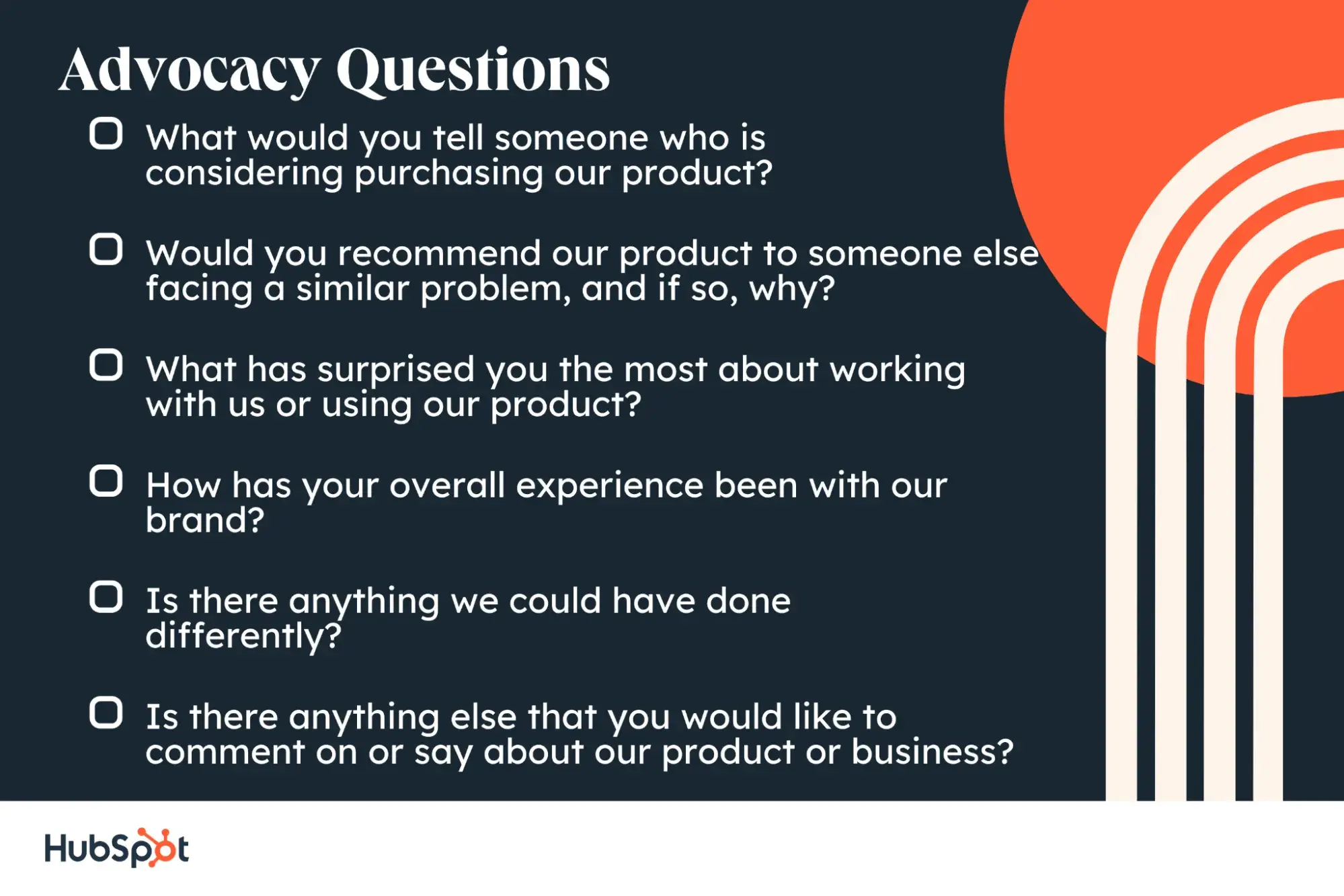
20. What would you tell someone who is considering purchasing our product?
When leads are considering your business, customer testimonials are perfect for convincing them to buy your product. In fact, 81% of leads look at customer reviews before making a purchase.
Having your customers give advice to leads during their buying decisions will help your sales and marketing teams capitalize on timely opportunities to convert leads. They‘ll know when leads are likely to hit roadblocks and what they’ll need to say to overcome them.
21. Would you recommend our product to someone else facing a similar problem, and if so, why?
Consider this question the cliff notes version of a testimonial. In just a few sentences, your customer tells the reader exactly what made them so satisfied with your brand, proving that they’re happy enough with the product to give a public recommendation.
I like this question because it’s focused on the problem that the customer shares with the reader, which lends more credibility to the recommendation.
Prospects now lean on credible recommendations to inform their decision making, with roughly 92% of business buyers reading reviews and testimonials before making a purchase.
22. What has surprised you the most about working with us or using our product?
This question provides insight into the customer’s perception of your brand or product. When they first purchased your product, they had a goal they were hoping to accomplish.
However, some customers will find that your business offers other benefits — like rewards and loyalty programs — that help them achieve more than they initially thought. By collecting these stories, you can show leads that your company is focused on the entire customer experience, not just on selling a product.
23. How has your overall experience been with our brand?
In earlier questions, we asked the customer about their experience with your company’s product, implementation process, sales process, and support.
This question differs slightly in that it can highlight the customer’s overall experience with your brand. (Or if you’re a small business that doesn’t have separate teams and functions, this question is open-ended enough for the customer to pick what they’d like to highlight about their experience.)
A positive statement from a customer about their experience with your brand helps with your brand perception. We know that brand perception is closely tied to trust and credibility (and 81% of consumers say that trust is a deciding factor in their purchasing decision), so your customer’s response to this question can positively influence the credibility of your brand.
24. Is there anything we could have done differently?
This question is geared toward your marketing and customer service teams. Unless the customer doesn’t have anything to add, these responses should be saved as useful pieces of customer feedback and are not typically included in the actual testimonial. Keep in mind, customers providing testimonials should be your happiest customers.
Getting their feedback is a crucial part of maintaining customer satisfaction and improving the customer experience. This question also makes the testimonial seem less staged and more realistic.
25. Is there anything else that you would like to comment on or say about our product or business?
This last question opens the floor and lets the customer say what‘s on their mind. This is important because your questions may not have addressed every experience they’ve had with your brand. By letting the customer speak freely, you’ll obtain some unique feedback that you may not have considered about your products or services.
Need more inspiration for questions? I recommend looking at review sites like G2.com to see which selling points buyers care about. Look up your offering (or competitors) on a review site, identify the key criteria that customers are reviewing, and then tailor a few of your testimonial questions to reflect that criteria.
Tips & Tricks for Testimonials by Format
Testimonials can be delivered in a variety of formats, including video, written quotes, case studies, and more. While all of the questions I listed above can apply to any format, here are a few tips and tricks to enhance the responses to your video, written, and short-form testimonial responses.
Video
Video testimonials, whether done virtually or recorded in person, are a great way to make the testimonial feel more authentic. You can highlight a customer’s genuine emotions and reactions.
In my experience, video testimonials typically include more questions than written testimonials. This format also relies on open ended questions to allow the customer to share their story. Once a customer has agreed to a video testimonial, I try to give them ample time to prepare for it by sending over the questions you’ll be asking in advance.
Written
Written testimonials can be the easiest to acquire since customers can submit them on their own time. If you’ve built out a testimonial form or questionnaire, try to make this as frictionless as possible for your customers by only asking a handful of questions (or consider making a few questions mandatory but include a few more that are optional).
Implement a few creative experiences for customers to submit their written testimonials, like building a testimonial chatbot to make the submission process feel more conversational and less tedious.
Short-Form Quotes
Consider creating quick and easy ways for customers to answer a single testimonial question on their own time. I recommend building open-ended testimonial questions into different points of the customer journey, such as after a specific product outcome is achieved or once a customer officially moves into onboarding after signing the deal.
Be careful to check where NPS surveys sit in the customer journey so as to not overwhelm customers with requests for feedback.
The Right Questions Help You Tell the Right Story
In writing this piece, I realized that customer testimonial questions have changed over the last few years. Today’s testimonial questions place more emphasis on the overall customer experience (which I love) versus just the product’s capabilities. I imagine this is a result of consumers weighing the customer experience as one of the top factors in their buying decisions.
I also see the questions beginning to adapt to show “value realization.” In Saas, we’re no longer able to obtain a renewal with one single ROI factor. We now have to prove that our product solves multiple problems or impacts multiple areas of the business.
Testimonials remain a key part of the buying process, and I don’t see that going away any time soon. Since consumers often trust each other more than they do a business, testimonials can persuade potential customers to make a purchase by offering a relatable and authentic perspective on a brand or product.
Using the above questions is a great way to ensure you get answers to build a compelling story that highlights the effectiveness of your product, in turn helping you acquire new customers and grow your business.
Editor’s note: This article was originally published in May 2018 and has since been updated for comprehensiveness.
![]()
How the Customer Journey Funnel Revamps Traditional Methods and Drives Business
When was the last time you moved through a customer journey funnel in just one step — seeing a product, deciding you needed it, and purchasing it immediately? Unless it’s a routine grocery item, that’s probably not how you buy. The modern buying process is […]
ServiceWhen was the last time you moved through a customer journey funnel in just one step — seeing a product, deciding you needed it, and purchasing it immediately? Unless it’s a routine grocery item, that’s probably not how you buy. The modern buying process is far more complex, with consumers needing multiple touchpoints before making a decision.
Research shows that this is a common behavior. In fact, customers often need between 7 to 13 touchpoints before completing a sale in the B2B space (and around eight touchpoints in B2C). When I see something I’m interested in, I always spend some time researching it before I hit “purchase.”
So, you need a process to get customers from learning about your brand to actively buying. While many companies have this type of funnel, they often focus just on marketing and sales. From my 14 years in the field, I know that successful companies focus their funnels on the customer. Below, I’ll explain the customer journey funnel, what it solves, and why it works.
Table of Contents
Why the Marketing and Sales Funnel Needs a Revamp
Most businesses today use a marketing funnel to inform their engagement strategy, with many still relying on the traditional AIDA model. The AIDA framework describes four stages that buyers go through in their purchasing journey:
- Attention (or awareness).
- Intent.
- Desire.
- Action.
That seems pretty straightforward. However, customers don’t purchase in a linear way, says Karin Holmgren, marketing director. Some customers need more steps before they’re ready to buy.
“Seeing the path to a sale, even gathering all the data from different systems and making sense of them, can be overwhelming. One customer may need to see 5 Instagram ads, and another sees none; one customer clicks on one email and purchases — another unsubscribes but still purchases,” Holmgren says.
Beyond that, I’ve noticed a huge flaw of the AIDA model. When you look at the funnel below, do you notice anything missing? The process ends after the point of sale.
When looking at this model, I assume that the customer’s buying journey is over after that initial purchase. However, as a customer success professional, I know the importance of nurturing this relationship after a deal has closed. That’s how I turn our customers into brand evangelists.
Marley Wagner, a digital customer success consultant, notes that repeat business has become increasingly important in today’s subscription-driven world.
“A majority of marketers have been exclusively focused and measured on driving net new revenue from the acquisition of new customers,” Wagner explained. “But the subscription economy necessitates a longer-term view of the retention and growth of that revenue, on top of the continuous addition of more and more new customers.”
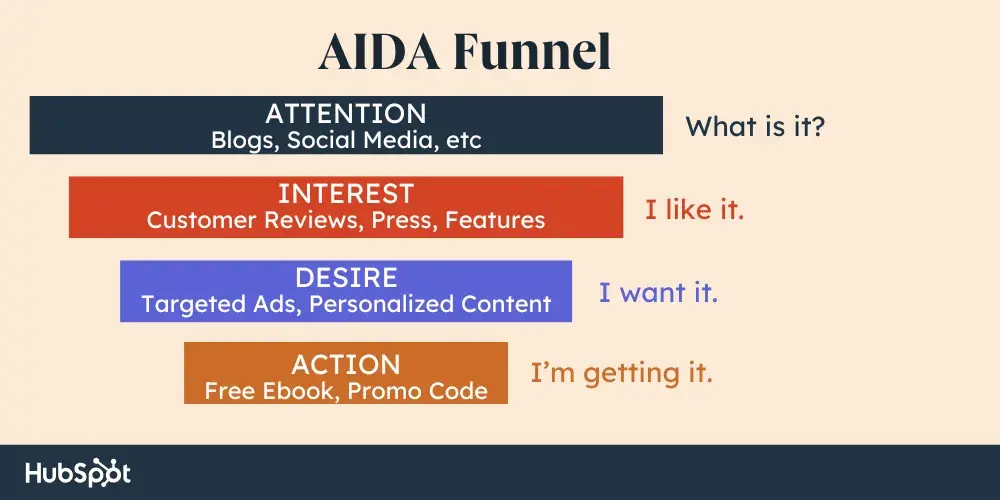
So, while the traditional sales and marketing funnel makes a great foundation, it’s due for an upgrade that reflects the complexity of today’s buying journey, including a customer’s intent to repurchase.
That’s where the customer journey funnel comes in.
Why The Customer Journey Funnel Is the Solution
The customer journey funnel helps you understand the holistic buying journey from your customer’s perspective. This framework allows you to create strategies to engage your ideal customer at each individual stage, with a focus on retaining business.
The customer journey funnel is unique because it provides insight into the end-to-end buying experience and includes two additional stages missing from a marketing funnel. So, the stages of the custom journey funnel include:
- Awareness.
- Consideration.
- Conversion.
- Retention (or loyalty).
- Advocacy.
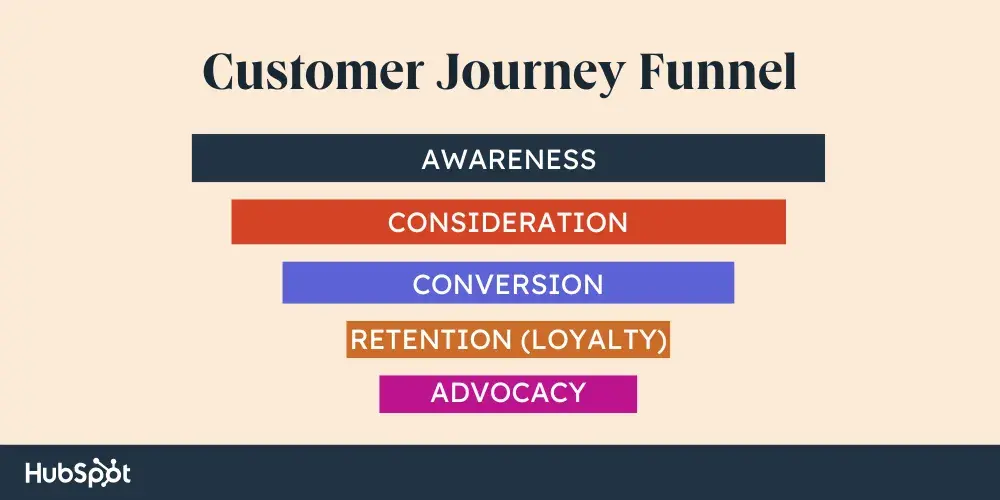
Why should you use a customer journey funnel? Taking the time to nurture your customers in those post-sale stages is worth the investment. Businesses continue to report that repeat customers make up the majority of their annual revenue and spend more on average than new customers.
Using this framework can also help you increase personalization (which is shown to drive 10-15% more in revenue), increase your conversion rates, and retain and grow your current customer base.
“There is absolutely value in marketing teams considering the entire customer journey in their efforts, rather than simply ignoring anything that happens after a sale is marked closed,” says Wagner.
However, she notes that business leaders need to set team goals and KPIs that align with this broader purview. Sales and marketing pros also need to “work in close concert with the customer success organization, Wagner says.
How to Build a Customer Journey Funnel
Before you start creating your funnel, there are a few important things you’ll need to identify. It’s critical to include insights from key stakeholders like your customer experience, sales, and even product teams as you work through this process. Here are my recommendations for getting the foundation right.
1. Identify the stages of the customer journey.
When creating a customer journey funnel, I start by using data and insights about my company’s buyers. I can then map out the buying journey from their perspective. I recommend working on this with your customer experience team. They likely have already created a customer journey map.
When defining stages, I start with the first touchpoint with my brand (awareness) through the point of conversion. Then, I can add what loyalty and advocacy look like, better defining those two new stages.
Pro tip: Feel free to name the stages in a way that makes sense for your brand. I’ve seen the second stage named in many different ways, including consideration, intent, interest, and nurture.
If you want to test this out, try our free customer journey template. You can outline your company’s customer journey and experience with these seven free templates from Hubspot.
2. Align customer behavior.
In the section above, I defined the stages of the customer journey. These stages now become the different parts of my funnel.
Once I have my stages defined and named, I map out what customer behaviors and actions happen during each stage. By understanding what my customers are doing at different stages in their buying journey, I can tell what they need and how to engage them in a relevant way.
Customer behavior can be things like reading reviews, clicking on an ad, or downloading an ebook. Every action counts, so try to be as specific as possible.
3. Create your engagement strategy.
Now that you know what your buyer does (and needs) at every step of their journey, how will you engage them? Each stage has its own engagement strategy. Different teams may take the lead at different stages. For example, your marketing team will make most of your Awareness stage collateral. The sales team may be the star of your conversion strategy.
In customer success, I often work with the retention and advocacy stages. I make sure to consider the unique pain points or motivators in the post-sale experience. For example, if I’m selling software, my customers may need help with implementation. Providing great service helps build brand loyalty and keep customers for the long term.
Pro tip: Don’t skip out on creating a robust strategy for your Advocacy stage. Beyond asking for referrals, you can nurture these customers with loyalty programs, spotlight speaking opportunities, or collaborate on case studies.
If you don’t have a customer advocacy team to take the lead, I recommend using automation, like intake forms for customer case studies or triggering email campaigns that ask for referrals.
4. Define success metrics.
Chances are, even if you changed your funnel, your main KPIs and engagement metrics are still the same — or very similar. However, now you should include metrics for long-term impact. Make sure your metrics are specific to each stage and measure the relative engagement strategy.
For example, customer lifetime value and cost per acquisition can show that your buyers are satisfied after a purchase is made. These two metrics allow me to see if our Retention and Advocacy strategies actually work.
Understanding success isn’t all about numbers. Holmgren recommends defining what success looks like at each stage of your customer journey funnel. That vision will help you improve your messaging and see what roadblocks are barriers to success.
“Reviewing customer journey metrics at each stage makes it easier to make data-driven decisions, even if they go against your initial instinct. By reviewing insights, you can create a truly customer-centric organization,” she adds.
Now that you’ve set the foundation, it’s time to build that funnel.
The Customer Journey Funnel In Action — What to Expect in Each Stage
Above, we talked about how to build a customer journey funnel. Now, we’ll take a look at what might happen in each stage.
It’s important to note that funnels vary by company and team. If your customer journey has a different number of stages than what you see below, what happens in each stage may look different. However, you’ll likely notice similar goals and a strong focus on the customer.
Awareness Stage
In this first stage, my potential customers are just becoming aware of my brand or product. My goal is to capture their attention and inform them that a solution to their problems exists.
Common strategies in this stage include promoting helpful blog posts, posting freemium content on social media, or putting a helpful playbook behind a paywall. I’ve also seen companies organize an exclusive product release webinar to drive awareness of new offerings.
In this stage, marketers are trying to connect with a customer pain point, point to a few solutions direction, and get potential buyers familiar with the brand,
Consideration Stage
In this stage, the buyer is considering my product as a possible solution to their problem. They’re doing research and comparing their options. My goal is to give them information that helps them understand my product’s benefits and its differentiators.
Current customers may have different pain points as they enter back into earlier funnel stages.
For example, let’s say a common pain point for an existing customer is obtaining additional budget approval to add a new product to their account. You could create content with proof points that show the compounded value that comes from layering a new product to their existing subscription.
Conversion Stage
In the Conversion stage, the customer evaluates the product and considers things like price, features, and brand reputation. At this point, they may sign up for a free trial, submit their information through a contact form, or complete a purchase.
This is when the scale tips from a prospect considering a product to actually making a purchase. Your sales team may be giving product demos and addressing any concerns related to the offer. Potential buyers exit this stage as customers.
Retention/Loyalty Stage
After a customer purchases, they either become loyal to your brand or leave it at the time of renewal. The goal of this stage is to build loyalty with the customer to drive retention, maintain customer satisfaction, and encourage repeat purchases.
Retention looks wildly different depending on what you sell. For B2C brand Sephora, Beauty Rewards points are a tangible program that incentivizes people to shop. In the B2B world, I’ve had to get more creative, relying on excellent service and building long-lasting relationships. I’ve also seen exclusive offers and discounts successfully win repeat business.
I recommend creating targeted campaigns for customers’ milestones. On a purchase anniversary, send them an email thanking them for their business and offer them company swag in exchange for a review.
Another fun tactic for customers at this stage? You can give them early access to test upcoming paid features. This acts as a free trial and primes them for purchase once the paid feature hits the market.
Advocacy Stage
Here, your happy customers become advocates for your brand by sharing their positive experiences. The goal of this stage is to turn your customers into advocates so they help bring in new customers.
This stage can be a dream come true for a customer advocacy team. You can tap into happy and successful customers. You may aks them to collaborate on case studies, user-generated content, marketing events, customer round tables, and more.
You may even surface some hardcore brand evangelists. Creating an “Inner Circle” is a great way to invite all your advocates to one place. You can run targeted campaigns asking these customers to give a referral, submit a testimonial, or provide a review. I recommend offering financial incentives or company swag in exchange. I’ll always leave a review for a gift card.
To identify the right advocates, you can tap into your NPS promoters and review the data on product outcomes.
Stay in Touch With Customer Needs
With the increasing complexity of today’s buying journey, upgrading your funnel allows you to stay in touch with your customers’ needs. You can then adapt quickly to changes in their buying behavior.
By engaging a customer at every stage of the buying journey, you create a revenue loop for your business. With this holistic engagement strategy, you’re able to gain customer loyalty, earn repeat business, and benefit from your customers’ advocacy by acquiring new qualified leads.
That’s why I recommend creating a customer journey funnel. You can bring teams together to focus on the same goal: finding customers, serving them, and keeping them coming back for more.
![]()
AI Intent — Figuring Out the Purpose that Drives Service Tech
Imagine you were on a first date with someone, and they asked you, “What’s your five-year plan?” At first, it’d seem like a casual first-date question. And then, it starts to trigger some serious analysis. Are they genuinely curious about your ambitions? Testing your stability? […]
ServiceImagine you were on a first date with someone, and they asked you, “What’s your five-year plan?” At first, it’d seem like a casual first-date question. And then, it starts to trigger some serious analysis.
Are they genuinely curious about your ambitions? Testing your stability? The words may be straightforward, but deciphering the intent behind them may require you to read between the lines. The way you interpret that intent can completely affect how you eventually respond.
Now, imagine AI doing the same thing — digging deeper to understand what you really want based on the words you say or type. Whether it’s a casual query about the weather or something more complex about investing in stocks as a beginner, understanding the intent behind your queries is crucial to how these AI systems respond.![Download Now: The Annual State of Artificial Intelligence in 2024 [Free Report]](https://no-cache.hubspot.com/cta/default/53/b72f2b25-8cc9-4642-9a1b-1e675d3d273b.png)
In this article, I’ll explore what AI intent is, types of AI intents, its components, and why it all matters.
Table of Contents
What is an intent in AI?
Just as the “intent” behind an action unveils the purpose behind it, intent in AI reveals the specific goal a user wants to achieve when interacting with an AI system.
Specifically, intent in AI refers to the ability of an AI system to understand the meaning behind a user’s input and ascertain whether it’s a question, command, or request. This understanding allows AI systems to respond appropriately and efficiently, tailoring their actions to the user’s underlying needs.
This is why recognizing intent is a fundamental component of conversational AI agents, virtual assistants, and search engines — it enables them to comprehend, categorize, and satisfy user needs effectively.
Importance of Intent in AI
In my research, I discovered that there are a few reasons why AI’s ability to recognize intent is important.
- Like I’ve mentioned before, by understanding intent, AI systems can provide responses that are more relevant and personalized. When you don’t have to enter a thousand queries just to find a product page in an ecommerce store, the interaction becomes smoother and more satisfying, ultimately improving user experience.
- In my experience, identifying intent in AI is particularly useful for streamlining customer support. When AI chatbots, virtual assistants, and help desks are capable of intent recognition, businesses can save both time and effort. What this translates to is better customer service and increased customer retention rates. According to our latest State of AI in Customer Service, 92% of our respondents say that implementing AI improved their response times, and 83% said AI made it easier to respond to customer requests.
- Identifying intent could also drive higher engagement and conversion rates, particularly in industries like ecommerce, digital marketing, and customer service. AI chatbots, for example, can upsell or cross-sell products by detecting when a customer shows interest in related items.
Types of AI Intents
The various types of AI intent address the question: What are users aiming to achieve when they interact with an AI system? Although there may be many intentions behind an interaction, AI intent is broadly categorized based on the primary purpose and context of user interactions.
Without further ado, here are some of the key types of AI intent.
1. Informational Intent
The next time you pop open ChatGPT to ask what the weather forecast is or how to bake a gluten-free chocolate cake for your best friend, AI interprets your intent as informational. This is because your query indicates that you intend to seek knowledge or answers to very specific questions. In this case, the AI system can get into the nitty-gritty of the best gluten-free chocolate cake recipe the world has ever seen.
Remember AI Overviews? A recent study that reviewed over one million keywords found that over 96% of AI Overviews show up in response to informational user intent.
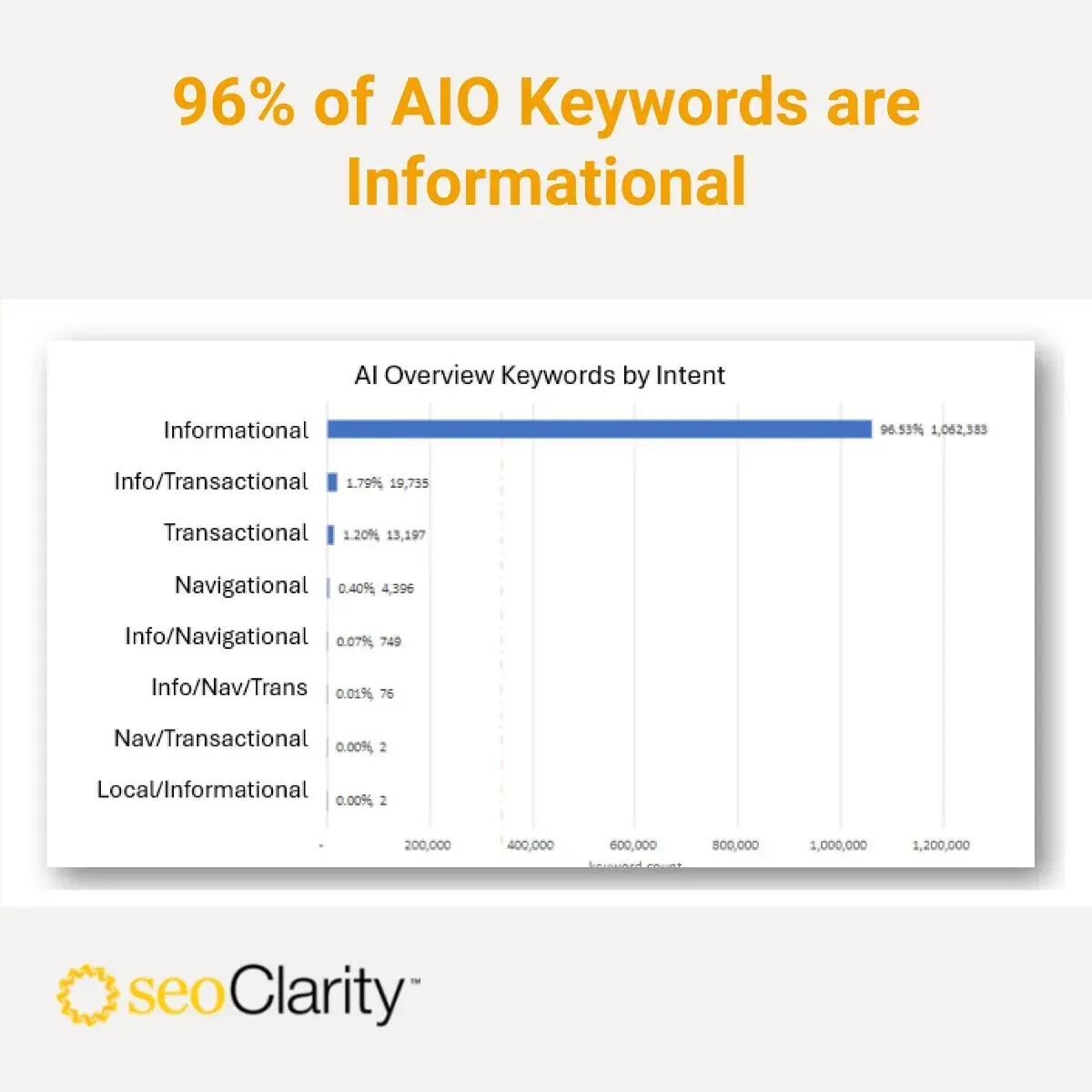
2. Navigational Intent
As the name implies, navigational intent refers to a user’s desire to locate a specific website, platform, or resource. For example, when someone searches for “nearest Starbucks” or “HubSpot free CRM,” they are not looking for general information or comparisons — they need direct access to that destination. This is why these searches often involve the brand or domain name.
In this case, AI’s role is to direct them effectively. AI systems, especially in search engines and chatbots, excel at identifying and addressing navigational intent by providing links or direct access to the requested service.
3. Transactional Intent
When a user intends to perform an action, such as making a purchase or booking a service, the AI system interprets the intent as transactional. For instance, when a user searches for “buy iPhone 15,” the system identifies the intent to purchase and can direct the user to relevant product pages or even go as far as helping the user initiate the buying process.
I find this particularly interesting as it has now given rise to concerns about an “intention economy,” as reported by The Guardian, where AI can now understand, forecast, and manipulate human intentions and sell that data to the highest bidders. The study suggests that “in an intention economy, an LLM could, at low cost, leverage a user’s cadence, politics, vocabulary, age, gender, preferences for sycophancy, and so on, in concert with brokered bids, to maximize the likelihood of achieving a given aim (e.g., to sell a film ticket).”
4. Support Intent
This type of AI intent is particularly relevant to AI customer service chatbots and help desks as it focuses on identifying users who seek assistance or solutions to problems.
User queries with support intent could look like any of these:
- When can I expect my order?
- How do I reset my password?
- Can you help me track my package?
- I can’t access my account. What should I do?
AI systems designed to recognize support intent provide timely, relevant responses to troubleshoot or guide users, thereby leading to increased customer satisfaction.
According to Kieran Flanagan, HubSpot’s SVP of Marketing, “In an AI world, support is live 24/7. And it probably has, over time, a better experience because an AI bot can have all of the information at once, where it’s really hard for an individual support agent to be able to have all of that information.”
Components of AI Intents
While the types of AI intent refer to the categories of goals or objectives that users aim to achieve when interacting with an AI system, the components of AI intent focus on the building blocks required to interpret and process that intent accurately. I like to think of the distinction this way: The types of AI intent describe the why, while its components describe the how.
The key components involved in identifying and processing AI intents include:
1. User Input (Query)
The process begins when the user issues a query, such as typing a question or speaking a command. This query acts as the starting point for everything that follows. The clearer the query, the easier it is for the system to figure out the user’s intent and deliver an accurate response.
2. Intent Classification
After receiving the query, the system determines its overarching purpose. Is the user seeking information (informational intent)? Are they trying to complete a specific action, like buying new headphones (transactional intent)? Do they need support in completing a process (support intent)? AI systems leverage natural language processing (NLP) techniques and pre-trained models to classify the intent and map it to a suitable response.
3. Context Awareness
Context awareness is another vital component of this process, allowing AI to factor in situational or historical information to refine its understanding. This “context” includes things like the time of day, location, or even past interactions with the system.
For example, if you ask to “book a table,” the system needs context to understand whether you mean a restaurant reservation or a meeting room. Without context, the system may misunderstand and give the wrong response. Using methods like contextual understanding and word sense disambiguation, therefore, ensures continuity and relevance in ongoing conversations, especially in multi-turn dialogues.
4. Entity Recognition
Entities are specific pieces of information within the user’s input that provide context to the intent. Unlike context, entity recognition does not rely on history or user-specific information. It focuses on extracting essential details from the query itself to generate a response.
For example, in the query “track my headphone order,” the entities here are “track,” “headphone” and “order,” and they allow the system to interpret the request and match it to the appropriate action without needing broader context or prior interaction.
5. Expressions
Also known as “utterances,” these are the various ways users may phrase their queries. It is normal for many expressions to convey the same intent but just be articulated differently. This is why AI models are typically trained on unique expressions relevant to the different intent categories to ensure they are able to understand and process user queries accurately.
As an example, user A may ask, “Where can I eat around here?” while user B simply inputs “nearest restaurant.” Despite the difference in phrasing, the intent — which is navigational in this instance — is identical.
AI Is the New Normal
In a world where customers prioritize convenience, speed, and uber personalization, interacting with an AI system that can nearly read your mind is no longer a nice to have. It’s an expectation.
As AI bots become more common in the customer experience, anything less will be a disappointment or a frustration, in my opinion. Businesses that are able to train their systems to meet those expectations will have many good stories to tell.
![]()
Level Up Your POS Experience — Here's What Experts Have to Say
The other day, the igniter in my oven needed replacing. I called a nearby electrician, who came over and told me how he could fix it. After agreeing to the initial quote, I instinctively had my checkbook out ready to pay the paper invoice. However, […]
ServiceThe other day, the igniter in my oven needed replacing. I called a nearby electrician, who came over and told me how he could fix it. After agreeing to the initial quote, I instinctively had my checkbook out ready to pay the paper invoice. However, the repairman said, “Don’t worry – our app will take care of this.”
Instead of sitting down for 30 minutes to review the paper invoice and pay, the app – or a point of sale (POS) system – cut the transaction time in half. Moreover, that electrician gained a loyal customer in me for finishing the job in record time.
In fact, digital payment is becoming so prominent that 90% of consumers have used some form of digital payment in 2023, according to McKinsey. Offering different payment options allows your company to reach more customers and simplify the payment transaction and customer experience.
Just like my example with the electrician, the POS experience is an important transactional moment for your customers. In this post, I’ll explain why, and then explore ways you can make your own POS experience better.
In this article:
Now, a POS system is what actually allows you to accept multiple forms of payment while connecting customer transactions to the back end of your business — thus creating your POS experience.
You can use your POS system to build revenue reports, transfer money to and from your bank account, check inventory, and track order history. A POS system can either be a hardware or software tool – making it flexible for use across multiple industries. It also collects data points centered around your buying preferences, order history, and frequency of purchases.
This versatility makes a POS system a vital conduit to influence a seamless POS experience.
Why is POS experience important?
A positive POS experience can bolster all of your interactions with your customers. Beyond the reports you can pull, a positive POS experience represents your company’s commitment to your customers.
This aligns with a trend – growth projections estimate the entire POS industry will be worth over $30 billion by 2032. This represents a huge opportunity for businesses to prioritize the investments they put in technology to engage with their customers and ensure they have a good experience.
But beyond the total addressable market, I’m going to review a few benefits that outline why the POS experience is worth placing importance on.
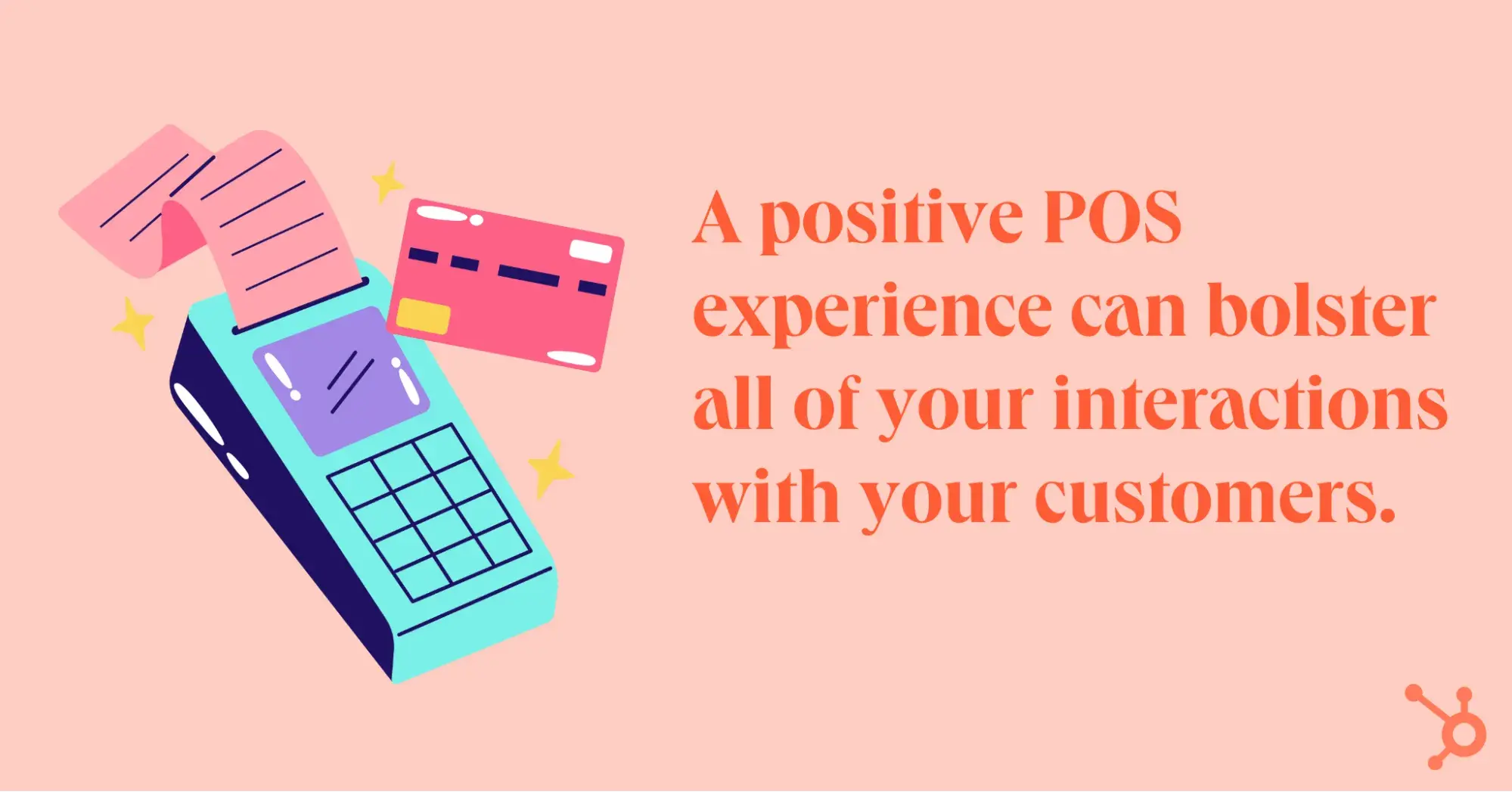
Satisfied Customers
A positive POS experience can create satisfied customers. A 2023 study from the Journal of Retail Technology Innovations noted an 18% increase in customer satisfaction when they used an effective POS system to enable a seamless checkout process.
Customers like it when your company’s POS enables them to purchase easily from your business. There’s also a benefit to logging your customers’ preferences, demographics, and other attributes for future interactions. Making it easy for your customers to interact with your business is one of several tips that defines a great customer experience.
Satisfied Employees
Your POS experience can influence more than just your customers. Your employee morale can be high when they know that the POS they work with daily is intuitive and causes minimal issues when working with customers. Happy employees mean that they are increasingly willing to work with customers, leading to higher rates of satisfaction and even revenue.
Prioritizing the POS experience is an opportunity for your company to invest time and resources in a particular tool. This tool needs to remove any blockers, make the checkout process seamless for employees, and reduce friction in the customer journey.
Repeat Purchases from Loyal Customers
A positive POS experience can influence your company’s ability to retain customers, influence future purchases, and garner customer loyalty. Customers are more willing to come back to you when they have a positive experience with your company. The POS acts as a key touchpoint for this positive experience to occur. Statistically, repeat customers spend 67% more than net new customers, consistently increasing your company’s overall revenue.
Your POS can also be the conduit to develop a customer loyalty program. POS systems can quantify the products and services customers have purchased, represent that in a membership program to monetize customer loyalty, and provide your marketing team content for promotional campaigns and further re-engagement ideas. If this is something you want to explore, grab this free guide that we at HubSpot put together with Calendly.
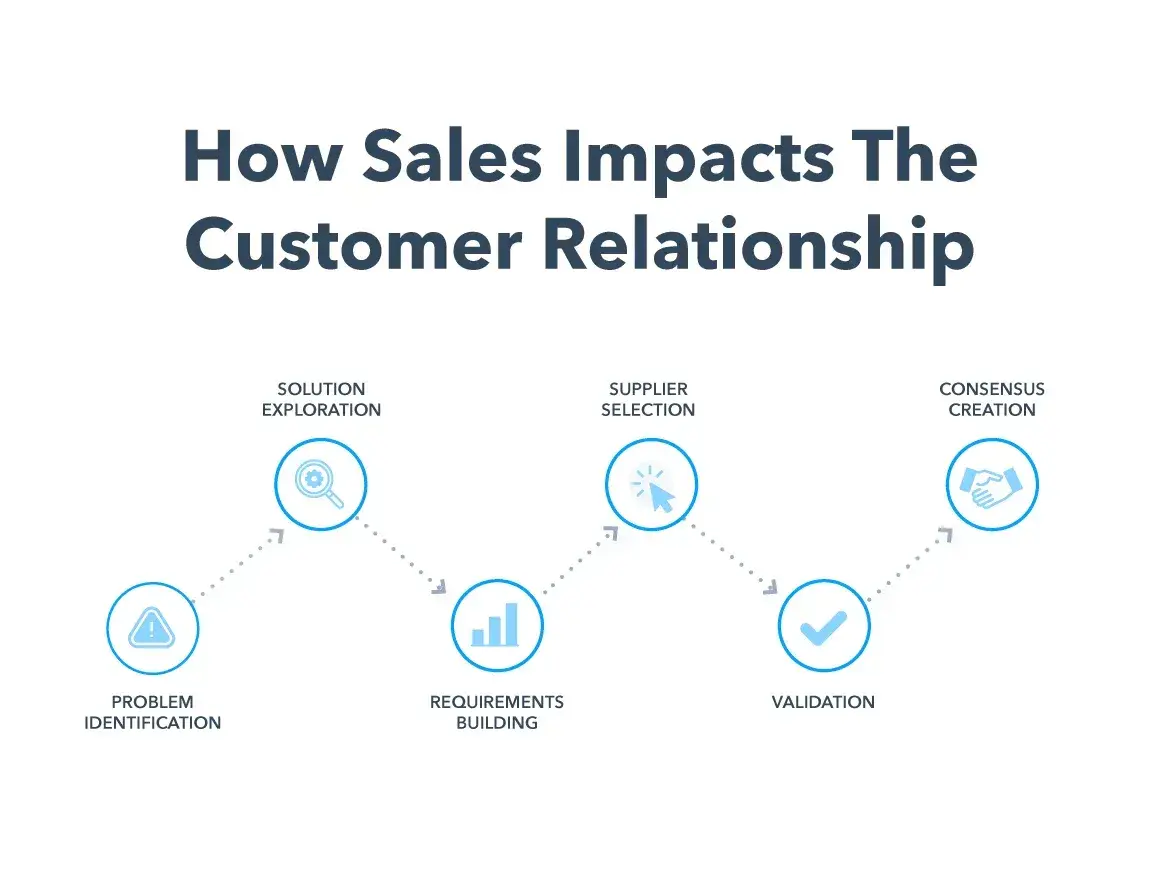
Six Ways to Improve POS Experience
As I have discussed above, the POS experience is a crucial touchpoint for creating satisfied customers and employees, and retaining customers to drive repeat business.
Now, how do you successfully improve your POS system and experience? Here are six actionable ways.
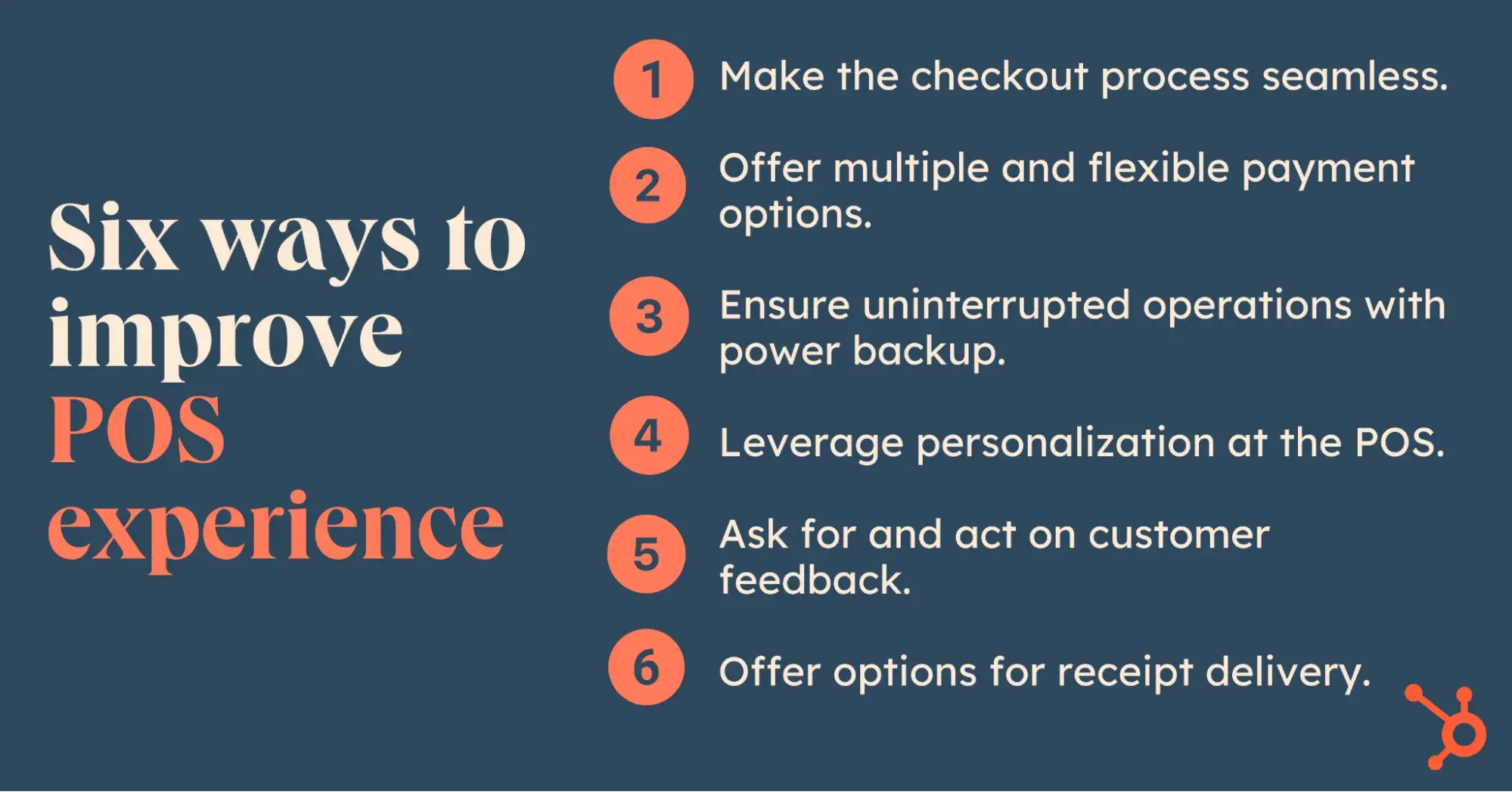
1. Make the checkout process seamless.
Simplifying the checkout process is key to delivering an effortless POS experience. By removing friction, you ensure your customers can quickly and easily complete their transactions, leaving them with a positive impression of your business.
Implementing features like barcode scanning, minimizing wait times, and providing clarity through the purchasing journey can all aid this.
2. Offer multiple and flexible payment options.
Today’s customers expect payment flexibility. Ensure your POS system accommodates various payment methods like credit cards, mobile payments like Google Pay and Apple Pay, and even installment plans using technologies like Affirm.
By offering these diverse payment options, you not only provide convenience but also capture revenue from customers who may prefer alternate methods.
Pro tip: Analyzing payment trends through your POS system can give you further insight into evolving customer preferences and help you refine your strategy.
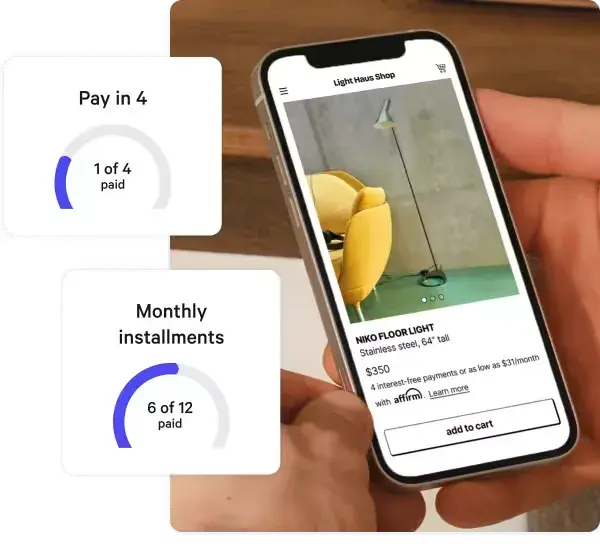
3. Ensure uninterrupted operations with power backup.
A reliable POS system should function seamlessly, even during internet outages. Look for systems with a robust offline capability to maintain consistent service. This lets your team remain productive and mobile, ensuring customers can complete transactions without a hitch.
Consistent performance under all conditions strengthens customer trust and protects your business from operational hiccups.
4. Leverage personalization at the POS.
Personalization is central to a superior POS experience. Use order history to suggest relevant products and services, tailor touchpoints based on preferences, and develop targeted customer touchpoints in loyalty programs. A well-optimized POS experience sees your team applying data you have collected from customers to inform customer interactions, turning one-time customers into repeat buyers and brand advocates.
5. Ask for and act on customer feedback.
Feedback is always a valuable resource for continuous improvement. Incorporate short surveys into your POS experience to gauge customer satisfaction.
One way I often see this done is to ask customers to rate their experience for that particular engagement or transaction. You can also leave space for customers to type in additional comments.
I recommend using this feedback to identify areas for improvement in your customer interactions. This can demonstrate your commitment to enhancing the POS experience. The HubSpot Blog has loads of resources on this, too — things like how to design a customer satisfaction survey, how to actually get customer feedback, and then what to do with it — so don’t sleep on this great way to improve your POS experience. Hearing directly from the people involved is a no-brainer.
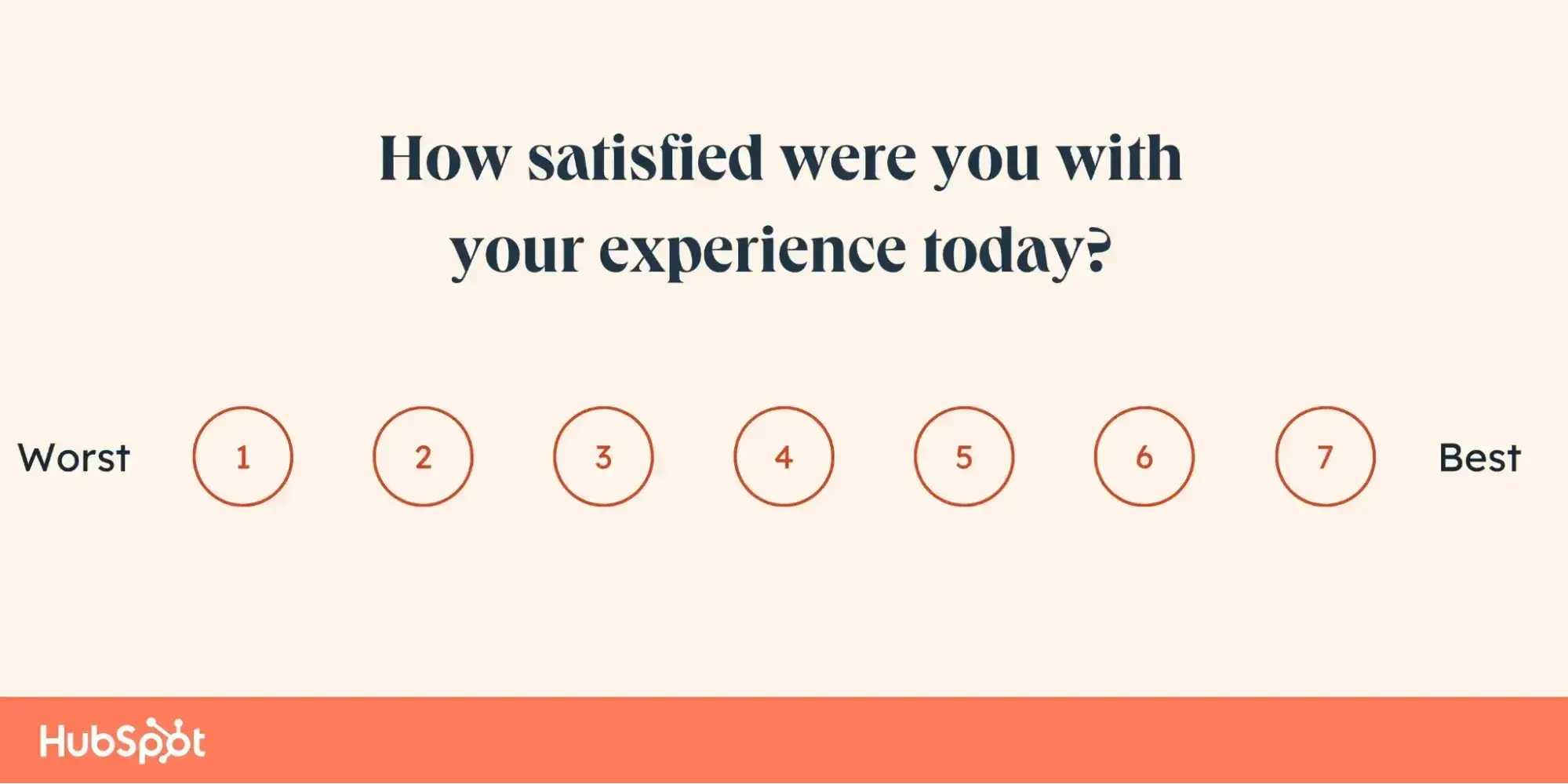
6. Offer options for receipt delivery.
Customers appreciate flexibility in how they receive receipts, just as they do with payment options. Whether it’s email, text, or a physical copy, offering multiple options aligns with modern and evolving customer expectations. Moreover, the method of receipt delivery adds another data point that allows you to personalize future interactions based on their preferences.
A positive POS experience can be your conduit to success.
I used the word conduit in this piece – a driver or channel – to describe POS systems. These are powerful tools that can be used to collect customer data points and measure their preferences against your company’s overall performance. Furthermore, an effective POS system can influence customer satisfaction, increase staff morale, and capture a consistent amount of revenue.
By implementing strategies to improve the POS experience, your business can ensure smoother transactions, generate happier interactions, and increase customer loyalty. Investing in your POS system is not merely a technical upgrade but a commitment to delivering superior customer experiences that set your business apart.
![]()
Level Up Your POS Experience — Here's What Experts Have to Say
The other day, the igniter in my oven needed replacing. I called a nearby electrician, who came over and told me how he could fix it. After agreeing to the initial quote, I instinctively had my checkbook out ready to pay the paper invoice. However, […]
ServiceThe other day, the igniter in my oven needed replacing. I called a nearby electrician, who came over and told me how he could fix it. After agreeing to the initial quote, I instinctively had my checkbook out ready to pay the paper invoice. However, the repairman said, “Don’t worry – our app will take care of this.”
Instead of sitting down for 30 minutes to review the paper invoice and pay, the app – or a point of sale (POS) system – cut the transaction time in half. Moreover, that electrician gained a loyal customer in me for finishing the job in record time.
In fact, digital payment is becoming so prominent that 90% of consumers have used some form of digital payment in 2023, according to McKinsey. Offering different payment options allows your company to reach more customers and simplify the payment transaction and customer experience.
Just like my example with the electrician, the POS experience is an important transactional moment for your customers. In this post, I’ll explain why, and then explore ways you can make your own POS experience better.
In this article:
Now, a POS system is what actually allows you to accept multiple forms of payment while connecting customer transactions to the back end of your business — thus creating your POS experience.
You can use your POS system to build revenue reports, transfer money to and from your bank account, check inventory, and track order history. A POS system can either be a hardware or software tool – making it flexible for use across multiple industries. It also collects data points centered around your buying preferences, order history, and frequency of purchases.
This versatility makes a POS system a vital conduit to influence a seamless POS experience.
Why is POS experience important?
A positive POS experience can bolster all of your interactions with your customers. Beyond the reports you can pull, a positive POS experience represents your company’s commitment to your customers.
This aligns with a trend – growth projections estimate the entire POS industry will be worth over $30 billion by 2032. This represents a huge opportunity for businesses to prioritize the investments they put in technology to engage with their customers and ensure they have a good experience.
But beyond the total addressable market, I’m going to review a few benefits that outline why the POS experience is worth placing importance on.

Satisfied Customers
A positive POS experience can create satisfied customers. A 2023 study from the Journal of Retail Technology Innovations noted an 18% increase in customer satisfaction when they used an effective POS system to enable a seamless checkout process.
Customers like it when your company’s POS enables them to purchase easily from your business. There’s also a benefit to logging your customers’ preferences, demographics, and other attributes for future interactions. Making it easy for your customers to interact with your business is one of several tips that defines a great customer experience.
Satisfied Employees
Your POS experience can influence more than just your customers. Your employee morale can be high when they know that the POS they work with daily is intuitive and causes minimal issues when working with customers. Happy employees mean that they are increasingly willing to work with customers, leading to higher rates of satisfaction and even revenue.
Prioritizing the POS experience is an opportunity for your company to invest time and resources in a particular tool. This tool needs to remove any blockers, make the checkout process seamless for employees, and reduce friction in the customer journey.
Repeat Purchases from Loyal Customers
A positive POS experience can influence your company’s ability to retain customers, influence future purchases, and garner customer loyalty. Customers are more willing to come back to you when they have a positive experience with your company. The POS acts as a key touchpoint for this positive experience to occur. Statistically, repeat customers spend 67% more than net new customers, consistently increasing your company’s overall revenue.
Your POS can also be the conduit to develop a customer loyalty program. POS systems can quantify the products and services customers have purchased, represent that in a membership program to monetize customer loyalty, and provide your marketing team content for promotional campaigns and further re-engagement ideas. If this is something you want to explore, grab this free guide that we at HubSpot put together with Calendly.

Six Ways to Improve POS Experience
As I have discussed above, the POS experience is a crucial touchpoint for creating satisfied customers and employees, and retaining customers to drive repeat business.
Now, how do you successfully improve your POS system and experience? Here are six actionable ways.

1. Make the checkout process seamless.
Simplifying the checkout process is key to delivering an effortless POS experience. By removing friction, you ensure your customers can quickly and easily complete their transactions, leaving them with a positive impression of your business.
Implementing features like barcode scanning, minimizing wait times, and providing clarity through the purchasing journey can all aid this.
2. Offer multiple and flexible payment options.
Today’s customers expect payment flexibility. Ensure your POS system accommodates various payment methods like credit cards, mobile payments like Google Pay and Apple Pay, and even installment plans using technologies like Affirm.
By offering these diverse payment options, you not only provide convenience but also capture revenue from customers who may prefer alternate methods.
Pro tip: Analyzing payment trends through your POS system can give you further insight into evolving customer preferences and help you refine your strategy.

3. Ensure uninterrupted operations with power backup.
A reliable POS system should function seamlessly, even during internet outages. Look for systems with a robust offline capability to maintain consistent service. This lets your team remain productive and mobile, ensuring customers can complete transactions without a hitch.
Consistent performance under all conditions strengthens customer trust and protects your business from operational hiccups.
4. Leverage personalization at the POS.
Personalization is central to a superior POS experience. Use order history to suggest relevant products and services, tailor touchpoints based on preferences, and develop targeted customer touchpoints in loyalty programs. A well-optimized POS experience sees your team applying data you have collected from customers to inform customer interactions, turning one-time customers into repeat buyers and brand advocates.
5. Ask for and act on customer feedback.
Feedback is always a valuable resource for continuous improvement. Incorporate short surveys into your POS experience to gauge customer satisfaction.
One way I often see this done is to ask customers to rate their experience for that particular engagement or transaction. You can also leave space for customers to type in additional comments.
I recommend using this feedback to identify areas for improvement in your customer interactions. This can demonstrate your commitment to enhancing the POS experience. The HubSpot Blog has loads of resources on this, too — things like how to design a customer satisfaction survey, how to actually get customer feedback, and then what to do with it — so don’t sleep on this great way to improve your POS experience. Hearing directly from the people involved is a no-brainer.

6. Offer options for receipt delivery.
Customers appreciate flexibility in how they receive receipts, just as they do with payment options. Whether it’s email, text, or a physical copy, offering multiple options aligns with modern and evolving customer expectations. Moreover, the method of receipt delivery adds another data point that allows you to personalize future interactions based on their preferences.
A positive POS experience can be your conduit to success.
I used the word conduit in this piece – a driver or channel – to describe POS systems. These are powerful tools that can be used to collect customer data points and measure their preferences against your company’s overall performance. Furthermore, an effective POS system can influence customer satisfaction, increase staff morale, and capture a consistent amount of revenue.
By implementing strategies to improve the POS experience, your business can ensure smoother transactions, generate happier interactions, and increase customer loyalty. Investing in your POS system is not merely a technical upgrade but a commitment to delivering superior customer experiences that set your business apart.
![]()
Training AI Chatbots — The Guide for Service Teams
Ever tried chatting with a bot that seemed more confused than helpful? I know I have, several times. And while it may seem like a good idea to take out the frustration on the poor bot — forgive me, AI — the problem is almost […]
ServiceEver tried chatting with a bot that seemed more confused than helpful? I know I have, several times. And while it may seem like a good idea to take out the frustration on the poor bot — forgive me, AI — the problem is almost never with the bot itself. AI chatbots, like human beings, are only as good as their training.
In our State of Service report, one recurring theme we heard from leaders was how the advent of the AI-powered chatbot transformed customer service. According to our data, AI chatbots have become so vital that they are now not only the most effective but also the most preferred customer service channel. But while they may be changing the customer service game, their (continued) success depends on how well they’re trained.
In this article, I’ll share insights I found on how to train AI chatbots effectively, ensuring they deliver seamless, human-like service experiences every time.
Table of Contents
- How AI Chatbots Help Service Teams
- How to Train Service Chatbots
- When to Get Your Tech Team Involved
- Tips for Training a Service Chatbot
- Building an AI Bot
How AI Chatbots Help Service Teams
AI chatbots are revolutionizing customer service. But how? What exactly do they do for the human agents already tasked with the responsibility of addressing the needs and concerns of the organization’s customers?
1. Respond to Questions and Inquiries 24/7
To borrow the words of Kieran Flanagan, HubSpot’s senior vice president of marketing, “In an AI world, support is live 24/7.” This couldn’t be more relevant in today’s always-online environment where customers expect immediate responses, whether it’s 3 p.m. or 3 a.m.
What this means is that if your company is setting up a pop-event with amazing offers and discounts and you’ve done all the hard work of attracting the customers, someone — something — is there to ensure that your business never sleeps, providing instant (and reliable) answers to customer inquiries around the clock.
2. Personalized Customer Interactions
Today, 78% of customers expect more personalization in interactions than ever before. They don’t want to be just another ticket in the queue — they want to feel seen, understood, and valued. I learned that this need is driving how businesses approach customer service, and AI chatbots are at the forefront of this shift.
Many Customer Relationship Management (CRM) leaders (86%) already confess that AI makes customer correspondence more personalized, especially as it can do things like analyze customer data to tailor responses and recommendations in real time. These are things a human agent may be unable to do, especially at scale.
3. Lead Qualification and Escalation
An AI system can handle hundreds or even thousands of support tickets per day compared to a human agent. Still, some requests are best handled by a human support agent.
In this case, the chatbot acts as a first line of engagement, ensuring only the most valuable or complex inquiries reach human reps. AI chatbots can also engage with potential customers, ask qualifying questions, and pass along valuable leads to human agents when necessary.
4. Collect Customer Feedback More Efficiently
Which would you respond to faster — a lengthy email with an embedded link asking you to please respond to a survey? Or a message that pops up right after your interaction, asking for quick feedback? Instead of relying on traditional, time-consuming methods like email surveys, I love how chatbots can seamlessly integrate feedback collection into the customer journey.
For instance, after completing a purchase or resolving a support issue, a chatbot can instantly prompt the customer with simple questions like, “How satisfied are you with our service today?” or “Is there anything you would like us to improve on?”
How to Train Service Chatbots
Now that it’s clear what service chatbots do, how do you train them to do these tasks well? Here’s what I found.
1. Clarify the goal of your service chatbot.
AI chatbots could serve service teams in many different ways. Therefore, the first step in the process is clearly defining what you want the chatbot to achieve. Do you want the chatbot to answer frequently asked questions (FAQs)? Process transactions? Help customers troubleshoot?
Remember that this is determined by your customers’ overarching needs. There is no need to build a chatbot that solves the wrong problems.
2. Gather relevant data.
Like I said earlier, your chatbot is only as good as the data it’s trained on. Start by compiling FAQs, past customer interactions, support scripts, conversations on social media, online reviews and other feedback data, live chat transcripts, conversations in online industry forums and communities, and even publicly available datasets relevant to your industry.
The chatbot can pull from this knowledge base during conversations with your customers.
3. Categorize the data.
Two key categories your data needs to be sorted into are intents and entities. Intents represent the specific goal a user wants to achieve when interacting with an AI system. This means that every user query falls into different intent categories.
For example, if a common need among your customers is tracking their package, you may organize that intent this way:
|
Intent Category + Name |
Possible User Queries |
|
Track order |
“Where is my order?” “Can you help me track my package?” “What is the status of my delivery?” “Has my order been shipped yet?” “When will my order arrive?” |
It’s not set in stone how many intent categories your service chatbot should have, but ideally, you should aim to cover the most frequent requests.
Entities, on the other hand, are specific pieces of information in the user’s input that provide context to the intent. Check for nouns or named objects within a query — often specifying people, organizations, locations, etc. — and you’ve found an entity. Extracting these entities helps the chatbot tailor each response to the specific needs of each user.
4. Design conversational flows and generate natural responses.
“Just like in any conversation flow design, it is important to know the persona of the customers, the domain of the expected question, goal of the chatbot, etc.,” Srinivas Njay, CEO of Interface.ai, shared in an interview with HubSpot.
During this stage, you map out the structure of interactions to ensure the chatbot can guide users effectively. This means anticipating user intents, designing logical pathways for different scenarios, and deciding when and how the chatbot should ask clarifying questions or redirect users to human agents.
Check out HubSpot’s AI Chatbot Builder
But just structure is not enough. Companies like Interface.ai, which have spent over a decade fine-tuning a library of conversation flows, emphasize the importance of combining structure interaction design with personalization.
“A combination of fine-tuned standard flows with personalization and recommendations makes the conversation very natural,” Njay continues. Using conversational language, adding some personality, and even incorporating some multimedia elements go a long way in making customers feel better supported during the entire process.
5. Test your service chatbot.
Testing is a critical part of training your AI service chatbot. Run it through a variety of scenarios to see how well it handles different intents and user queries.
During this stage, I suggest checking for metrics like accuracy, response time, how long it takes to complete a request/goal, relevance of the responses, and so on.
6. Monitor and update continuously.
“We collect detailed data on customer’s experience with our chatbots across our customer base and have created powerful analytics to track the performance of each engagement. This data includes customer feedback, transcript of the call, tone and emotions on the calls, type of intents, ability of the chatbot to answer all questions, and much more,” Njay offered when I asked how his company evaluates the performance of a chatbot they have deployed for a specific use case.
Constantly collecting, analyzing, and updating their system is how they make sure their chatbots are up-to-date with evolving customer needs and language patterns.
When to Get Your Tech Team Involved
While training a service chatbot may seem like a customer service initiative, the tech team plays a crucial role at various stages of the process.
1. Selecting a Platform and Integrating It
Choosing the right platform or chatbot service is a technical decision. I recommend your tech team helps evaluate and select the tools that align with your existing systems, such as CRM software, databases, and other APIs.
After selection, the tech team will also need to integrate the chatbot into the relevant platforms to ensure smooth data flow. Customers already using HubSpot’s CRM, for example, may find selecting HubSpot’s free AI Chatbot Builder more useful because it integrates directly with the CRM, allowing for streamlined data management and customer interactions.
2. Monitoring Performance and Optimizing the System
We’ve established that monitoring the performance of the chatbot and improving the system based on the feedback received is crucial. Whether it is tracking response times, ensuring uptime, handling any technical issues that arise, troubleshooting, or implementing improvements, this process is best handled by your tech team for optimum efficiency.
At Interface.ai, Njay says their “AI platform team is constantly collecting and analyzing the LLM and Execution Manager data and retraining the LLM to improve accuracy and performance and improving the conversation flows and transaction workflows.”
3. Ensuring Security and Privacy
A lot of data is exchanged throughout the customer journey, and technical expertise is required to ensure that the chatbot is not just compliant with relevant data protection regulations but also capable of safeguarding sensitive customer data during conversations.
Because Interface.ai deals mainly with financial institutions (FIs), securing authentication to ensure security and privacy could be a major challenge — one that only the tech team can mitigate. “Most customers contact FIs for banking transactions. Depending on the type of transaction, the customer needs to be authenticated with one or more factors.
“Using voice and device authentication can help make it easy for the customer to authenticate and also provide a very secure way to authenticate the out-of-the-wallet questions,” Njay comments. Additionally, they’ll also monitor the system for vulnerabilities to avoid breaches of any sort.
To gain your tech team’s support, don’t just stop at listing how AI chatbots can help the service team resolve more queries faster. I suggest involving them early in discussions to ensure they feel valued and heard in the decision-making process.
Keep the buzzwords and technical jargons aside, and use a common language of business objectives and business metrics. By positioning the project as a collaborative effort, you are more likely to get their full commitment.
Tips for Training a Service Chatbot
Njay graciously shared some tips with me for training a service chatbot, and I’d like to share them with you.
1. Streamline training with structured data.
The first tip Njay shares is to reduce the chatbot’s training needs. “Training the chatbot on full conversational input/output text is inefficient and requires a large data set for LLM to infer the underlying knowledge.”
Using a semantic knowledge graph tailored to your specific domain can simplify the training process and enhance the chatbot’s understanding. This reduces the volume of data needed and improves the chatbot’s accuracy in interpreting user queries.
2. Leverage domain-specific AI platforms.
Choosing an AI platform designed for your industry can significantly boost training efficiency. This is also relevant for automatic speech recognition (ASR) accuracy. According to Njay, “Choosing a vendor that supports a client-specific voice model, especially if your customer base has very specific regional dialects, is important.”
Because Interface.ai is designed for FIs and employs a Mixture of Experts (MoE) architecture with task-specific models, the chatbot’s performance in handling specialized financial/banking tasks is specifically improved.
3. Consider partnering with managed service providers.
“Choosing a vendor that provides managed service for chatbots eliminates the training needed for you, and training becomes the responsibility of the vendor.” Doing this, as Njay recommends, alleviates the burden of not just training but subsequent maintenance, allowing your team to focus on core business activities.
Building an AI Bot
If there’s one thing I’ve learned, it’s to start small and iterate. You don’t need to train your chatbot to do everything right away. Focus on a few key tasks that will make the biggest difference to your customers and team, test them out, and build from there. It’s like teaching a kid to ride a bike — you start with training wheels, and once they’re steady, you can take them off and watch them go!
Thankfully, tools like HubSpot’s free AI Chatbot Builder make the entire process seamless. Whether you’re new to chatbots or just looking to upgrade your current setup, this tool integrates with your CRM and helps you create a chatbot that’s smart, responsive, and totally on-brand. Plus, it’s free — so why not give it a shot?
![]()
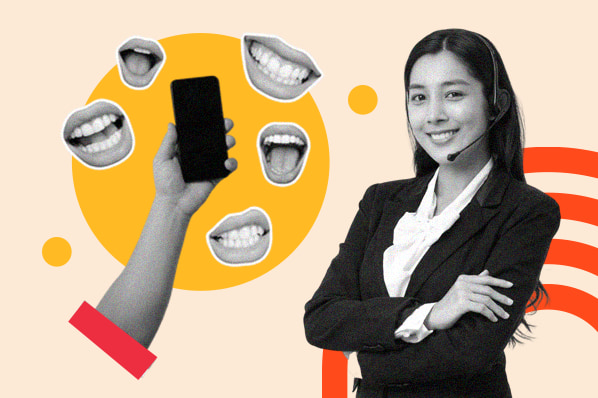
Top 12 Free Help Desk Software & Ticketing Systems
Help desk software was my daily command center when I worked at HubSpot Support. Our customer service ticketing system was the brain of daily operations for the support team and me as a whole. It was central to my workflow and experience as a support […]
ServiceHelp desk software was my daily command center when I worked at HubSpot Support. Our customer service ticketing system was the brain of daily operations for the support team and me as a whole. It was central to my workflow and experience as a support rep, and I can’t understate its impact on my ability to solve for the customer.
Without a proper ticketing system or help desk solution, scaling and maintaining a customer service team is nearly impossible. In my opinion, choosing the right help desk solution is just as critical as hiring the right people.
Are you looking for the right help desk software for your team? I’ve got you covered. In this article, I’ve compiled 12 of my favorite help desk solutions to help you make the right choice. But before we get there, let’s talk about what a help desk is, how to choose one, and why you should use one.
Table of Contents
- Help Desk Software Features
- The Top Free Help Desk Software
- What is a help desk?
- Benefits of Free IT Ticketing Systems
- How to Choose the Right Support Ticketing Tool
- How I Chose the Best Help Desk Software
- Find the Right Help Desk Software for Your Team
What is a help desk?
A help desk distributes incoming service requests to support team members and helps them manage follow-up communication on long-term cases.
Help desks come with several valuable features, such as:
Knowledge Base
A knowledge base is a self-serve library of information that helps customers find answers to troubleshoot problems without contacting a customer service rep. 79% of businesses offer a knowledge base to help customers independently solve their issues.
We have a perfect one here at HubSpot, and several of my colleagues contributed to it. We also had an “internal knowledge base” private to HubSpot support reps, which was invaluable in answering employee questions.
Whether internal or external, most knowledge bases include the following:
- Directions and tips for using your products and services.
- Answers to FAQs.
- Content you’ve created that can provide in-depth solutions.
- Video demonstrations.
- Company information.
- Info on different business departments.
Ticket Management
Ticket management streamlines customer support requests. This feature lets you receive and assign tickets, track their progress, and escalate issues when necessary. You can also organize tickets based on priority, status, and severity, shortening your response time for time-sensitive matters.
At HubSpot, our ticket management system prioritized tickets that had been in the queue the longest. These tickets were assigned to reps first unless there was a critical situation where we needed to act on other cases immediately.
Ticket Automation
A customer support rep handles an average of 21 tickets per day. Ticket automation allows you to set up triggers and rules that automatically assign tickets, send notifications, and perform other actions based on specific conditions.
This allows you to streamline your workflow and focus on higher-value tasks, and it can also provide customers with a better frontline experience.
Ticket Escalation
Ticket escalation is the process of moving a customer support ticket from an initial representative who isn’t able to resolve the issue to a higher-level rep or manager. Help desk software can help with this process by ensuring high-priority problems get the attention they deserve.
For instance, you can set up automations that prioritize high-severity tickets and route technical issues to more senior representatives. At HubSpot, we would route questions related to payment services to our billing department since they were more equipped to handle these issues.
Ticket Distribution
56% of customers say they have to repeat themselves when they’re handed off to a more experienced rep. Ticket distribution helps get a ticket to the most appropriate service rep the first time. In my opinion, ticket distribution is the foundation of any help desk.
This feature automatically routes tickets to the appropriate rep based on their skill set, availability, and/or workload. Managers can also use ticketing software to monitor ticket distribution, reallocate tickets when necessary, and maintain a balanced workload across their teams.
Multiple Contact Options
Help desk software gives customers options when contacting your business. These options range from traditional phone and email support to live chat and conversational bots.
Reps don’t have to specialize in one channel, either. When I worked in support, I received tickets from social media, live chat, and email, all in one inbox. The outgoing messages appeared to be coming from the same channel the customer contacted.
Having multiple communication channels available to your customers will help you effectively meet their needs and increase their overall satisfaction.
Customer Support Analytics
Customer support analytics provide valuable insights into your customer service efforts — they also let you know as a rep whether or not you’re having a good day.
These features track performance metrics, such as knowledge base usage, ticket volumes, response times, customer feedback, etc. This information can be used to improve support processes and identify areas where additional service resources are needed.
If these features aren‘t enough, let’s discuss some valuable returns from adopting this software.
Benefits of Free IT Ticketing Systems
1. They efficiently manage support requests.
75% of CRM leaders say they’re receiving more support requests than ever, which makes a support ticketing system necessary.
With ticketing systems, your team can manage support requests much more efficiently than you would if you did everything manually. It allows you to receive, track, and assign tickets to individual contributors or groups in one centralized place, ensuring that each request is addressed promptly.
Help desk software automates tedious processes like ticket routing, escalation, task creation, and customer marketing emails. In my experience, this reduces time spent handling routine tasks and gives you more time to focus on deeper, more complex problems.
2. They increase the bandwidth of your support team.
92% of CRM leaders say AI has improved their customer service response time. Since these systems simplify the organization and management of support requests, your team will have more bandwidth to serve a higher volume of customers in less time.
Additionally, because they allow you to automate many routine tasks, there’s more room to work on new strategies and projects.
A good example? Yours truly. I used my free time to write about customer service. Not only did I parlay that into a career, I generated free marketing content for HubSpot while working in customer support.
3. They improve customer satisfaction.
A free IT ticketing system can help improve customer satisfaction by streamlining your company’s support process and handling customer issues promptly. Because of the multiple contact options, such as chatbots and live chats, customers have more tools to communicate with support staff about their needs.
78% of customer support leaders say their customers prefer to solve issues independently. Self-service options, like knowledge bases, help customers find solutions to problems independently, reducing the need to contact support staff.
4. They save your company money.
The average customer support professional uses four separate tools to support their role. A subscription to each of these tools adds up quickly. Support ticketing systems often combine the tools into one platform.
While free IT ticketing systems may not have all the bells and whistles of a premium version, they will get the job done in a pinch and save you money while you figure out which system is best for your company.
Premium and enterprise-level help desks have additional features to improve your customer experience, although these systems can be pricey. A paid version may not be possible or advantageous for businesses working within a tight budget.
Before you even begin shopping for a customer support tool, you need a plan. Check out this free customer support strategy template to get started.
Ready to start shopping for your ticketing system? Let’s take a look at some of the top help desk software and ticketing systems your team can start using for free.
1. HubSpot Help Desk
Start using HubSpot’s Free Help Desk and Ticketing software.
HubSpot’s Free Help Desk and Ticketing Software is a unified help desk dashboard where all customer requests are stored so your entire team can easily track, prioritize, and manage them.
Staying organized becomes more challenging as you scale your business, making it more challenging to give each customer issue the attention it deserves. HubSpot allows you to monitor each issue and efficiently resolve it.
Key Features
- AI-powered efficiency: Built-in AI powers automatic recommendations, and AI assistant features encourage rep efficiency at every click.
- Personalized support: HubSpot Help Desk integrates with your marketing and sales data to provide personalized support with unified customer insights built into every interaction.
- Ticket automation and routing: Tickets are automatically assigned to the appropriate rep using skill-based assignment and intelligent routing.
- Unified analytics: Gain full visibility into customer metrics to understand recurring issues and keep a pulse on customer health.
Pros
- Seamless integration with HubSpot CRM: Directly connects with HubSpot CRM to eliminate data silos and bring clarity across your organization.
- Automation features: Not always available in free products, but we’ve got them!
- Scalability: HubSpot is equipped to handle your business needs across all departments as you grow, unifying Sales, Service, Marketing, Operations, and more.
Cons
- Limited seats: You’ll need to upgrade or purchase additional seats.
- Limited email templates: Limited to five email templates at the free level.
Best for: Businesses of all sizes looking to unify information across all internal teams, especially those already using HubSpot CRM.
What I like: I love HubSpot because it unifies all of your customer data so that you can provide a 360-degree customer experience. When I use HubSpot, I have complete visibility into a customer’s history, past tickets, and which representative they have worked with before. Armed with a full customer timeline, I can provide personalized, empathetic support and fully understand the customer’s needs and challenges.
HubSpot’s Help Desk and Ticketing software are just pieces of the puzzle. You can also use its all-in-one customer service software to streamline all your service efforts from the same place. For example, you can gauge your team’s performance by monitoring metrics like average response times and close times. You can also deploy and manage feedback surveys and more.
Pro tip: Use HubSpot’s Help Desk software to track all customer requests, manage tickets, and prioritize and distribute work among reps.
Pricing: You can get started with HubSpot’s Help Desk for free. For more functionality, consider upgrading to the Service Hub Professional tier for $90 a month per seat.
2. Zoho Desk
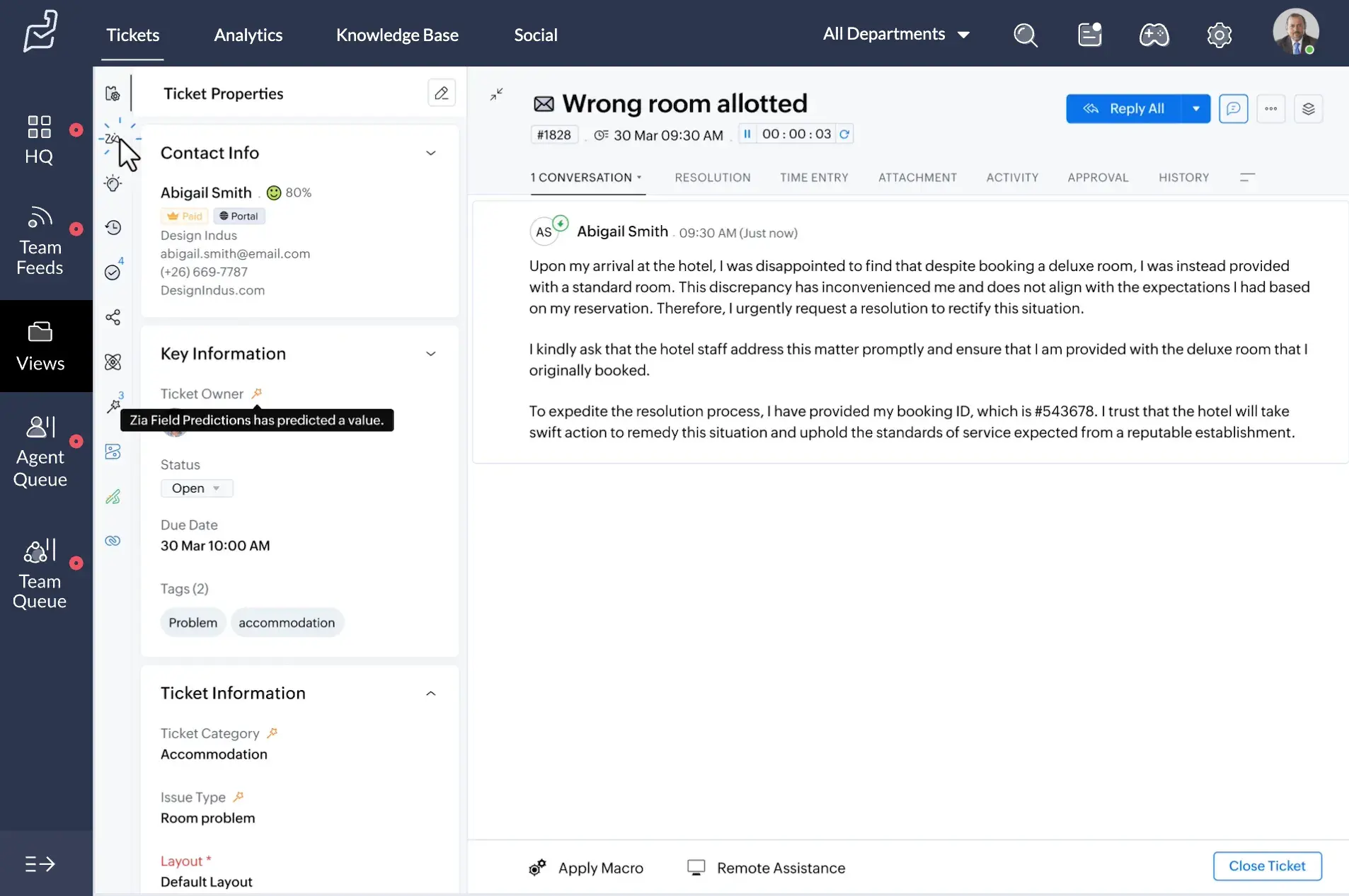
Zoho Desk is a multi-channel help desk ticketing system designed to help businesses manage customer service operations efficiently. It handles incoming service cases via phone, web, email, chat, and social media, making for an omnichannel experience.
Key Features
- Ticket management: Manage, organize, and track incoming support tickets.
- Multi-channel support: Centralized email, social media, and web forms.
- Knowledge base: Maintain a self-service hub so customers can answer questions independently.
- Mobile app: Stay on top of tickets on the go with the Zoho Desk mobile app.
- Contextual AI: Zoho’s Zia quickly answers customer queries, identifies and tags support tickets, and detects anomalies and unusual ticket activity.
- Automation: Automate ticket assignments, escalations, and workflows.
- Integration: Connect Zoho Desk with other software or embed applications and widgets.
Pros
- Search functionality: Simple, attractive, and intuitive to use.
- AI tools: Generates responses, monitors data, and detects unusual activity.
- Multi-channel support: Handle tickets from email, social media, and web forms.
Cons
- Steep learning curve
- AI tools: Requires your own ChatGPT API.
- Reporting and analytics: Reports can be a bit complex.
Best for: Small businesses, startups, or freelancers seeking a cost-effective help desk system chocked full of features to manage customer queries and tickets on a small scale.
What I like: Zoho Desk offers a widget tool that you can embed on your website. When loaded in a browser, the widget turns into a support form that customers can fill out to request assistance. They can describe their problem in detail and request a preferred communication channel.
This makes it simple for customers to access your support team. It also allows reps to analyze and find solutions for incoming requests easily, significantly improving first-call resolution rates and customer satisfaction.
I also like their time-tracking feature, which records how much time you spend doing different things on each ticket. This gives you more insight into the hurdles a rep has to overcome to solve a specific issue.
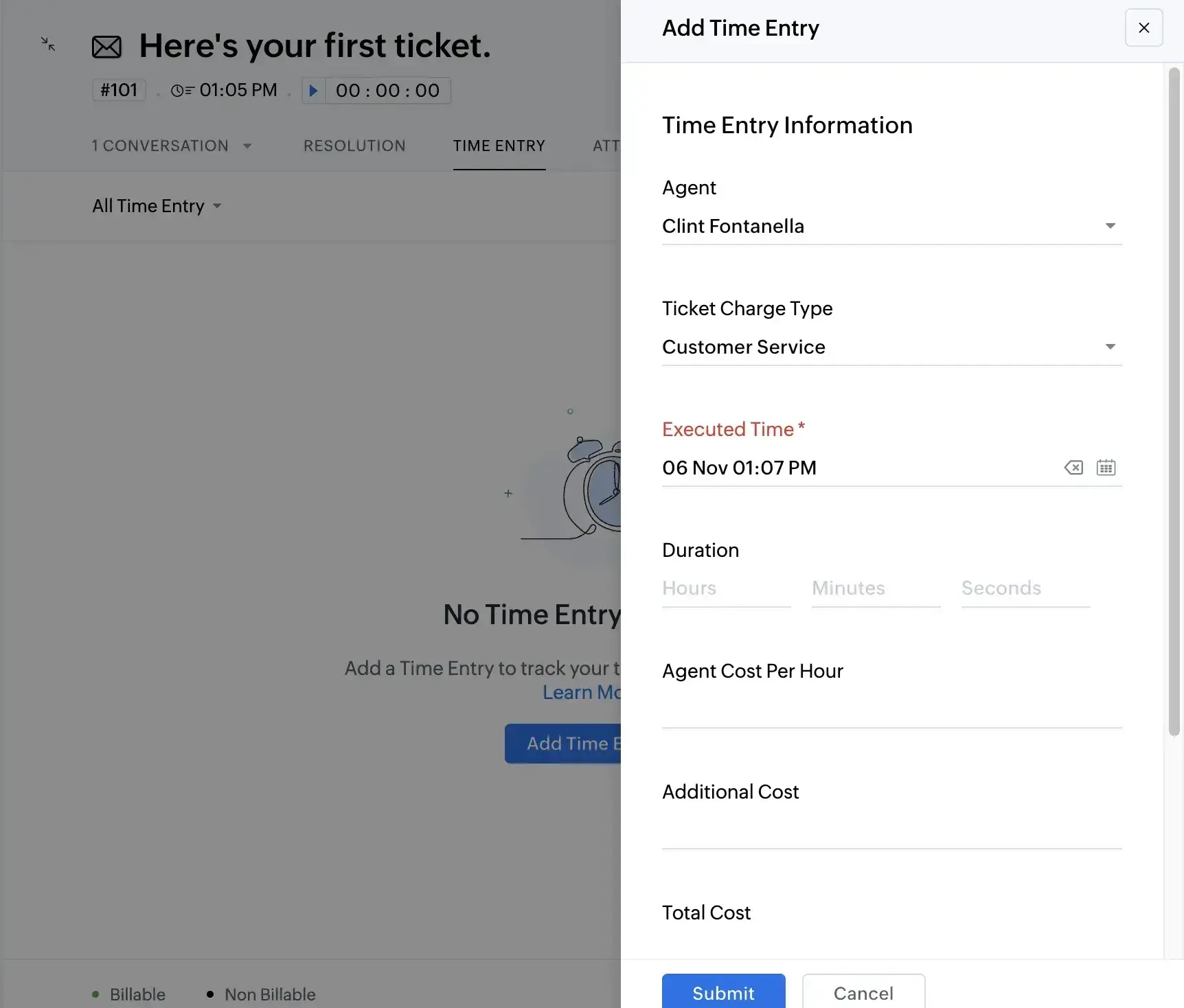
Pricing: You can sign up for a free 15-day trial of Zoho Desk. After your trial, you’ll need to upgrade to a paid plan. Paid plans start at $7 a month for the Express tier and increase to $40 a month for enterprise-level users.
3. Groove
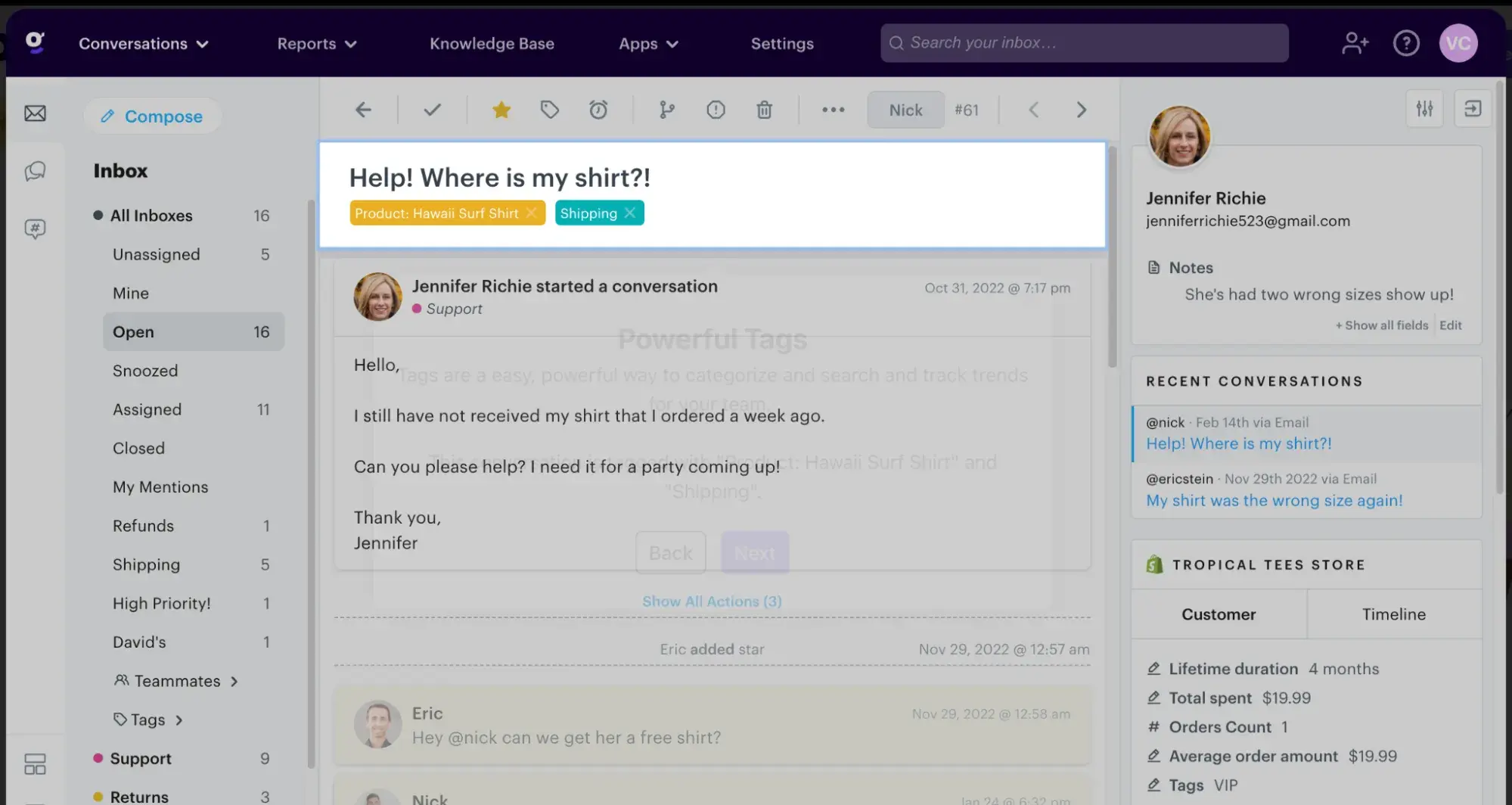
Of all the options I tested, Groove is one of the simplest and most cost-effective cloud-based help desk software solutions for small businesses. It helps companies personalize their communication with their customers via email, live chat, social media, and phone calls.
Over 10,000 users trust Groove as a simple yet powerful Zendesk and Freshdesk alternative. According to them, Groove’s help desk is easier to use, quicker to set up, and provides a much better customer experience.
Key Features
- Shared inbox: Organize your messaging channels, including email and Slack, to streamline and align ticketing support.
- Self-service knowledge base: Create a branded knowledge base paired with analytics to help track performance metrics.
- Live chat: Chat with your customers across your app or website, or enable automation to collect customer information in the off hours.
- Reporting and analytics: Understand your customer satisfaction rates, conversions, and conversations.
Pros
- User-friendly interface: Simple, attractive, and intuitive to use.
- Collaboration tools: Enable support teams to work together effectively.
- Multi-channel support: Handle tickets from email, social media, and web forms.
Cons
- Limited shared inboxes: Only two shared inboxes are allowed at the lowest tier.
- No AI features at lowest tier: Must upgrade to Plus or Pro for AI features.
- Basic reporting: Limited reporting capabilities at the lowest tier.
Best for: Small and growing businesses looking to personalize their support ticketing and customer interactions.
What I like: Groove felt like a more cost-effective and feature-rich alternative to companies like Zendesk and Freshdesk. During my 7-day free trial, I liked using the “instant replies” feature, which produced canned responses to recurring problems. Even more impressive, you could trigger follow-up actions within the help desk after sending the canned response.
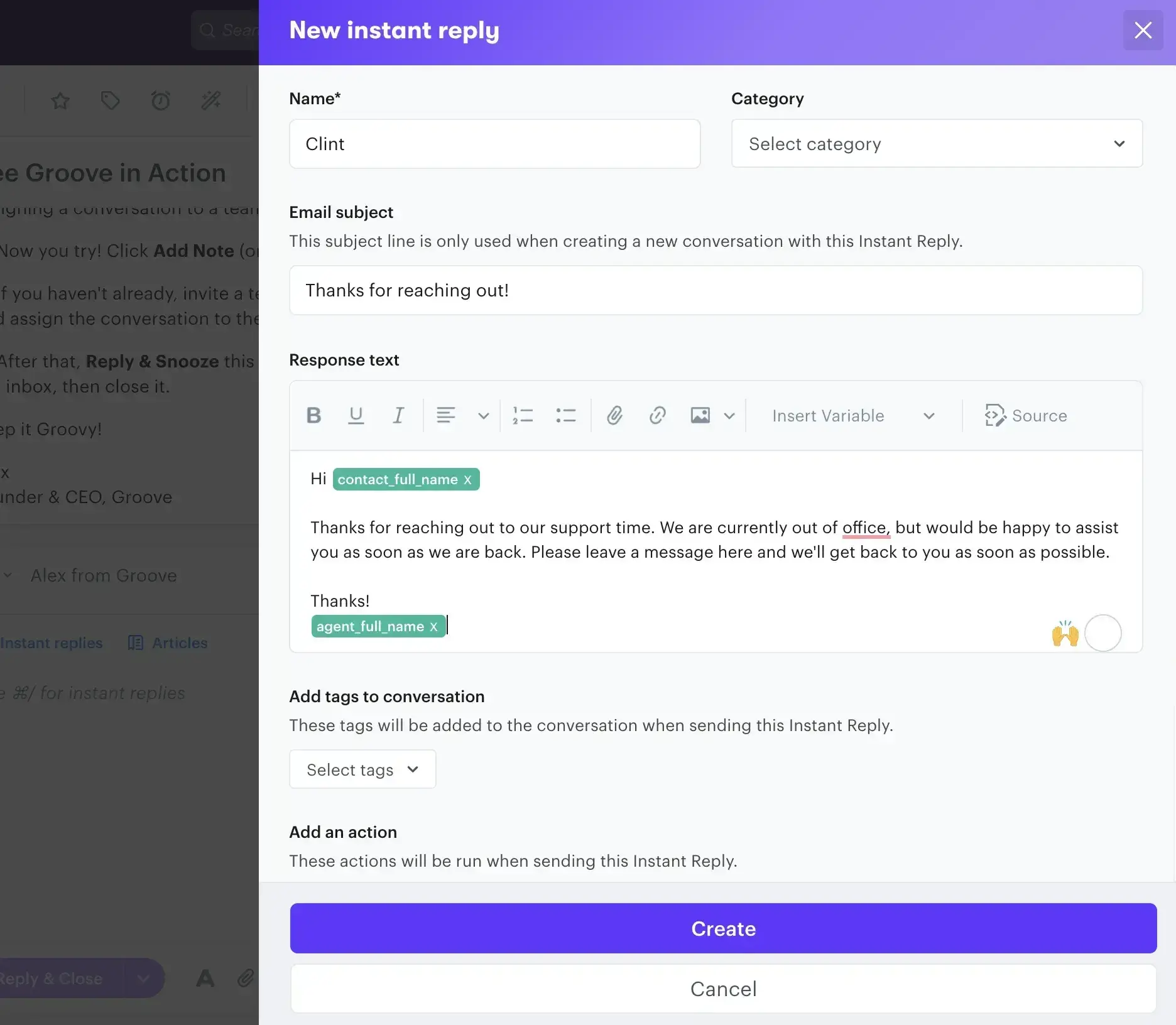
Groove’s help desk software allows companies to accept, track, and respond to support requests in an organized fashion with ticketing, live chat, knowledge base, self-service portals, SLO management, multiple mailboxes, task management, and reporting.
Pricing: You can try Groove free for 90 days. After your trial, you’ll need a subscription. Subscriptions start at $24 a month for the Standard tier, which allows for up to 25 users and two shared inboxes.
4. Spiceworks
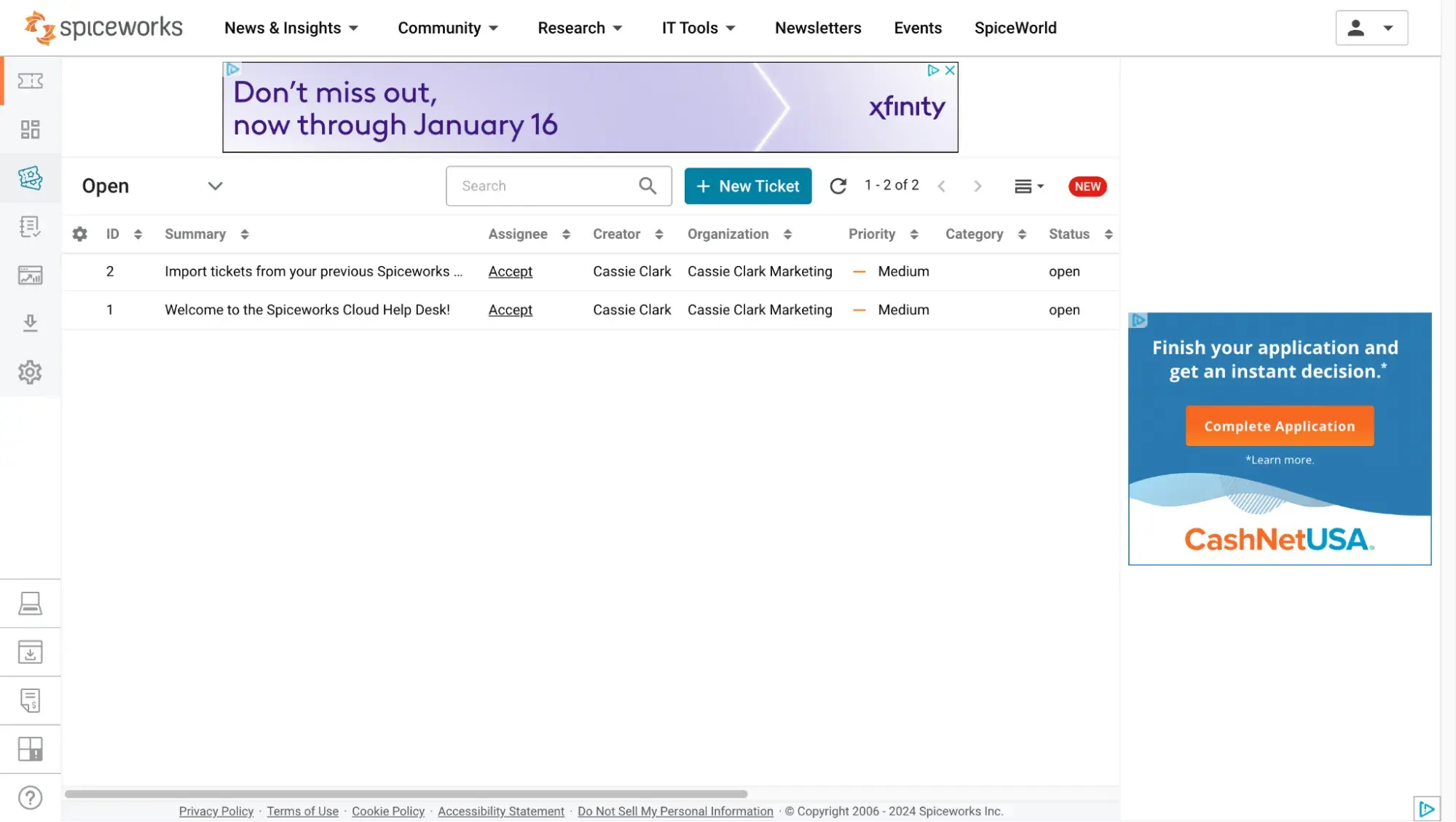
Spiceworks is a ticketing system that helps businesses manage both internal and customer-facing tasks. The software is all online in a cloud, so there’s no hassle in getting it set up and maintaining it. Once I signed up, I was immediately redirected to my inbox, where I could start answering mock tickets.
Best of all, Spiceworks is free without limits on tickets, devices, or agent access. So, it’s not a bad option if you just want to explore the basic features of a help desk.
Key Features
- Ticket management: Manage tickets from a shared inbox.
- IT asset management: Keep track of internal IT resources like company laptops.
- Customizable self-service portal: Unified portal for users to submit tickets and view resources.
- Advanced reporting: Create filters to quickly access open or pending tickets.
Pros
- Completely free with no upcharge.
- No user limits.
- Free mobile app.
Cons
- Basic interface: Less attractive than other paid options.
- Banner ads: It’s gotta be free somehow!
- Limited support options: Community support is your only option if you need help with the software.
Best for: IT departments and small businesses who do not mind a scaled-down system if it saves them money.
What I like: Because Spiceworks is a cloud-based help desk, I could log in from any web browser and get to work. It also offers a help desk mobile app that keeps you updated on all your tickets. It is not that anyone wants to work outside of office hours, but it does give you the option to respond to customers in a pinch if needed.
Spiceworks also offers an inventory management integration that can help your team oversee product orders that are in progress. It uses an IP scanner to locate orders and notify you of their progress. As a rep, I can then proactively relay that information to the customer so they know of any delays with their delivery.
Pricing: Free.
5. Keeping
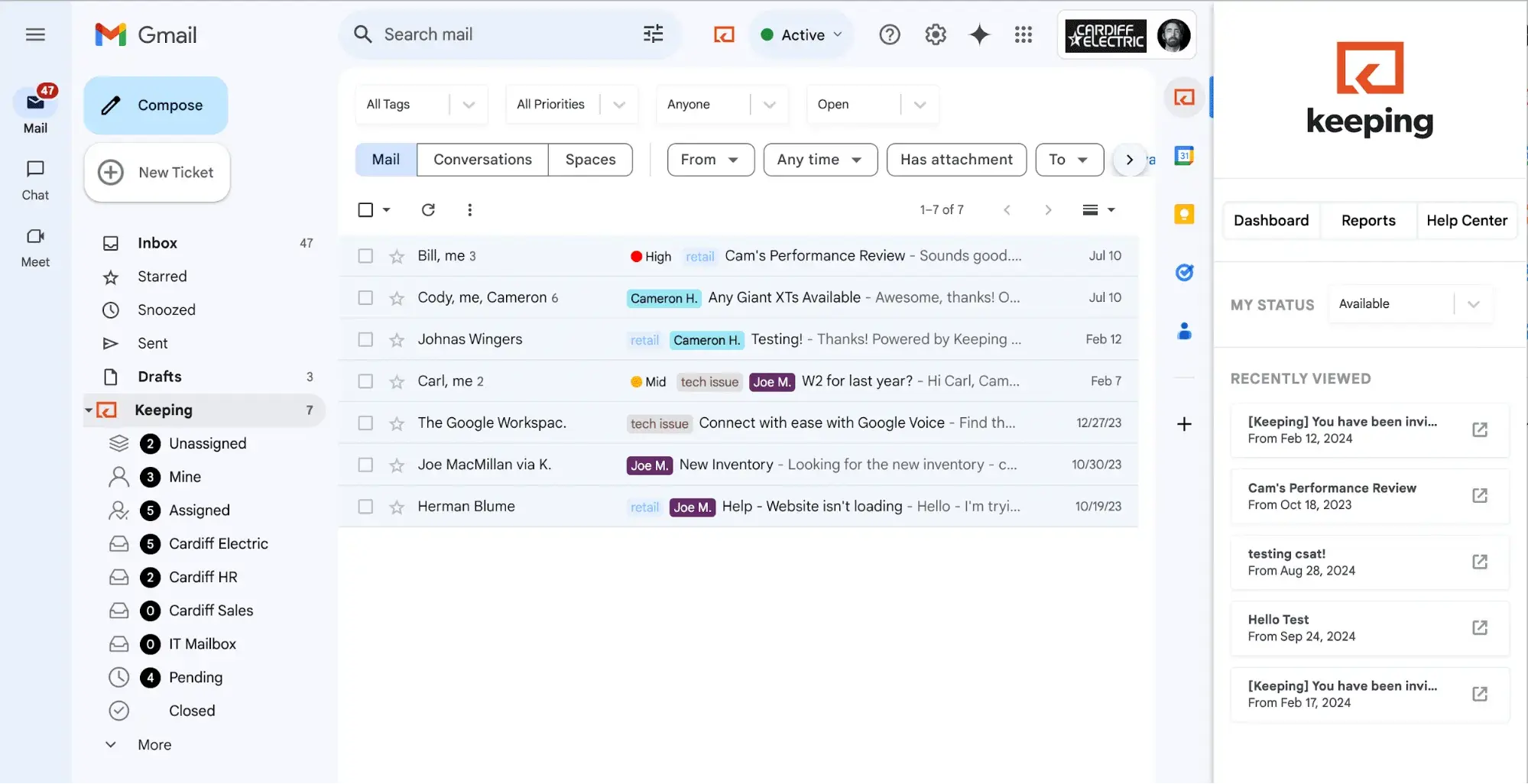
Of all the options I tested, Keeping is one of the simplest and most cost-effective Gmail-based help desk solutions for small businesses. It transforms your Gmail inbox into a shared help desk, allowing companies to manage customer support directly from their familiar email interface.
Many users trust Keeping as a simple yet powerful alternative to traditional help desk software like Zendesk and Freshdesk. According to them, Keeping’s help desk is easier to use, quicker to set up, and provides a much better customer experience by eliminating the need to switch between platforms.
Key Features
- Gmail collaboration: Team members can access support tickets from a designated tab in their Gmail account. Keeping prevents duplicate work by locking tickets when an agent is working on it.
- Streamlined integration: Set up your Keeping account in less than ten minutes, including connecting your team members to the shared inbox.
- Shared notes: Maintain a ticketing record system to keep your team on the same page.
- Automation and canned responses: Keeping’s AI detects support messages, like a thank you from a customer, that do not require a response.
- Round-robin assignment: evenly distribute support tickets across your team.
- Analytics and metrics: Identify areas of performance improvements and analyze key metrics, like email volume, response time, and resolution time.
Pros
- User-friendly interface: Familiar Gmail environment reduces the learning curve.
- Easy setup: Very quick and easy to set up and try with their free trial.
- Affordable pricing: Cost-effective solution for small teams.
Cons
- Limited to Gmail users: Only works with Gmail and Google Workspace.
- No multi-channel support: Does not support channels like social media or live chat.
- Advanced features require higher tiers: Some features are only available in premium plans.
Best for: All departments who use Gmail, including HR, IT, and Finance. It also integrates with Shopify, making e-commerce support in Gmail easier.
What I like: Keeping felt like a more cost-effective and user-friendly alternative to companies like Zendesk and Freshdesk, especially for teams already using Gmail. During my free trial, I appreciated the seamless integration and the ability to manage support tickets without leaving my inbox. The automation features, like canned responses, significantly improved response times.
Pricing:
Keeping offers a 14-day free trial. Small teams who need just two workflows can subscribe to Keeping for $12 a month per user. Larger organizations with more than 10 users can subscribe to Keeping for $49 per month per user.
6. Help Scout

Help Scout is a ticketing system that puts the customer first. With a simple interface, the software is easy for reps and customers alike to navigate while offering excellent features such as a shared inbox, omnichannel support, live chat, automation, and a mobile app.
Although Help Scout does not offer a 100% free plan, it does offer a 15-day free trial to test the software. No credit card is required; just click it to get started.
Key Features
- Multi-channel inbox: Combine your email, social, live chat, and voice mailboxes into one streamlined interface.
- AI tools: For improving replies and summarizing conversations.
- Analytics and reporting: Access and analyze data like customer satisfaction rates, wait and response times, chat duration, and social media support metrics.
- Integration options: Such as Jira, Salesforce, Slack, Trello, and HubSpot.
- Self-service portal: Customizable to the look and feel of your brand.
Pros
- User-friendly: This is one of the more attractive and intuitive interfaces I’ve encountered.
- Collaboration tools: It’s simple to loop in other agents directly on a ticket.
- Multi-channel support: Including email and live chat in a unified interface.
Cons
- Limited AI features: If you’re starting with the lowest tier.
- Storage limitations: Limited storage for attachments and data at the lowest tier.
- Basic reporting capabilities: Must upgrade to higher tiers for advanced reporting.
Best for: Startups, small businesses, or any company looking for a user-friendly interface.
What I like: Creating a chatbot on Help Scout was straightforward. In fact, it was one of the first things I did in the setup guide. I like chatbots because they are a reliable communication channel that customers can access around the clock.
Help Scout also has cloud-based features that small companies love, such as a shared inbox and knowledge center capabilities. In addition, every pricing level comes with the ability to embed help widgets on your website that you can set to fire on specific pages. In the world of many alternatives, Help Scout stands out for its simplicity and ease of use.
Pricing: If you have a small client base of 50 customers or less, you can use Help Scout for free. Or, if you have 100 or more contacts, you can try a free trial of Help Scout’s Standard subscription. Once your trial ends, you’ll pay $50 a month for your subscription.
7. Hesk
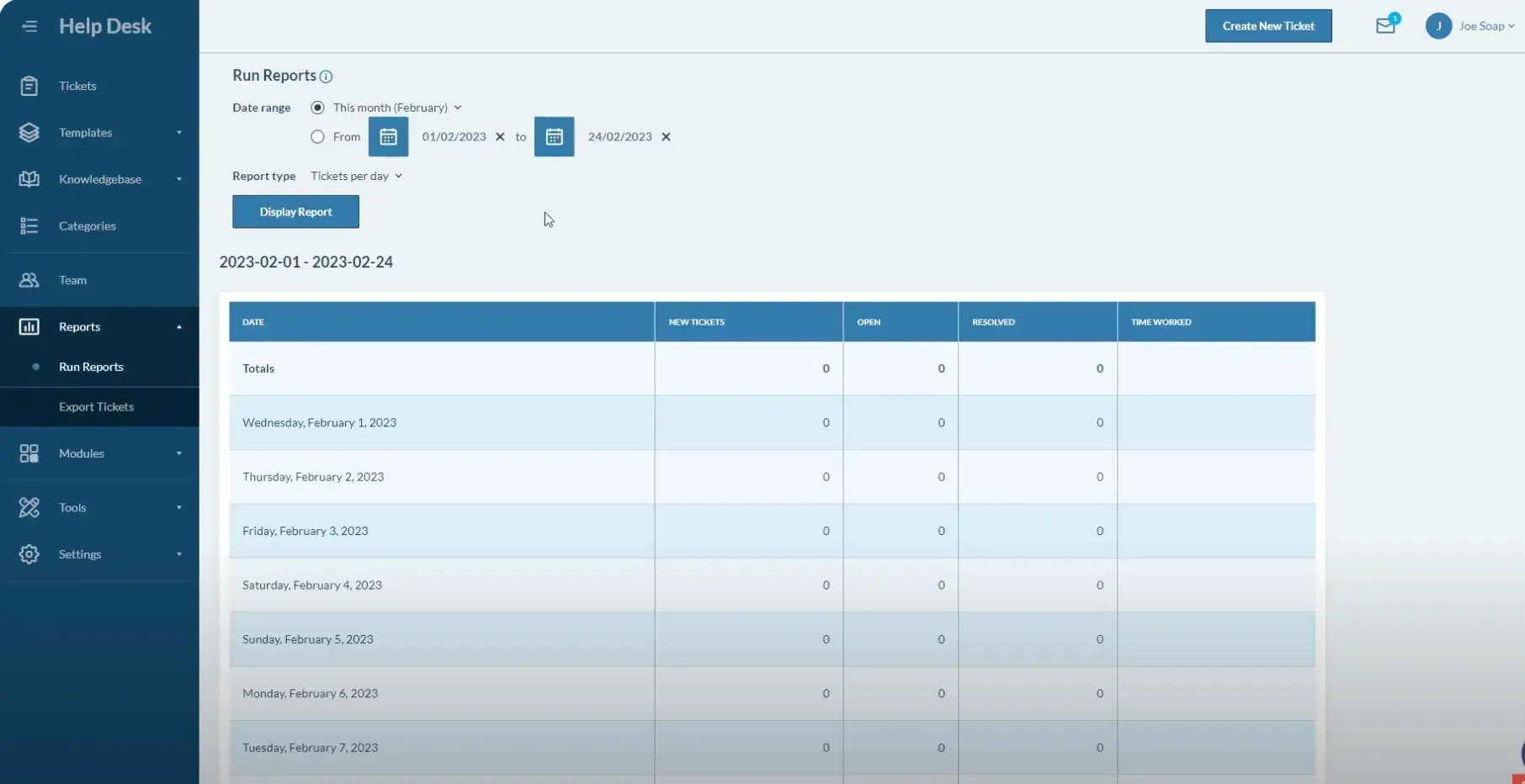
Hesk is a minimal but effective helpdesk ticketing system that is completely free. I played around with the demo version for a while, and I was impressed with it, considering its non-existent price tag. The interface reminded me a little bit of the backend of a WordPress website, which was welcoming and familiar, albeit not incredibly sleek. The system was intuitive, and there were plenty of mock contacts for which you could create tickets.
Key Features
- Ticket management: Track and manage all your support tickets in one place.
- Knowledge base: Create self-service resources for customers to answer common questions independently.
- Email piping: Converts incoming email to Hesk tickets.
- Reporting tools: Essential customer service reports and analytics.
- Customer-facing interface: A single location for customers to find knowledge articles, submit a ticket, or review their ticket status.
Pros
- Unlimited users: Most competition limits the number of users per tier.
- Simple install and configuration: Get up and running quickly.
- Essential feature set: Basic yet functional capabilities for organizations with limited needs.
- Robust knowledge base: Hesk offers a large knowledge base to help its users navigate and troubleshoot common issues.
Cons
- No personalization: Canned responses don’t auto-populate with the customer’s name or other information.
- Limited integration options
- No AI features
- Learning curve
Best for: Small customer service teams and businesses looking for a support ticketing system without extra bells and whistles.
What I like: Hesk offers a reliable ticketing system that takes minutes to download and set up. You can create custom ticket fields and modify the display to align with your team’s workflow. It even offers a ticket submission form where customers can open web-based tickets that are managed within the app. I like Hesk for basic customer support situations that only necessitate tracking email correspondence.
8. Freshdesk by Freshworks
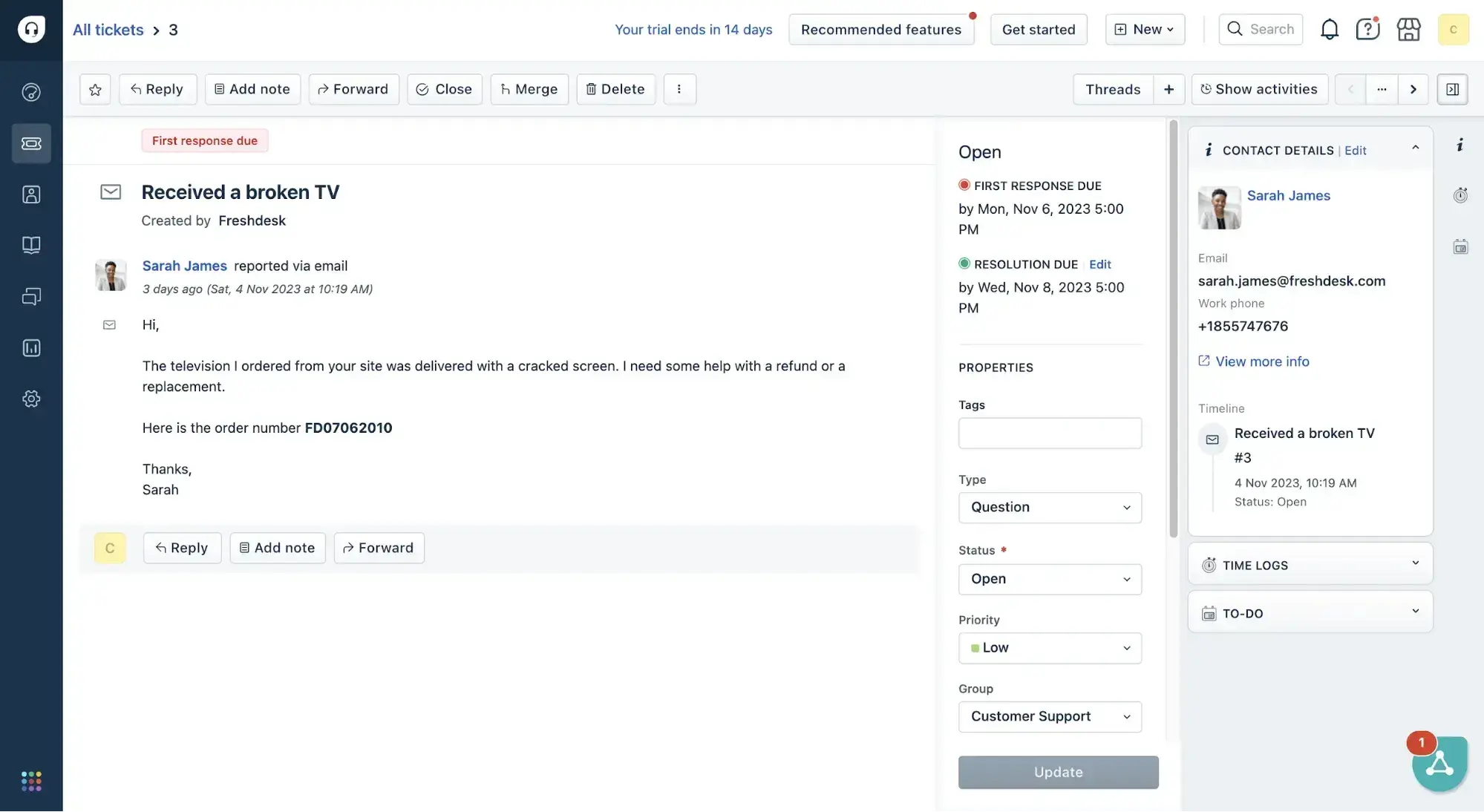
Freshdesk includes all the basic features you need to meet customers’ needs, including shared inbox, social media support, automated ticket assignment, public knowledge base, and more. It allows you to collaborate with your team on high-severity issues in real time and has reporting tools that provide valuable insights that can help your team improve performance.
Freshdesk’s forever-free plan provides a simple customer service solution for small businesses, startups, and teams of 10 reps or fewer. Freshworks also offers premium customer service management software through Freshservice, with plans starting at $15 per user a month.
Key Features
- Knowledge base: Create self-service resources for customers or employees.
- Ticket management: Manage and track incoming support tickets from multiple channels.
- Collaboration features: Easily loop in teammates for assistance on tickets.
- Automation: Automate admin tasks, like assigning agents support tickets.
- SLA management: Monitor, track, and assess agent performance.
- Reporting and analytics: Generate custom reports, like ticket response time and timesheets.
- Helpdesk AI: Recognizes customer sentiment and summarizes support situations to help agents quickly solve issues.
Pros
- Up to 10 users: This is a high number of seats for a free plan.
- Extensive integration options: Compatible with HubSpot, Slack, Salesforce, and more.
- Clean, attractive interface
- Quick customer support
Cons
- Limited feature set: Compared to paid options.
- Limited reporting capabilities: Advanced reporting is available at higher paid tiers.
- Limited automation: Automation features are limited to paid tiers only.
- Limited AI: AI features are limited to the pro and enterprise tiers.
- Limited customer portal: The Customer Portal feature is limited to paid tiers.
Best for: Growing companies who want to scale their support ticketing system as their client base grows.
What I like: The first thing I noticed with this help desk was how clean the user interface was. It was easy to find tickets assigned to me and different contacts and companies associated with my account. One feature I enjoyed during my demo was the To-do widget integrated into the main dashboard.
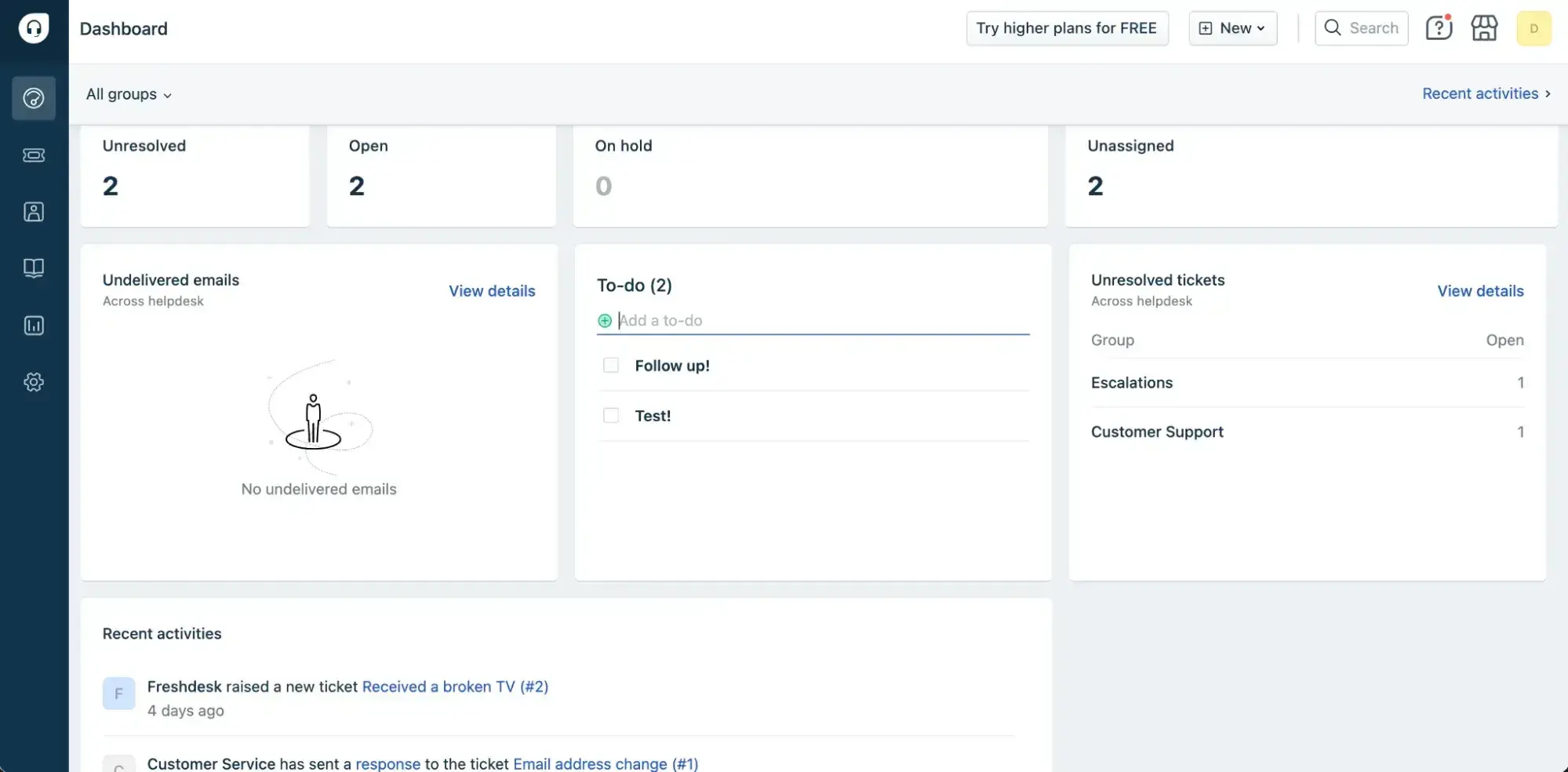
I definitely would have used a feature like this during my time as a support rep. It’s nothing crazy, but it’s a little detail that makes life as a support rep a little more streamlined compared to keeping a to-do list manually or with a separate app.
Pricing: Small teams of two agents can use Freshdesk for free with limited capabilities. For teams of three or more, you’ll need a subscription. The Growth tier starts at $15 a month per agent. The Pro tier, which includes AI capabilities, is $49 a month per agent.
9. UVdesk
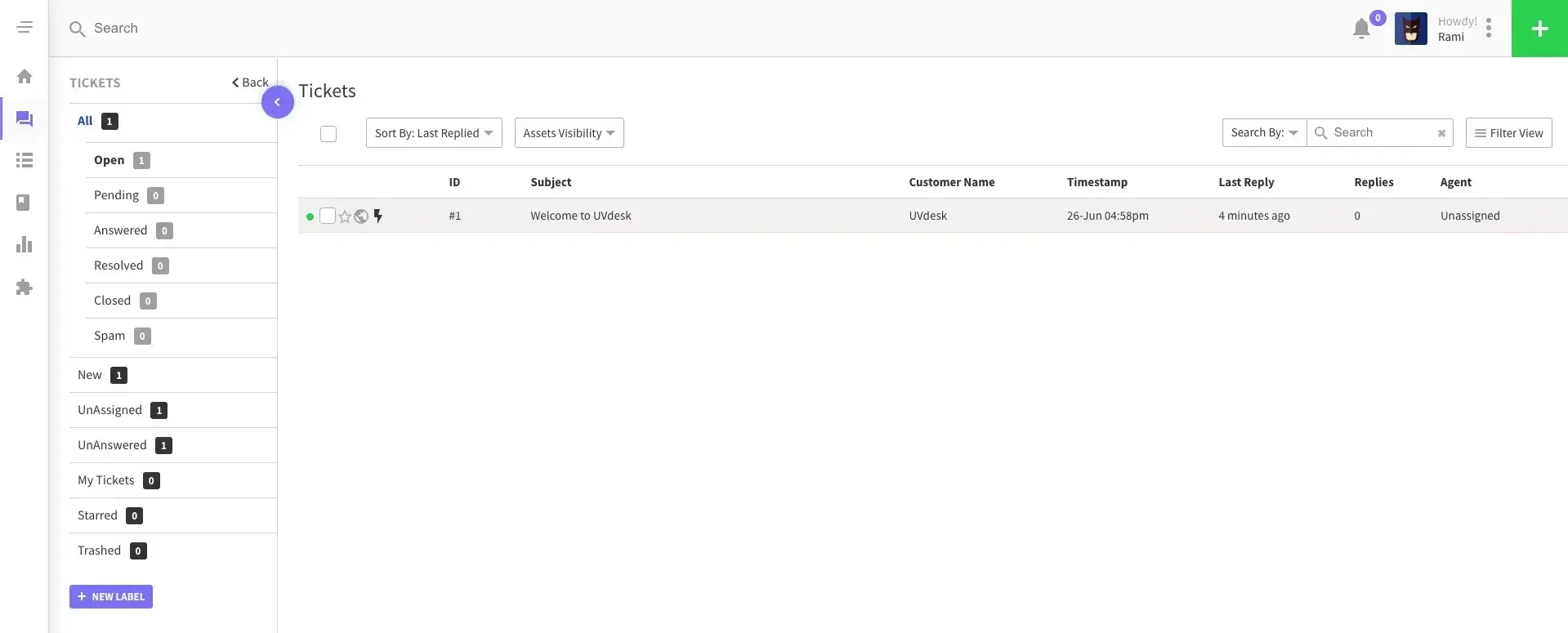
UVdesk is an open-source help desk software designed with ecommerce businesses in mind. Although it is aimed at online stores, I found that UVdesk is fully featured and versatile enough to benefit customer support operations across many types of companies.
I signed up for a free UVdesk account, and I’ve got to warn you that the signup process was a little wonky. The name and business name fields didn’t accept dashes (my last name and the name of my business both contain a dash symbol). When I generated a long, secure password with lots of special characters, it was marked as invalid, forcing me to use that one simple password I’ve used for a few too many websites (we all have one; don’t deny it!).
All that being said, there is a lot to love about UVdesk.
Key Features
- Ticket management: Manage and organize support tickets with customizable workflows, including ticket assignment.
- Multi-channel support: Manage email, social media, live chat, and web form inquiries as tickets in a unified interface.
- Knowledge base: Create and maintain a self-service knowledge base so customers (or your employees) can find answers to common queries.
- SLAs and escalations: Define SLAs and create escalation rules to ensure timely responses. This feature is typically not available in free help desks.
- Form builder: Create and embed customizable contact forms.
- Customer follow-up: Prompt customers to follow up with their ticketing requests by sending automatic follow-up emails.
- Helpdesk migration: Transfer your files and support tickets from your existing helpdesk to UVdesk.
Pros
- Open source: Highly customizable to fit specific business needs.
- No user limits: As many reps as your heart desires!
- Comprehensive feature set: Offers features typically only found in paid help desk ticketing systems.
Cons
- Technical setup required: The initial setup can be complex because of the product’s open-source nature, likely requiring development experience.
- Basic interface: Functional but basic compared to other solutions.
- Limited support: Community support (forums) is your only resource if you need assistance with the product.
Best for: Service teams who want full control over customization of their knowledge base and support contact forms. Also great for teams who want to scale their customer support across multiple channels.
What I like: UVdesk’s superpower is its open-source nature. Why is that important? Since UVdesk is open source, the entire software code is accessible for modification, integration with other systems, custom features, and even altering the product’s UI.
Now, I don’t know the first thing about modifying open-source software. However, if someone in your business can handle such a task, UVdesk is a highly customizable and cost-effective help desk solution. In addition, I like the increased security factor since all users can inspect and maintain the source code to eliminate vulnerabilities, hidden backdoors, or malicious code.
Overall, UVdesk is an astonishingly fully featured and functional free product. However, these things come at a price, and this time, it isn’t money. Instead, it comes in the form of a steep learning curve and technical know-how, but once you get everything up and running, it will seriously be worth the time and effort.
Pricing: You can use UVdesk for free. If you want access to pro features, like multi-channel integration or service agent performance data, you’ll need the Pro plan. The Pro plan costs $22 a month for a minimum of two agents.
10. Front
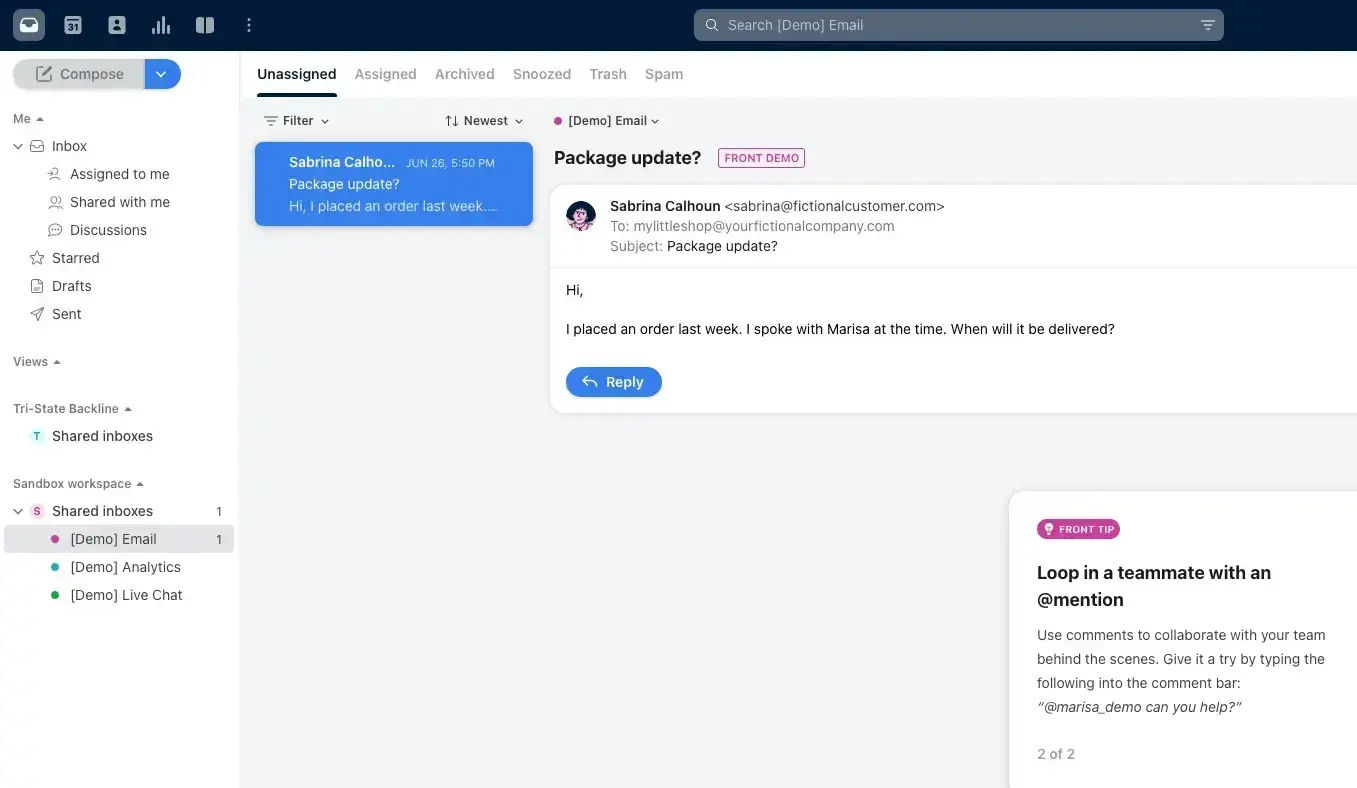
I’ll admit it. I have a weakness for modern cloud-based software with single-noun names. Front is one of those. Front is a help desk software for omnichannel customer support with streamlined communication and a focus on collaboration.
I started a free trial of Front and was impressed by the speed of the application and the intuitive UI. Front came loaded with the competitive features I expected to see, such as a shared inbox, SLAs, chatbots, and more.
One feature I enjoyed during my trial was the knowledge base. Creating and publishing articles to a sleek, blog-style interface was easy and intuitive.
Key Features
- Shared inbox: Organizes communications from multiple channels into a unified inbox for your team.
- Email management: Features like email templates, reminders, and snooze let you manage customer email communication swiftly.
- Team collaboration: Slack-style collaboration features are intuitive and encourage teamwork.
- Integrations: Integrates with many popular apps like Slack, Salesforce, and HubSpot CRM.
- Omni-channel interface: Organize your apps and channels all within the Front interface.
- Reporting and analytics: Track performance, assess workloads, and measure customer satisfaction rates.
- Front’s AI: Detects simple inquiries and provides real-time AI editing assistance in customer messages.
Pros
- Attractive interface: My favorite UI of all the products on this list.
- Workflow automation features: Not always available for free tier products.
- Intuitive knowledge base: Publishing self-service content is simple and intuitive.
- Collaboration: Allows for sidebar chats and saves them in chronological order.
- Customizable settings
- Mobile app
Cons
- Limited AI functionality: Only available with paid tiers.
- Limited storage: Storage limitations for emails and attachments at lower tiers.
- Basic reporting: Advanced reporting is only available at paid tiers.
Best for: Collaborative teams who offer customer support across various platforms, including social media and email.
What I like: If your team uses Slack for communication and collaboration, you’ll feel at home with Front. Front features an internal messaging system that lets you collaborate with other reps, comment on tickets, and tag users with the familiar @username format to loop them in where attention is needed.
I like Front because it feels modern, sleek, and intuitive. Front’s interface sparks a little bit of joy in me, which is important if you’re going to be staring at it day in and day out.
Pricing: You can try Front for free. However, once your trial ends, you’ll need to upgrade to a paid tier. The Starter Plan is $19 a month per agent.
11. Hiver

Hiver is a clever app that transforms your Gmail inbox into a fully-featured customer service ticketing system. Using Hiver, you can manage incoming customer inquiries, collaborate with teammates, set up approval workflows, and more from your Gmail inbox.
I started a free trial of Hiver and installed their Chrome extension. The added UI elements to my Gmail inbox were unobtrusive, and I could create a shared inbox in a matter of seconds. Additionally, Hiver caused no conflict with the HubSpot Sales extension I already had installed to track and log emails to HubSpot, which is a plus.
Key Features:
- Gmail integration: Transforms your Gmail inbox into a help desk.
- Shared inboxes: Reps can manage all support tickets from a single inbox, all within their Gmail interface.
- Collision detection: Prevents multiple reps from responding to the same customer email request.
- Tasks: Convert emails into tasks and manage them directly in Gmail.
- Live chat: Reps can chat with customers within their inbox, set away hours, and connect knowledge base articles to responses.
- Self-serve portal: Customer-facing interface for customers to submit tickets, check the status of their queries, or search for answers in the knowledge base.
- Workflow automations: Free up agent time by filtering urgent requests.
- Hiver’s AI: Summarize emails, auto-close conversations, and generate email templates.
Pros
- Familiarity: Your team members are likely familiar with Gmail, so starting Hiver won’t be a big learning curve at all.
- Outlook compatibility: They didn’t forget about you Windows users!
- User-friendly UI: The interface is functional and leverages the familiarity of the Gmail UI without getting in the way.
Cons
- Limited advanced features: Only available at paid tiers.
- User limit: Limited to three users at the free tier.
- Limited to Gmail and Outlook: I’m not even sure what other email clients there are, but if you use something other than the big two, you’re out of luck.
- Mobile app: The mobile app is sometimes laggy.
Best for: Teams looking to incorporate AI into their help desks and support ticketing systems.
What I like: I like Hiver because of its simplicity and ease of use. If you’re familiar with Gmail (which is likely), then Hiver reduces the help desk learning curve and integrates smoothly into your existing workflow. Hiver is a valuable solution for small businesses and startups beginning their customer support journey.
As your business grows, you may want to upgrade to a standalone help desk solution. Still, don’t underestimate Hiver’s potential to transform your Gmail into a customer service HQ.
Pricing: You can use Hiver for free. However, to access premium features, like round-robin auto assignment or analytics, you’ll need a subscription. The LITE plan starts at $19 per month per user.
12. HelpDesk
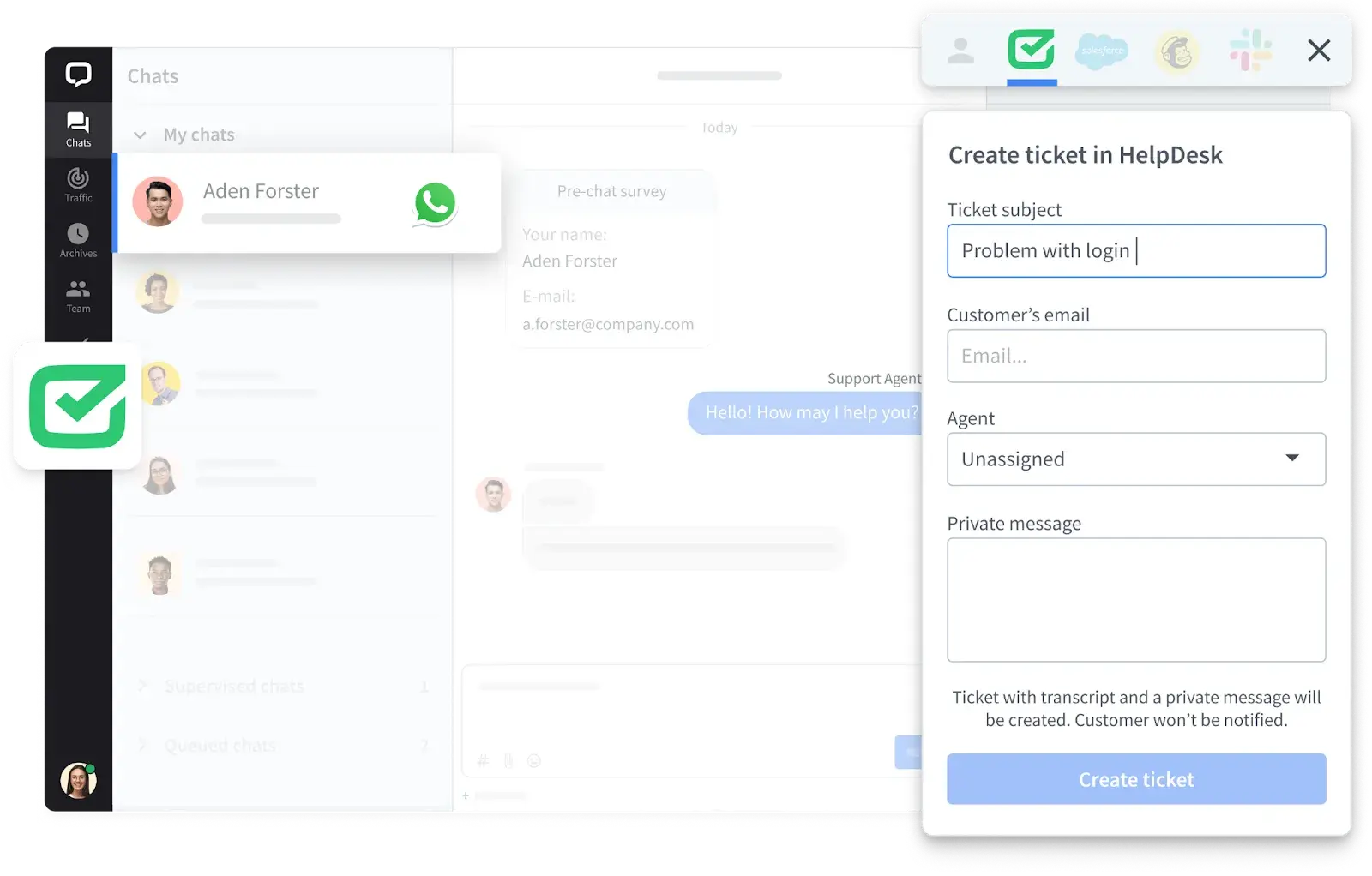
HelpDesk is an advanced ticketing system designed to enhance customer support operations for businesses of all sizes. With its intuitive interface and powerful features, HelpDesk enables support teams to efficiently manage customer inquiries across multiple channels, including email, chat, and social media.
Key Features
- Ticket management: Logs, tracks, and prioritizes customer cases. Each customer inquiry or problem is assigned a unique ticket.
- Issue resolution: Facilitates the resolution of customer issues by providing a platform for support agents to communicate with customers, troubleshoot issues, and offer solutions.
- Asynchronous communication: Communication between support agents and customers via various channels, including email, chat, contact form, and social media.
- Effortless automation: Automation and AI-based features help streamline repetitive tasks, route tickets to the appropriate departments, and provide quick responses to common queries, improving the efficiency of support operations.
- Feedback collection: Gathering customer feedback is essential for understanding their needs and improving products and services.
- Analytics and reporting: Create visual reports to better understand agent performance and customer satisfaction rates.
- Knowledge base: Create an optimized library of troubleshooting articles.
- Personalization: Brand your communications with a custom domain and address.
Pros
- User-friendly interface: Intuitive and easy-to-navigate interface, making it accessible even for non-technical users.
- Automation features: It offers robust automation capabilities such as automated workflows, ticket assignments, and canned responses.
- Customizable ticketing system: The platform allows users to customize their ticketing workflows to fit their support process. You can set rules for prioritizing tickets, create tags, and categorize tickets for better organization.
- Integration with other tools: Integrates well with other tools, such as Webflow, WordPress, LiveChat, and email providers.
- Analytics and reporting: The platform offers insightful reports on ticket resolution times, team performance, and customer satisfaction, providing teams with the data they need to improve support quality.
Cons
- Limited free tier: Offers a free version of HelpDesk for 14 days. Long-term free options are unavailable; however, you can choose between three plans designed to best suit your team.
- Asynchronous communication only: HelpDesk is ideal for handling tickets and asynchronous communication, but it doesn’t support synchronous chat features (only by integration, such as LiveChat).
Best for: Small and medium-sized businesses looking for a branded solution to connect all their customer communication in one simple dashboard.
What I like: I really like HelpDesk because it is simple to use for handling customer support tasks. The user-friendly interface makes it easy for anyone to manage tickets without a steep learning curve. The automation features include setting up workflows and automating repetitive tasks, streamlining support processes, saving time, and improving team productivity.
Another strength of HelpDesk is how it centralizes communication. This allows businesses to manage all their customer inquiries in one place, whether they come from emails or contact forms. In addition, its integration capabilities with tools like LiveChat allow businesses to build a more cohesive support ecosystem.
Pricing: You can sign up for a 14-day free trial. Paid subscriptions start at $29 a month per team member.
How to Choose the Right Support Ticketing Tool
Your support ticketing tool significantly impacts your team’s ability to do their jobs efficiently and solve for the customer. Accordingly, selecting your help desk warrants some serious consideration. But how do you know you’re choosing the right one?
I think it comes down to finding a tool that strikes the right balance between features and budget.
Assess your needs.
When choosing your support ticketing system, the first step is to evaluate your needs. There are many factors to consider.
- How large is your team?
- What’s your expected volume of incoming tickets?
- What channels will customers be contacting you from?
- Do you have any unique requirements or needs for special features like automation or AI?
Your answers to these questions will be the baseline criteria for selecting your help desk. For example, if you run a small support team that only handles limited email inquiries, you’ll only need a lightweight system. In comparison, a large enterprise team may require a robust solution with customization options and the ability to handle hundreds of team members.
Identify key features.
I touched on this above, but assessing your needs will help inform the key features your team requires. Some examples of make-or-break features may include:
- Ticket automation and follow-up.
- Reporting capabilities.
- Integration options.
- Omnichannel ticketing.
- SLA (service level agreement) management.
And much more. Based on your team’s needs, I suggest making a list of required features and “nice to have” features. Then, search for help desk software that checks off as many boxes as possible within your budget, which brings me to the next step.
Set a budget.
It all comes down to money, of course. Setting a budget for your customer service ticket system will help narrow your options. You want to maximize value, meaning you get the most high-quality features for your money.
I think help desk software isn’t the place to cut corners. If ever there was a place to stretch that budget a little, it’s here. Why? Because it’s an essential tool for your team’s ability to satisfy customers. It’s not worth cheaping out on your help desk software if it means missing out on critical features and creating a bottleneck in your ability to help customers.
That being said, it all depends on your needs, and if your needs are basic, you can take advantage of many free help desk solutions.
Consider scalability.
I think it’s critical to choose a customer ticketing software that can grow with your team. Many solutions offer a free tier, which is excellent for smaller teams just starting out. However, it’s essential to consider your team’s growth trajectory when selecting the right option.
After all, you don’t want to choose help desk software that you’ll need to replace after only a year or two, which will result in lots of lost time in retraining and integrating a new system into your workflow.
Service desk software like HubSpot is fantastic because it offers a free option to get you started. There are then increasing paid tiers that expand upon feature sets to align with your growing business needs.
Test multiple tools.
I’ve been writing about and researching customer service software for a while now, and I’ve found that the market is relatively competitive. What I mean is, generally, there is parity regarding features and capabilities amongst the foremost service desk options.
So, how do you choose between solutions that offer the same features at similar price points? That’s where the fun comes in. Testing!
Well, maybe it’s only fun if you’re a software nerd like me. Regardless, it’s essential to audition a few tools to figure out which fits your workflow best.
How I Chose the Best Help Desk Software
After testing many free help desk ticketing systems, there can only be one winner. Well, actually, there are two. My favorite free helpdesk solutions are UVdesk and HubSpot.
I considered two factors when forming my opinion on my favorite help desk ticketing systems: first impression and value.
First impressions are everything, and when it comes to evaluating software, that equates to my initial experience with the UI and how intuitive it feels to navigate around the product and locate the features and functionality I’m looking for. UVdesk and HubSpot both pass this test. UVdesk’s interface is more basic than HubSpot, but what it lacks in looks, it makes up for in value.
Value is a big one. In my mind, value is the idea of how much you’re getting for what you pay. Of course, you want the most bang for your buck. Now, both of these options are free, so what you pay isn’t always money. UVdesk and HubSpot both offer a competitive feature set that keeps up with the competition.
UVDesk
When it comes to free software solutions, there’s usually some kind of trade-off. Typically, you get fewer features compared to paid versions, or you have to put up with banner ads in the header and sidebar. However, the only trade-off with UVdesk is effort. It’s not for everyone due to its open-source, self-hosted nature and technical implementation, but the amount of premium features and customization available within UVdesk blew me away.
If you have the technical experience or development resources to deploy and maintain UVdesk, you have an enterprise-level ticketing system for free. The time and effort required to deploy and maintain such a system are a cost to consider, but if UVdesk is the right fit for your team, then I think the value is astronomical.
HubSpot
I’ll admit it: I have a SoftSpot for HubSpot (see what I did there). All jokes aside, HubSpot strikes the perfect balance between value and usability. The HubSpot interface is remarkably intuitive and attractive, and I would be happy to look at it daily.
Regarding features, the free version of HubSpot Help Desk won’t give you access to all the enterprise-level features you’re getting with UVdesk for free. However, I believe that 99% of small organizations are better suited for a solution like HubSpot. At the free tier, HubSpot offers all the help desk features you’ll need to run a basic customer service operation, and it is effortless to get up and running.
What sets HubSpot apart from similar help desk ticketing systems is its potential for scalability. HubSpot can grow with your business and become the complete operational hub for your entire organization. Native integration with HubSpot’s free CRM alone is a remarkable value that brings elevated visibility into customer interactions compared to other options on this list.
Find the Right Help Desk Software for Your Team
As your company grows and takes on new clients, your customer service team will also work to keep up with increased demand for customer support requests. Help desk software will allow reps to effectively and efficiently organize those requests, manage ticket volume, and provide support.
After testing all these different help desk solutions, I’ve found that my favorite ones are those with the sleekest, most minimal UI. For the most part, all of the help desk solutions on the market offer similar capabilities and features, so your choice should come down to usability and workflow within your budget.
Editor’s note: This post was originally published in March 2019 and has been updated for comprehensiveness.
![]()
My Tips for Creating a Stellar Retail Customer Experience
In marketing, where I’ve spent my career, my mission is to nudge customers to buy. But sometimes marketers focus so much on the funnel that they forget about making a great experience. When retail customer experience (CX) is poor, customers may walk away. But when […]
ServiceIn marketing, where I’ve spent my career, my mission is to nudge customers to buy. But sometimes marketers focus so much on the funnel that they forget about making a great experience. When retail customer experience (CX) is poor, customers may walk away.
But when you create a memorable experience, you’ll earn a brand advocate and repeat business. 81% of customers say a positive customer service experience increases the chance they’ll make another purchase, so CX impacts your bottom line.
I spoke with three CX leaders to find out what makes a great customer experience, how to take an omnichannel approach to bring technology and in-store spaces together, and retail CX examples to inspire you.
Table of Contents
What is retail customer experience?
Retail CX is how a customer perceives your brand, influenced by every customer interaction before, during, and after a purchase. Both digital, phone, and in-store experiences contribute to your CX. Retail CX can be positive or negative — a value-add or a detractor — so it’s important to get it right.
Why a Good Retail Customer Experience is Important
CX is about much more than giving customers the warm touchy-feelies. Here’s what CX can do for your retail business.
1. Differentiate your brand from customers.
Your customer can find the exact same product at many stores, so how do you differentiate yourself to gain their business? When I shop, I weigh price, convenience, and shipping options, but I also weigh customer experience. How easy will my shopping process be, and what kind of support will I have if there’s an issue?
2. Drive customer loyalty and repeat purchases.
When customers have a good experience, they’re more likely to return and buy again. Inversely, just one bad experience will prompt one in three customers to walk away from a brand they love.
“Ultimately, if you are not elevating your customer experience strategy to be the strategic part of your business, you won’t have staying power. You will see a significantly large percentage of what I call lapsed customers— who buy from you one time, and then they never repeat the purchase,” says Zack Hamilton.
Hamilton is a senior vice president and head of growth strategy and enablement at parcelLab. Hamilton has advised companies from Apple to Dick’s Sporting Goods on retail CX.
Simply put, good experiences create customer loyalty, repeat purchases, and customer advocacy. It’s simple for retail customers to walk away, so bad experiences create customer churn.
3. Reduce customer acquisition costs.
Your customer acquisition cost (CAC) is the total cost of sales and marketing to gain a new customer. When your CX is poor, like a disorganized store or a bad online checkout experience, you’re less likely to convert them to make a purchase. That means you need to spend more money bringing more customers to your store or website before making a sale. Bringing back an existing customer costs much less than acquiring a new one, keeping your costs lower.
4. Grow revenue.
I don’t have to spell it out for you. Happy returning customers plus lower costs equal more revenue and lower costs. Good CX contributes to a healthy, growing business. Companies with poor CX will always struggle to thrive.
“If you don’t elevate your customer experience, you won’t have engaged customers that drive loyalty,” cautions Hamilton. “So your customer acquisition cost will always be very high, and you won’t be able to compete with your profitability margins. Ultimately, you will go out of business because you’re not making the margins that you need to make.”
How to Improve Your Retail Customer Experience
The last decade has brought fundamental change to retail. Self-checkouts, mobile apps, membership programs, ecommerce, and curbside pickup have reinvented how people shop. But is all of it beneficial? Here’s how to improve your retail CX and create a stellar shopping experience.
In-Store Customer Experience
Four out of five purchases still take place in a store, so brick-and-mortar is still king. Here’s how to create a welcoming, efficient store experience that drives sales.
1. Design around what your customers want.
First, recognize that there is no one-size-fits-all approach when it comes to retail experiences. When I walk into a small boutique, I’m looking for a different experience than I get at Target. I’m likely looking for specialist recommendations and advice, rather than shopping an entire aisle of choices and picking up some groceries with my makeup.
I have a mission, and your job is to design an experience that helps me accomplish it. Resist the impulse to be swayed by every new trend or imitate what big box stores are doing — it may not be what your customers want.
2. Empower your frontline staff.
Staff members are responsible for delivering your brand experience, and they can make or break it.
“My interaction with your employee is my brand experience. A great store experience has to be wrapped up in an incredible experience with the frontline team,” advises Hamilton. “If you‘re a luxury boutique like a Neiman Marcus, your goal is for a customer to feel bold and empowered coming out of the boutique. If your employees don’t feel bold and empowered, they can’t help the customer feel bold and empowered.”
To empower your frontline staff, consider the employee experience as well as the customer experience. Keep appropriate staffing levels, train and treat your staff well, and empower them to make decisions that will turn a negative customer experience around.
3. Enhance your store layout and design.
Create an inviting atmosphere in your store with wide aisles, clear signage, and visual merchandising. You can use lighting, furniture, music, wall color, and even scents to create your ideal atmosphere. Strategic product placement encourages customers to explore the store more and find relevant products.
You can also consider immersive experiences like dining at Restoration Hardware’s showroom in a real-life historical estate.
4. Integrate technology.
Technology can play a huge role in improving a customer’s experience. For instance, it can help them navigate the store to find what they need faster.
The Home Depot pioneered an app feature to help customers locate an item by aisle and bin number. Now, Target and many others have adopted this feature. Digital signage, interactive displays, and price-check kiosks also help customers to find relevant products and check out faster.
Alex Campbell, co-founder and chief innovation officer at Vibes, believes that mobile technology can improve the customer experience and help customers achieve their mission. 75% of people say that text messages routinely drive them to purchase from brands, but these texts need to be on-brand, personalized, and useful.
For example, a shopper can add an offer to their phone’s mobile wallet at home. Then, when they walk in the store, geofencing reminds them with a prompt to use the coupon and save money.
“It‘s interesting to take a step back and look at what a customer’s mission is when they get to your store. How do we use mobile to make it easier?” says Campbell.
Online Customer Experience
With ecommerce, it’s harder to keep shoppers’ attention and easier for them to comparison shop. It would take you all afternoon to drive to five stores, but you can shop at five ecommerce sites in a tidy half hour.
Here’s how to catch and keep your customers’ attention online and create a great experience.
1. Nail your online store design, navigation, and checkout.
Three-quarters of ecommerce sites have mediocre to poor performance when it comes to homepage and category navigation, according to Baymard Institute. Simply put, customers can’t find what they need. The categories may be too confusing, or the filtering options don’t work well.
Checkout is another sticking point for customers, with a 70% cart abandonment rate in 2024. Customers give up when the checkout process is too long, the shipping and return policies aren’t clear upfront, or when unexpected fees show up during checkout.
Create a user-friendly website, offer a guest checkout option to let customers checkout without creating an account, and offer multiple payment options for a great customer experience.
2. Meet your customers where they are.
When customers have a product question or need support, they’ll reach for whichever communication channel is most familiar and convenient. In many cases, that’s text and social media.
While I managed social media for a consumer brand, I saw people reaching out on Facebook Messenger or X for just about anything, from product requests to complaints.
With social commerce, customers are completing their entire shopping experience through platforms like TikTok or Instagram — they may never come to your website. More and more, we as consumers want to reach brands on whichever channel is most convenient, whether that’s messaging or social media.
“People don’t want to make 1-800 calls anymore. We’re seeing the trend that calling is massively going down, and traffic on your websites and apps is massively up,” shares Gaurav Passi, founder and CEO at Zingly.ai. “It’s super critical for brands to engage where their customers are, and right now, that is websites, messaging, digital properties, texting, and WhatsApp.”
Most of the time, customers only engage with a brand when something is wrong, which means your interaction isn’t starting in a positive place. Find the balance of proactive communicating with customers without annoying them — and that’s where personalization comes in.
3. Personalize, personalize, personalize.
With millions of website pages and products at their fingertips, people need a way to cut through the clutter. HubSpot’s research shows that 78% of customers expect more personalized interactions than ever before.

“It is not about you. It’s about the consumer who’s coming in, what their likes are, where their dislikes are, and what they’ve bought with you in the past,” explains Passi. “Understanding your consumer in-depth and applying that knowledge in real time, I think, is the most important thing right now.”
With personalization, you can show customers more relevant products to buy. You can speed up customer service interactions by pulling up a customer’s conversation and purchase history in real-time and seamlessly switching between channels.
“I personally hate it when I get messages that aren‘t personalized to me, because I know you can do it, or you should be able to do it,” offers Campbell. “We do a customer concern survey every year where we ask people how many text messages are too many messages. Around a third of people say it doesn’t matter how many messages they get as long as they’re personal,” he shares.
Just 35% of CRM leaders say their customer data is fully integrated with their service tools. “There’s been a huge push over the past five or ten years of collecting data. Now we’re at this point of figuring out how to use it,” Campbell says.
4. Bring in AI the smart way.
One way to leverage all of your customer data is to integrate AI into your customer interactions. The catch, though, is figuring out how AI can be additive instead of subtracting value. A bad AI interaction is still a bad experience. However, AI can bring scale customer service and recommendations to help customers day or night, on any channel.

“When brands have all their data together, we’re already starting to see how AI can sift through millions of pieces of data in real time and offer up those personalized recommendations online drive the personalization strategy,” says Hamilton.
“I think AI can be an incredibly powerful tool for customer experience, but it can’t fix a broken process. If you already have really bad processes in place, AI is only going to make those processes worse,” says Hamilton.
The key is to find when to make the switch from an AI interaction to a human one.
“We are automating 60 to 70% on the buying and services sides, but the other 30% of the time, automation isn’t always good,” shares Passi. “You might be over-automating; the customer is not happy, and their sentiment is off. We’ve been designing a technology which understands based on customers’ records, emotions, and real-time sentiment, when and how to bring a human in the loop.”
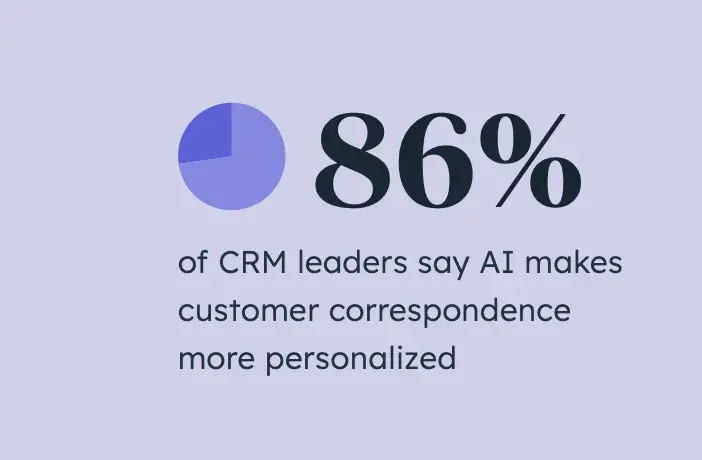
When you get it right, you can scale personalized recommendations and customer service for a stellar customer experience.
The Omnichannel Approach to Retail CX
Above all, I’ve learned that the brands who get CX right treat online and in-store CX as separate strategies. They design one cohesive experience because that’s how the customer perceives it — as a single experience from one brand. They expect the same voice, service, and excellence across all channels, whether in your store, on your website, or on mobile.
Use a CRM and an integrated messaging inbox to ensure consistency across all touchpoints for your customers. SMS and AI-powered interactions can be powerful tools, but they need to be personalized and consistent in your brand voice. 75% of people say that text messages routinely drive them to purchase from brands. Chipotle is a great example of sending personalized text campaigns in its distinct brand voice.
Apple is another brand that does an incredible job of creating an omnichannel retail experience, integrating digital and physical spaces. If you’ve visited an Apple store, you know that it’s easy to make an appointment in advance to avoid a wait. In the store, a team member comes to you while you test out their products and can complete your purchase from their iPad — no need to head to a checkout line. If there’s a problem later, you can get the support you need by chat or email.
Retail Customer Experience Examples
I’m always blown away by a good customer experience, like when an employee goes above and beyond or an app helps me find what I need or save money. Here are three brands getting it right — and what makes them stand out.
Walmart
Love it or hate it, you have to admit that Walmart is convenient. 90% of Americans live within 10 miles of a Walmart, and you can find almost anything you need there. Over the past few years, they’ve transformed their CX with mobile technology and omnichannel experiences that integrate digital and physical spaces.
While all shoppers can take advantage of same-day curbside pickup, Walmart+ members have access to same-day grocery delivery and other perks. The brand redesigned hundreds of stores with a modern, more aesthetic look to encourage browsing and engaging with products.
They’ve also built their own proprietary large language model (LLM) called Wallaby, trained on decades of Walmart purchase data. This technology is enabling omnichannel customer experiences like text and voice shopping and allowing customers to get support like processing returns through messaging. By the end of 2025, they even expect to create personalized homepages for each shopper.
Dick’s Sporting Goods
If you walk into a Dick’s Sporting Goods, you might be surprised to find more than racks of products. Climbing walls, immersive virtual golfing centers, and multi-sport HitTrax cages in select stores are engaging customers in a new way and giving them a reason to stick around and shop.
That’s just one way Dick’s has revamped their CX. They’ve added free shipping for most items, one-hour in-store pickup, and a price match guarantee. More than six million people use their GameChanger app to manage team sports and stream games to friends and family.
The brand now uses targeted surveys to collect feedback and act on it in real-time. That’s led to significantly lower bounce and exit rates, and significantly higher conversion rates on in-cart exercise equipment.
Carvana
As someone who bought a car this year, I know how painful the car-buying experience can be. Time-consumer dealer visits and haggling over pricing isn’t very convenient or comfortable. Enter Carvana, a disruptor in the automotive space. Carvana’s main focus is a frictionless buying experience for customers.
“Ordering a car from Carvana was the easiest thing ever,” shared customer Rebecca Garner. “The online experience was so easy we barely had to think about it. We got access to the warranty information, car registration, and anything else we could need in the app. Any information we weren’t able to find ourselves, we could find through the chat. They delivered the car right to our door in the city, and our interactions with the person that delivered it were fantastic.”
How to Measure the Success of Your Retail CX
Because it deals with human emotion, CX can be tricky to measure. Here are a few of the top metrics to gauge how good of an experience you’re creating.
Engagement Rate
One way to measure CX is to look at how much customers engage with you and in what way. How often are they reading your emails, for instance? Are they reacting to your social posts or SMS messages? Are they clicking through to your website or unsubscribing?
Customer Satisfaction Score (CSAT)
CSAT is a metric that describes the percentage of customers who are satisfied with their purchase. This helps you track CX performance over time and segment your audience to send personalized messaging to satisfied or less-than-satisfied customers.
Net Promoter Score (NPS)
NPS is a popular measure of customer sentiment and advocacy. The measurement simply asks customers on a one of 10 how likely they are to recommend the brand to a family or friend. It’s more of a result of good CX than anything else — a high NPS usually reflects a positive customer experience.
Customer Retention Rate (CRR)
CRR measures what percentage of customers you retain over a set period. The opposite of this is customer churn, which is how many customers you lose over a set period.
One caution I heard from the CX leaders I interviewed is to avoid the fallacy of vanity metrics. Rather than boasting about a CSAT score of 80, dig into the remaining 20% to understand why they weren’t satisfied — and take action.
How to Create a Customer-Focused Company
So, how do you create a CX focus at your company? One half is technology, which I’ve already covered. Your tech stack and how you implement it every day can make or break your CX. The other half comes down to people and culture. How do you design a customer-centric culture and embrace change to meet customer priorities?
1. Create an org structure and culture for success.
One problem working against CX is internal siloes. Marketing, sales, and customer services are all working separately instead of as one team. I’ve seen teams set up competing for resources, so they aren’t incentivized to work together toward a common goal.
One way to solve this is through establishing a CX leader who can advocate for the customer and bring all these siloes together.
“The best CX leaders are influencers, right? They don’t own the entire customer journey. They have to influence the cross-functional stakeholders to do that. I look at them as problem solvers. They should have a bias for action and report directly to the CEO,” recommends Hamilton.
Beyond your org chart, it’s also a question of culture. Can you create a culture of customer focus that permeates from your frontline staff to website designers to executive leadership?
“The customer experience should be owned by everybody at that company. It’s everyone’s problem, everyone’s responsibility,” says Campbell. “That’s the whole reason why you’re there, making sure that your customers have an experience with your brand that matches what you stand for.”
2. Incorporate customer feedback and embrace disruption.
One big mistake companies make in CX is listening and collecting customer feedback — then never acting on it.
“There’s a difference between listening to your customers and doing customer experience,” shares Hamilton. “CX leaders are not connecting the dots between what our customers are telling us, the impact on the business, and why we should do something about it.”
Look at your metrics and change your communication tactics if your opt-out rates are too high. Listen to customers and prioritize redesigning your processes and technology according to your voice of customer research.
That may mean reinvention — radically changing your tech or diverging from others in your industry. But often, that disruption can mean survival in this noisy world competing for attention.
Earn Customer Love with Personalized, Frictionless Experiences
One of the common threads I gleaned from speaking to top CX thought leaders is that while retail CX is complex, your focus should be simple. Design experiences that make your customers feel valued and known.
Align your data to create personalized, omnichannel experiences that make it easy to buy and get support if needed.
“We need to focus on using our data to the customer’s benefit. When you think about the customer, it should be so simple. How can you use data to make the experience better and easier right now?” asks Campbell.
Above all, retail CX impacts the bottom line. As you build a program, don’t forget to measure your success and consider the whole picture of how CX impacts your business.
“I think one of the reasons why customer experience has experienced budget cuts the last few years is the lack of connecting the dots between customer experience and business impact,” explains Hamilton. “If you think about CX of the future, it‘s less about your MPs and your vanity metrics, and it’s more about driving profit and loss. That’s the CX practitioner of the future, those who understand that and can connect the dots.”
![]()
AI Meets Customer Experience: Mapping Journeys with Machine Learning
As an entrepreneur, I’m always looking for tools and strategies to run my business more efficiently and boost my revenue. Given that I‘m a one-woman team, I’m constantly exploring artificial intelligence (AI) tools that can help me run my business better. One use case I’ve […]
ServiceAs an entrepreneur, I’m always looking for tools and strategies to run my business more efficiently and boost my revenue. Given that I‘m a one-woman team, I’m constantly exploring artificial intelligence (AI) tools that can help me run my business better.
One use case I’ve found particularly interesting is how I can use AI to improve my customer journey— which essentially ensures that I’m delivering value to potential customers at various points of their buying journey. To learn more about the areas of opportunity, I spoke with some experts in this space and also demoed a few innovative tools.
In this article, I‘ll walk you through everything I’ve learned about AI and customer journey mapping. You‘ll see how you can use machine learning to process large amounts of customer data, uncover hidden patterns, and predict future behaviors with uncanny accuracy. Whether you’re a solopreneur like me or leading a fast-growing tech startup, you’ll find learnings and tips you can apply to your business.
Note: You’ll see references to both Claude and ChatGPT throughout the article. I tested both throughout the writing process — and you can apply the prompts to whichever tool you prefer.
Table of Contents
What is AI-powered customer journey mapping?
AI is transforming the way businesses understand and map their customers’ journeys. By leveraging machine learning algorithms and big data analytics, AI can process vast amounts of customer data to identify patterns, anticipate customer behaviors, and uncover insights that might be missed by human analysis alone.
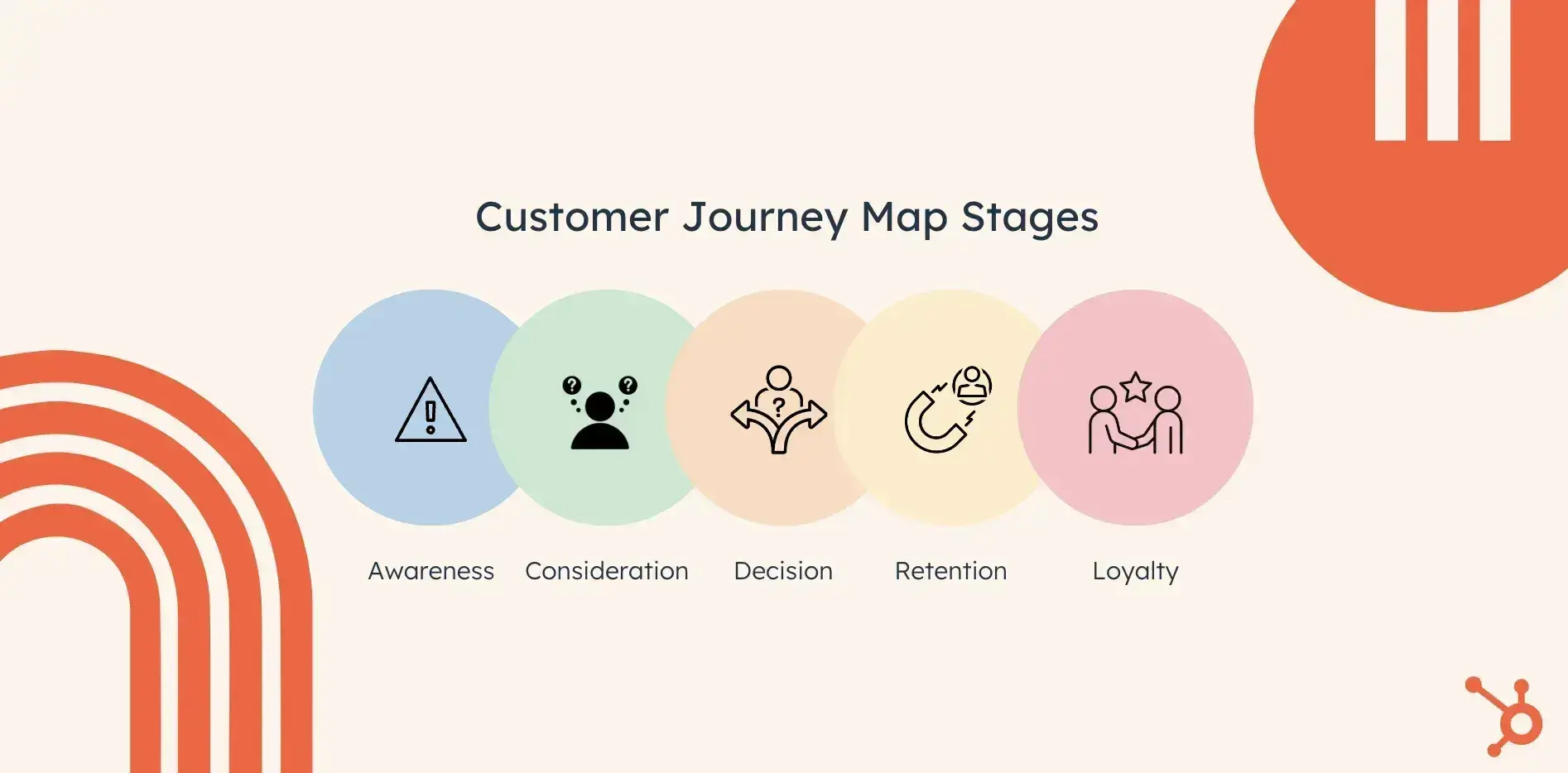
For example, a traditional customer journey map visualizes how customers move from awareness to acquisition and, ideally, to becoming loyal customers. AI enhances this process by:
- Processing large volumes of data from multiple touchpoints.
- Identifying hidden patterns and correlations.
- Predicting future customer behaviors.
- Personalizing the journey in real-time.
- Providing actionable insights for optimization.
How can AI improve the customer journey mapping process?
To understand how valuable AI can be, you should be familiar with the pain points (pun intended!) of the journey mapping process. Two of the biggest ones are:
- The time it takes to build out, and
- The vast amount of data needed to process.
Think about all the customer touchpoints you might have as an ecommerce startup, for example.
According to a Nielsen Norman Group survey, completing a traditional customer journey map could take days or even weeks. That’s not including the time it takes to collect and synthesize customer feedback.
The process is time-consuming thanks to four main factors:
- Quantitative data — website analytics, social media, customer service logs, sales data, etc.
- Qualitative data — insights from different departments, customer interviews, survey feedback, etc.
- Data analysis — identifying patterns and insights is often a manual, time-intensive task.
- Visualization — it takes significant effort and skill to create a visually appealing and easy-to-understand map.
Here are some other use cases for AI in the customer journey mapping process, according to the experts I spoke with:
- Designing marketing/sales/CS processes for engagement along the customer journey.
- Architecting workflows/automation for data management and outreach campaigns.
- Analyzing customer sentiment across multiple touchpoints.
- Personalizing customer experiences in real-time.
- Predicting future customer behavior and needs.
- Defining and outlining the customer journey.
Statistic: 50% of surveyed sales professionals believed that AI would enable scalability in ways that would otherwise be impossible.
What are the limitations of using AI to create a customer journey map?
It‘s easy to get crazed over the potential of AI in business, but it’s worth remembering that it‘s still relatively new. Keeping this in mind, I always recommend trying any new AI tool with a healthy dose of skepticism. (After all, I’m a journalist at heart!)
Erik Karofsky, CEO of VectorHX, has used AI to develop journey maps and feels it’s not quite ready for prime time yet.
A big challenge with creating a journey map using AI is that “it doesn’t serve any user well,” he says. “AI can produce overly complex maps cluttered with unnecessary information or may generate overly simplistic, generic maps that fail to provide valuable insights. These journey maps frequently require extensive revision, and during this process, gaps in the journey become apparent.”
However, where AI can be useful (with some caveats) is in providing insights that contribute to a better journey or influence the journey itself (though a UX professional is still essential to the creation process), he explains.
Here are some real-life examples he shared with me to illustrate:
- Summarizing qualitative insights to highlight key steps and pain points can be helpful, but the data must be rich and well-curated.
- Segmenting audiences based on specific criteria and analyzing their behavior has improved, but it still largely remains within the realm of analytics rather than journey mapping.
- Offering personalization suggestions is valuable, yet it’s merely one component of a broader journey.
- Engagement across touchpoints can influence outcomes within a journey, but it doesn’t define the journey itself.
That being said, let’s explore how you can create a customer journey map with AI — with a focus on using it as a partner in the process instead of an overall replacement.
How to Create a Customer Journey Map With AI
This is where the fun begins (though, be warned: there is a learning curve). My biggest pro tip when incorporating AI into any aspect of your business is to take the time just to experiment without putting pressure on the outcome. New tools are being released every day (or at least it feels that way): try different tools and prompts to see what’s possible.
See the example below of how one tool, Journey AI, helps synthesize customer data to create a personalized journey in a matter of seconds.

This is a sneak peek of what‘s possible — we’ll dive deeper into the tools shortly. But before we get there, let’s cover the basics. Here are the first steps you should take to create a customer journey map with the help of AI.
Step 1: Define your objectives.
Start by clearly outlining what you want to achieve with your customer journey map. For example, you could focus on any of the following:
- Identifying and addressing customer pain points.
- Enhancing overall customer satisfaction.
- Identifying new upsell opportunities.
- Boosting customer retention.
- Increase conversions.
According to a study by Gartner, companies that prioritize and effectively manage customer journeys are twice as likely to significantly outperform their competitors in revenue growth. This underscores the importance of setting clear objectives for your journey mapping process.
As I walked through these steps for my own business, I really wanted to find opportunities to increase conversions among my potential customers. This helped me keep a narrow focus as I built out a customer journey map.
If you’re at a larger organization, John Suarez, director of client services at SmartBug Media, first recommends interviewing marketing/sales/customer service to understand their customer and ideal journey. From there, you can be laser-focused on gathering the specific data you need.
How to implement AI at this stage: Test out different ChatGPT prompts to uncover your objectives and find ways to narrow down your customer journey map. Here’s an example prompt below I tried with Claude.

Step 2: Gather customer data.
Gather all relevant customer data from various touchpoints. This will depend on your specific business, of course, but it can include:
- Customer service data — help tickets, chat logs, knowledge base usage, etc.
- Purchase history — purchased orders, abandoned carts, returned items, etc.
- Email marketing data — emails opened, links clicked, unsubscribe rates, etc.
- Social media interactions — direct messages, mentions, engagement, etc.
- Direct feedback — surveys, customer satisfaction, product reviews, etc.
- Website analytics — page views, heat maps, session duration, etc.
- Referral data — organic search, paid ads, direct referrals, etc.
Warning: AI tools are only as useful as the data you feed them. Using poor or dated data sources can be very destructive in this process. AI is like baking — a quality cake comes from quality ingredients. The data you’re pulling needs to be as recent and thorough as possible.
For my business, my main touchpoints are my business website and my social media profile. From there, I’m able to pull reports using tools like Google Analytics to learn more about my website visitors. I can learn more about what links they click on, how often they return to my website, and where they drop off in the user journey.
If you’re a startup or small organization, gathering customer data is crucial but can be challenging due to limited resources and a potentially small initial customer base. A lean approach might involve leveraging a combination of free and low-cost tools to collect data across various touchpoints, like your CRM.
How to implement AI at this stage: Once you‘ve gathered all of the data you’ll need, you can dump it into Claude or ChatGPT and try something like the prompt below. By asking specific questions in your prompt, you can tailor the responses and data analysis to your needs.
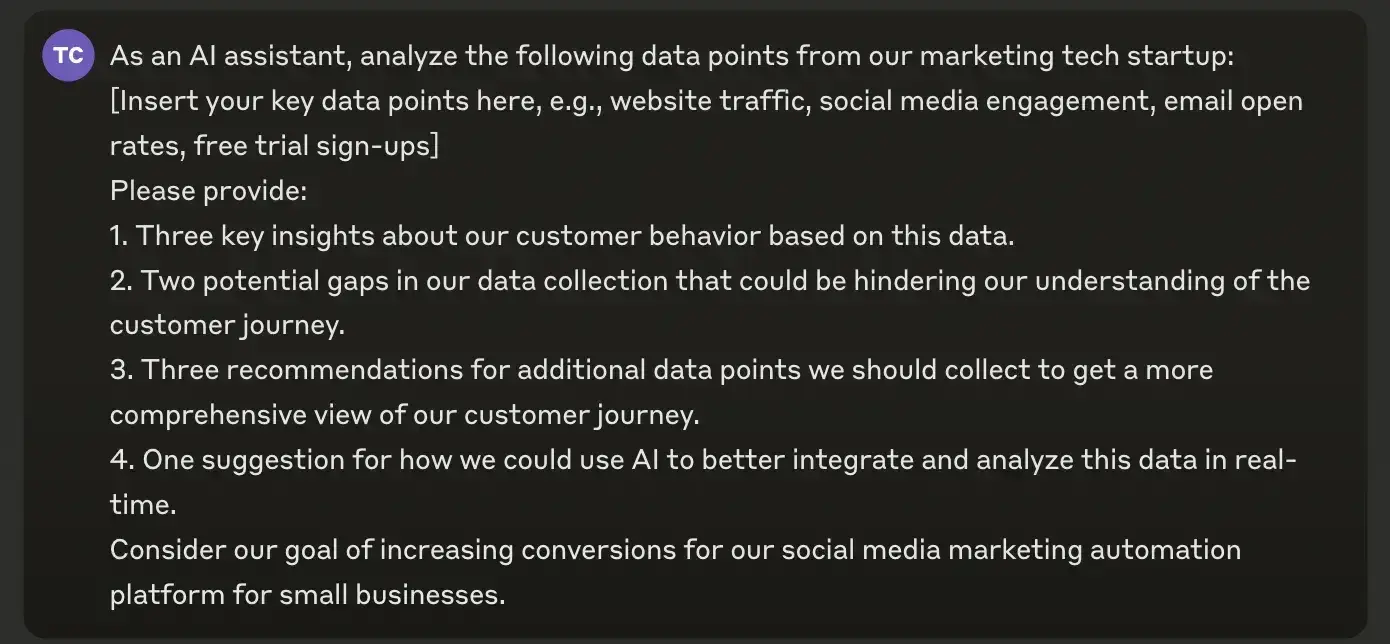
Use AI-powered tools to integrate this data into a cohesive dataset.
In the era of big data, consolidating information from various sources into a unified, actionable dataset is a major challenge for businesses of all sizes. But this is an important step creating accurate and comprehensive customer journey maps — so you’ll want to get it right.
A survey by Forrester found that 80% of companies struggle with data silos, which can lead to incomplete or inaccurate customer journey maps. Thankfully, AI-powered data integration tools can help overcome this challenge by automatically consolidating data from multiple sources.
Step 3: Analyze the data with machine learning.
Apply machine learning algorithms to your integrated dataset. These algorithms can identify patterns, segment customers, and highlight key touchpoints in the customer journey.
Here is an example prompt you can try. Just make sure to tweak your own data points.

There are also more advanced tools you can use — especially if you’re a developed business with a massive quantity of data to analyze.
Step 4: Use NLP to analyze customer feedback.
Next in your process, you can use natural language processing (NLP) to analyze customer feedback and communications. This helps in understanding customer emotions and sentiments at different stages of their journey.
For example, you can use AI to analyze the sentiment of customer feedback, categorize feedback into themes, discern customer intentions, and predict future customer behaviors. All of these tasks can give you invaluable learnings about the customer journey.
Step 5: Visualize the data with AI tools.
Use AI visualization tools to create a dynamic, data-driven representation of the customer journey. This visual map should highlight key touchpoints, pain points, and opportunities.
Suarez recommends using a tool like Whimsical Diagrams’ Custom GPT for Flow Mapping at this stage. I was fascinated with how quickly this tool created a simple customer journey map flow chart.
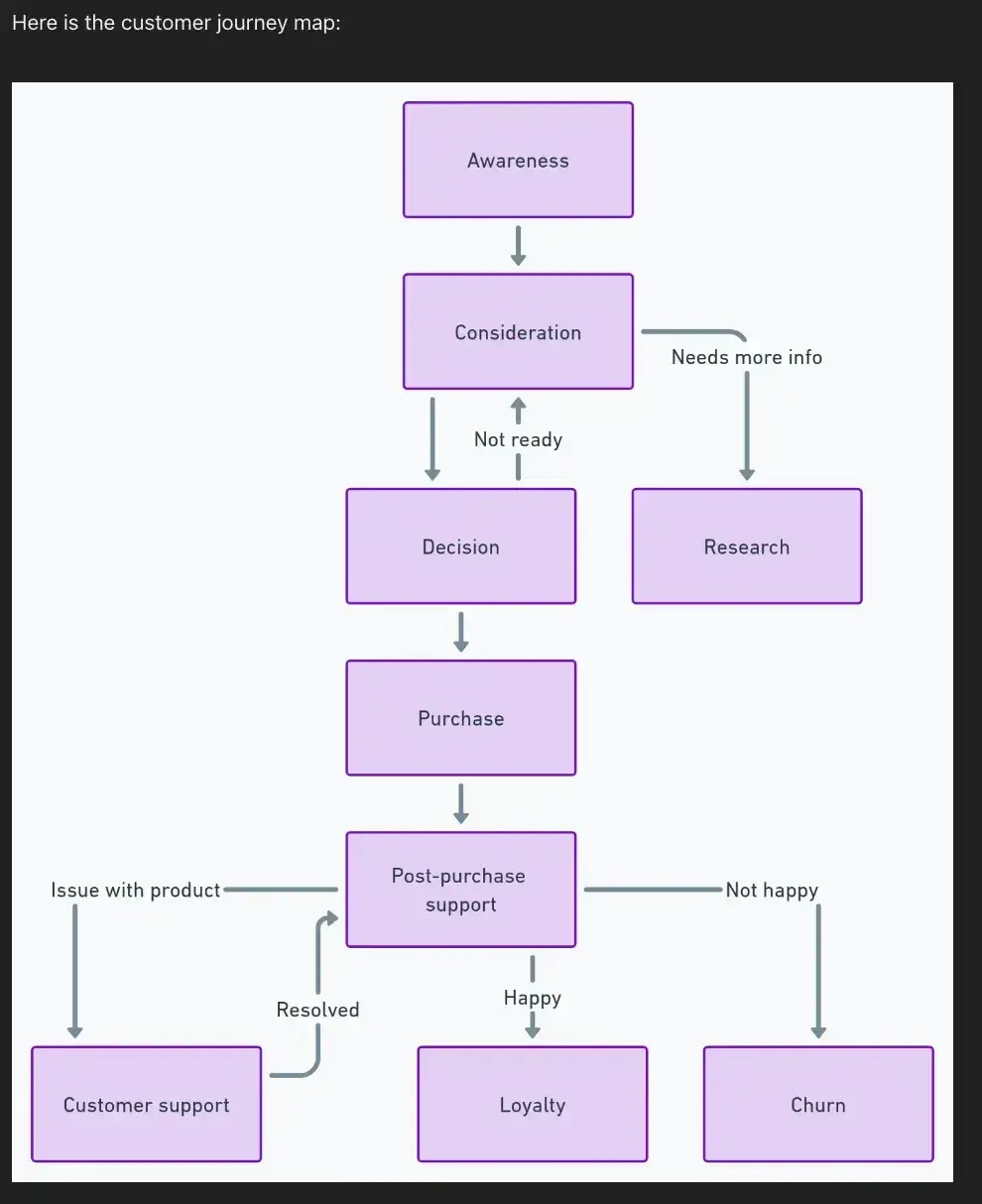
Step 6: Validate with human insight.
As with any AI tool, you’ll want to approach it with a hefty amount of skepticism and validate your findings with human expertise. Even in this process, I sometimes had ChatGPT recommend studies that simply didn’t exist.
While that‘s especially not ideal for writing an article — it can be harmful if you’re relying on this to build your business and boost your bottom line. By combining the AI-driven insight with feedback from your customer-facing teams and actual customers, you’ll get the highest quality output possible.
Pro tip: If you want help getting started with your own customer journey map, check out our templates here.
Don’t forget that the customer journey continues post-purchase. Check out our Post-Sale Playbook for more insights and strategies.
ChatGPT Prompts for Customer Journey Mapping
To see how I could use AI to learn about customer journey mapping, I first turned to ChatGPT to brainstorm some helpful prompts. I think of this step of the process as tapping into a research assistant where I’m simply experimenting with ways to improve the customer journey process.
You can see an example prompt and ChatGPT response here:
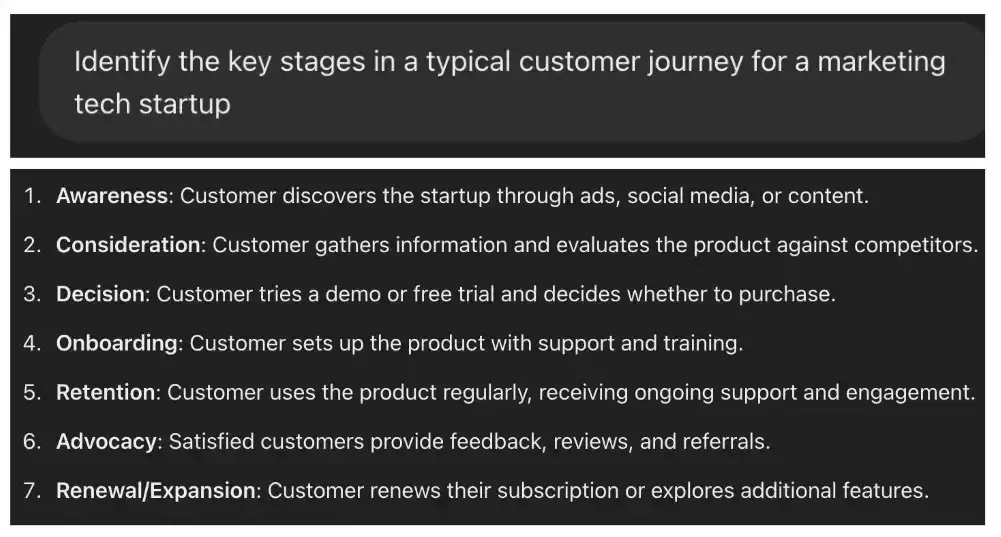
Here are some top prompts I’ve discovered that will save you a ton of time:
- Identify the key stages in a typical customer journey for [your industry].
- What are common pain points customers face when interacting with [your product/service]?
- What objections do my customers have before buying?
- List potential touchpoints between a customer and [your brand] throughout their journey.
- How can we measure customer satisfaction at each stage of the journey?
- What metrics should we track to evaluate the effectiveness of our customer journey?
- Suggest ways to personalize the customer experience at different touchpoints.
- How can we use customer feedback to improve our journey map?
- What are potential obstacles that might cause a customer to abandon their journey?
- Identify opportunities for upselling or cross-selling in the customer journey.
- How can we streamline the onboarding process for new customers?
- Suggest ways to personalize my post-purchase onboarding and support.
- What post-purchase customer interactions can we implement to increase customer loyalty?
- How might customer needs and customer expectations change throughout their journey?
- What are effective ways to gather customer feedback at different stages?
- How can we use AI to predict potential customer churn points?
- What are the key differences in the journey between new and returning customers?
- How can we create a more emotionally engaging experience throughout the journey?
- How can we drive customer loyalty? List points for improvement in our process.
- What are potential triggers that move a customer from one stage to the next?
- How can we better align our marketing efforts with the customer journey?
- What role does customer support play in the overall journey, and how can it be improved?
- How can we use AI to create more accurate customer personas for our journey map?
- What external factors, such as economic fluctuation and seasonality, will influence my customers’ buying decisions?
- What are the most common drop-off points in our [email nurture sequence, website, etc.], and how can we address them?
- Where is automation least effective in my customer journey — where do our customers need the most one-on-one contact?
- What data should we start collecting now to get actionable and accurate predictive analytics on our customers later?
- What trends are going to influence our customers’ needs and buying decisions?
- Which of our customer segments are underserved, and what are suggestions for filling the holes?
- What data should we be collecting now to accurately analyze our customer journey 6 months from now?
Pro tip: When using AI, remember your outputs will only be as good as your inputs. The more details you can give about your business, your objectives, your data points, etc., the more tailored your responses will be.
You can save time in this process by creating a custom GPT with a ChatGPT plus membership. This personalized chat will be trained on your business data and act as a tailored AI knowledge base for your business.
Testing It Out: How I Created a Customer Journey Map With AI
To learn how to build a customer journey map with AI, I wanted to try it out myself.
Here’s a simple prompt that I tested out. Keep in mind that I added some background information about what services I offer, who my customers are, etc., so that I would get a more tailored response.

The response? I was able to turn the initial results into a simple chart with the help of Claude. You‘ll see that it covers touchpoints, client actions, opportunities, and metrics at each stage of my buyer’s journey. Not a bad start if you ask me!
|
Touchpoints |
Client Actions |
Opportunities |
Metrics |
|
|
Awareness |
Website, social media, referrals |
Discovering your services, initial research |
Improve SEO, create valuable content, and enhance social media presence |
Website traffic, social media engagement |
|
Consideration |
Portfolio, testimonials, blog posts |
Comparing services, reading reviews |
Showcase diverse writing samples, highlight client success stories |
Time on site, portfolio views |
|
Interest |
Contact form, email, phone call |
Reaching out for more information |
Quick response time, clear communication of services and process |
Inquiry rate, response time |
|
Evaluation |
Proposal, follow-up emails, consultation call |
Reviewing proposals, asking questions, considering options |
Personalized proposals, addressing common concerns proactively |
Proposal acceptance rate, time to decision |
|
Decision |
Contract, payment process |
Signing contracts, making payments |
Streamline contract process, offer multiple payment options |
Conversion rate, time from proposal to contract |
|
Onboarding |
Welcome email, project kickoff call |
Providing project details, setting expectations |
Smooth onboarding process, clear communication of next steps |
Client satisfaction score, project start time |
To take it one step further, I took this data and added it to a Whimsical Diagrams GPT to create a visual chart. There were still some kinks to work out with the prompting, but I eventually got to a basic version that I’m pleased with.
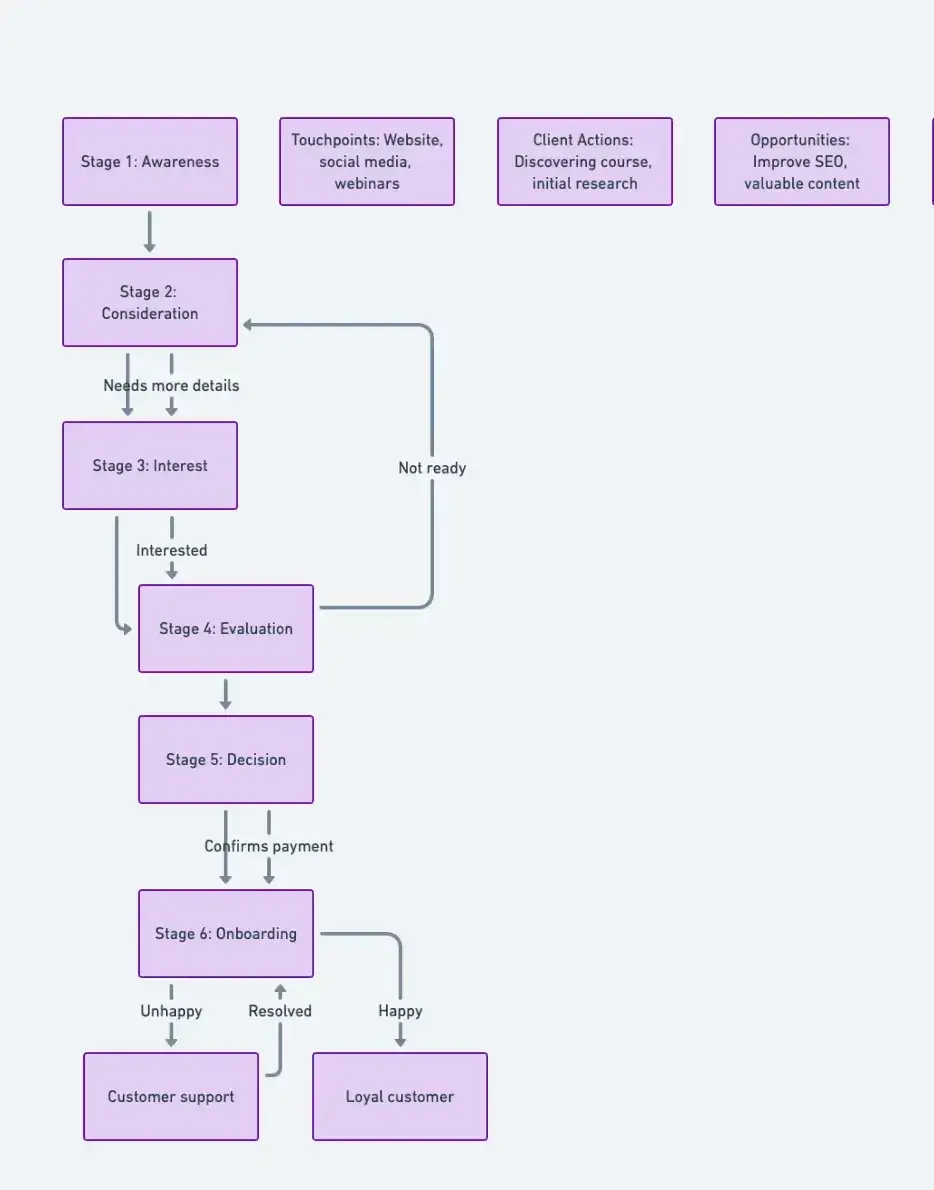
Going through this process, I discovered that I had two problems (read: areas of improvement) on my hands. The first is that I lacked a lot of customer data that I needed to input into the AI — so this was a good nudge for me to find better ways to monitor my customers’ journey. The metrics column here offers a great starting point for KPIs I can track — and ideally improve.
I also found that there was a pretty big gap for buyers at the consideration stage. I don’t always make it clear why they should hire me instead of my competitors. Luckily, this chart is actionable for me. I’m able to focus on creating more diverse writing samples and client success stories — and will be tracking this through my site metrics.
Pro tip: Once AI has helped you identify the holes in your customer journey, use it to help you make a plan to fix it. Try customizing this prompt:
I’m making a customer journey map for my [freelance writing] business, and I have gaps in the [consideration stage]. What are ways for me to fill this stage of my customer journey map?
ChatGPT had great suggestions for me, like strengthening my portfolio, gathering more social proof, and developing low-commitment offers for new clients.
Helpful AI Tools for Customer Journey Mapping
Of course, there are so many incredible AI tools on the market that go beyond ChatGPT. If you’re serious about incorporating more AI into your process, I highly recommend checking these out. Again, I tested each of these out for my own business to see first-hand what the experience is like as a user.
1. Taskade
You might already be familiar with the AI tool Taskade. It offers a ton of helpful work management features, like managing tasks and team collaboration. But I found their User Journey Map Generator (powered by AI) to be a really helpful tool in both brainstorming and visualizing the customer journey map.
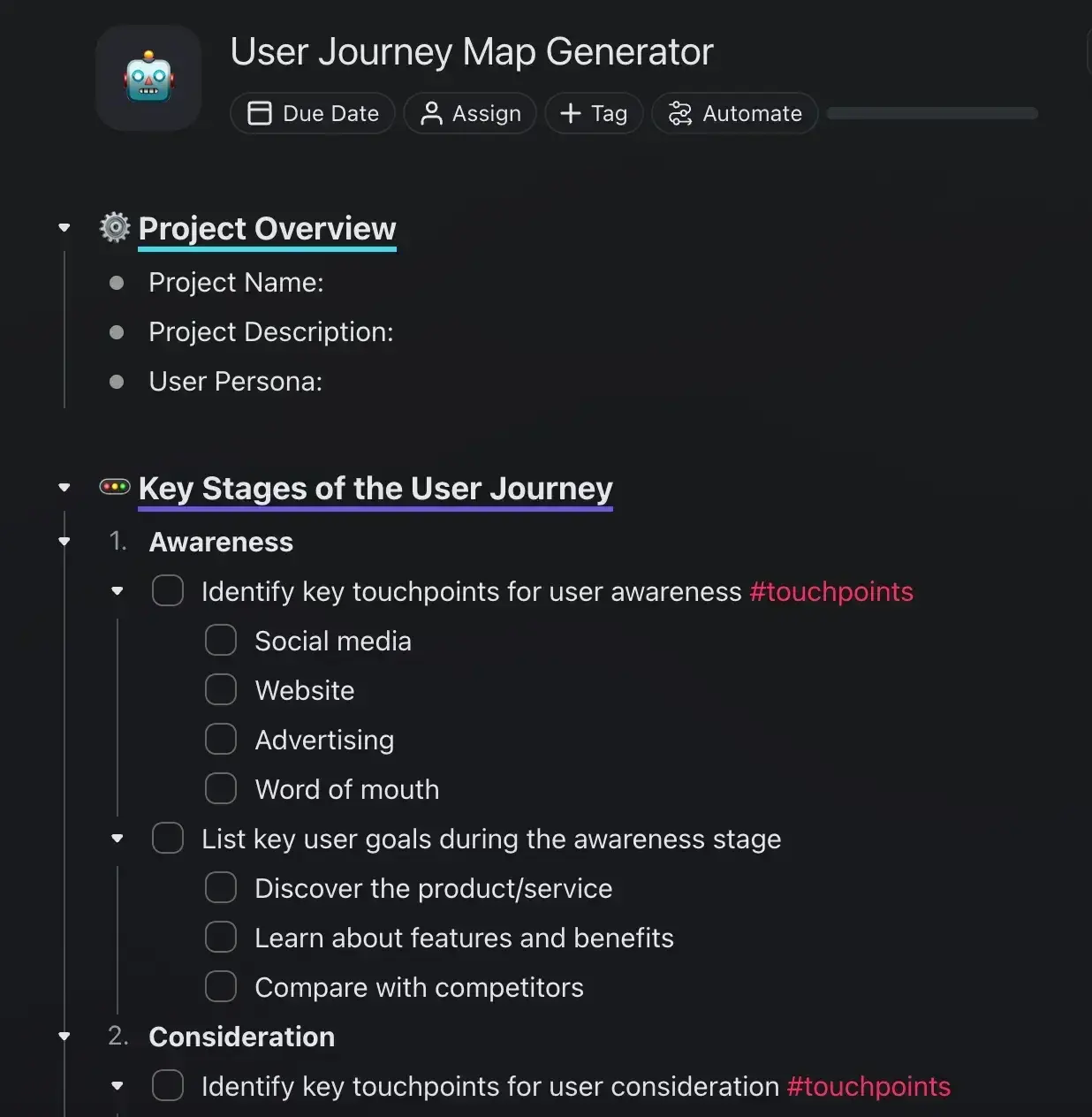
Key features:
- Integration with other project management tools.
- Real-time collaboration capabilities.
- AI-driven journey map creation.
- Customizable templates.
Pro tip: Taskade’s AI can help generate journey maps based on your input, making it an excellent starting point for beginners new to journey mapping (aka me!). What I really liked is that you can use their AI agent at various points of the process, which will help you research specific bullet points, develop an outline, and even spell-check.
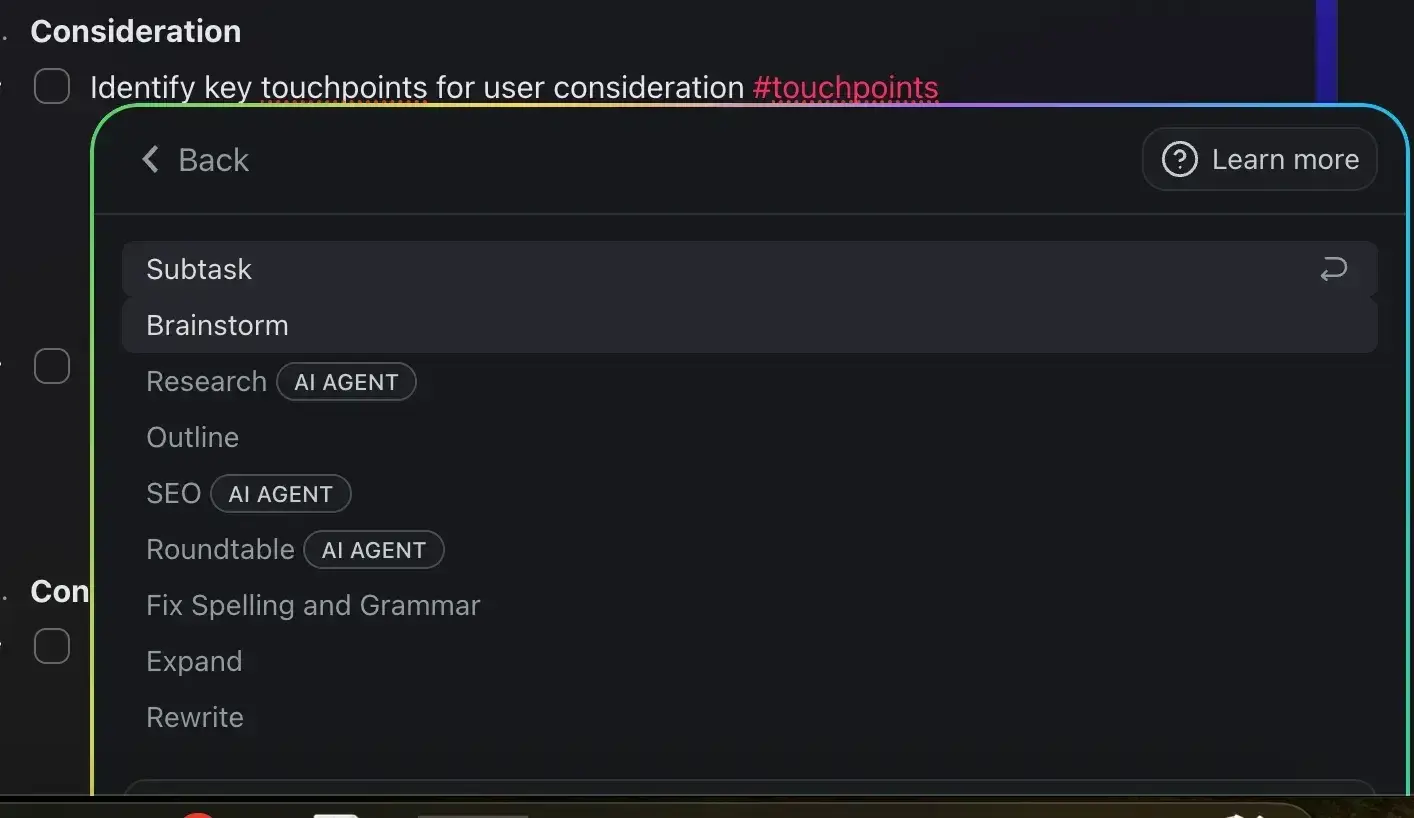
2. Twilio Segment
Twilio Segment is a powerful customer data platform that can help make your journey mapping a breeze. While not exclusively a journey mapping tool, it has strong capabilities for data collection and analysis that can help you create a more detailed customer journey.
For example, you can visualize the journey a specific customer might take who hasn’t purchased from you in three months but has visited your site in the past month. Without using AI, think how much time you could spend trying to track, identify, and tell a story from these data points.
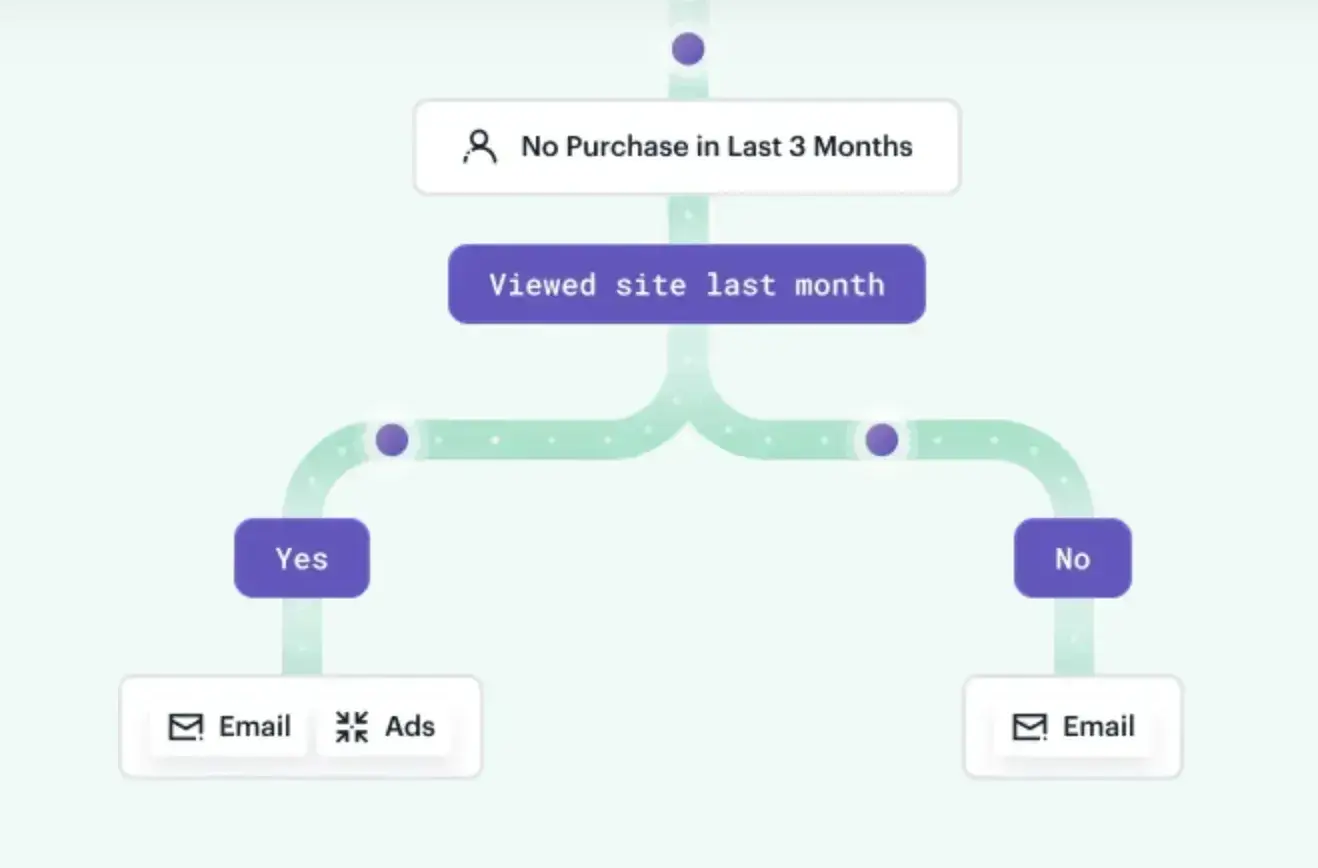
Key features:
- Integration with over 300 tools and platforms.
- AI-powered customer segmentation.
- Unified customer data collection.
- Real-time data analysis.
Pro tip: This also helps CX teams increase their personalization — which is a top priority according to our State of Customer Service report.
3. Journey AI
Although last on this list of tools, Journey AI is one of the most fascinating tools I discovered during my research process. Created by TheyDo, Journey AI instantly converts customer research into journey maps packed with actionable insights — and saves you hours worth of manual work.
For example, you can input your text-based research (think everything from sticky notes to surveys) to create a customer journey map tailored to customer feedback.
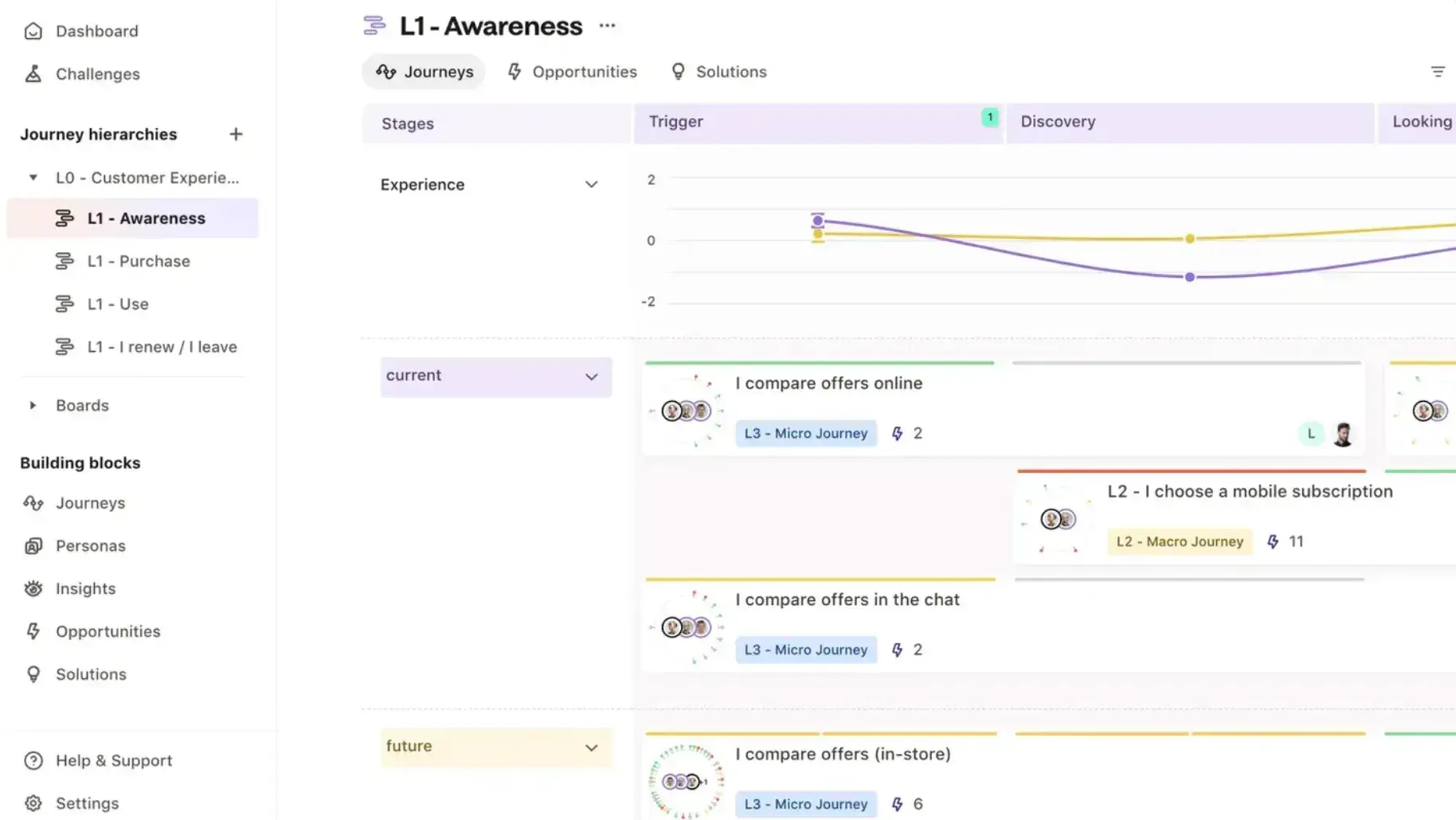
Key features:
- Standardize and scale customer journey mapping and management.
- Creates customer journey maps in a matter of minutes.
- Intuitive, easy-to-use editor.
Personalize Your Customer Journey With AI
As I was researching and reviewing these AI tools, what I found most fascinating is all the ways you could personalize and improve customer journey maps with the click of a few buttons (plus some trial and error). Through this process, I was able to tweak my prompts and inputs throughout to tailor it for my specific business and needs. If you can apply the same lessons, the outcome is powerful.
AI can help transform a task that is arduous, time-consuming, and complex into one that is streamlined, driven by data, and easy to understand. This empowers me on my business journey to focus more on what I do best — while also ensuring that I keep a steady stream of happy customers. (A win-win!)
Of course, this is a great place to remind you that AI is not a magic solution. It‘s a powerful tool that works best when combined with human insight and expertise. As I continue to test new tools, I’m excited to see how AI will further help me improve my customer journey and build my business.
Editor’s note: This post was originally published in October 2024 and has been updated for comprehensiveness.
![]()












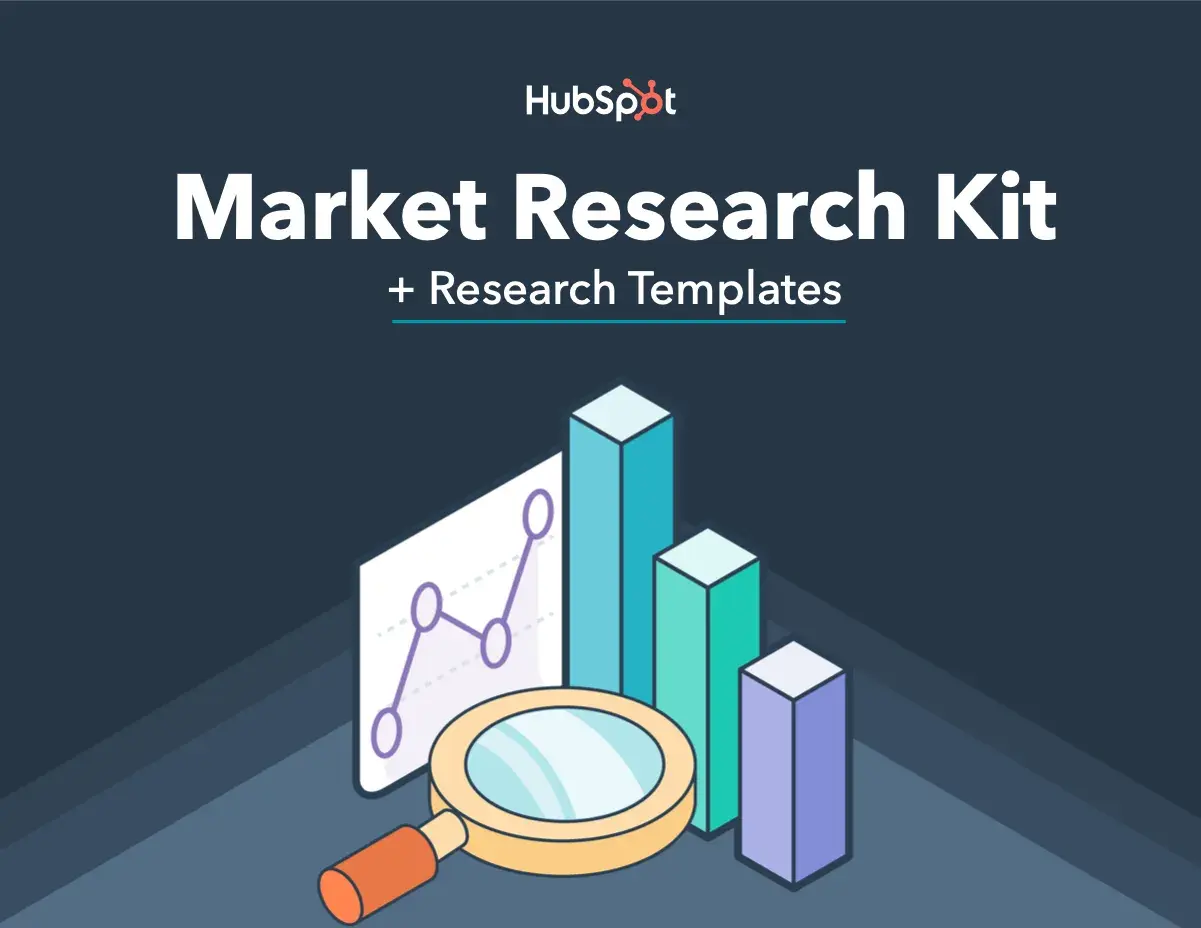
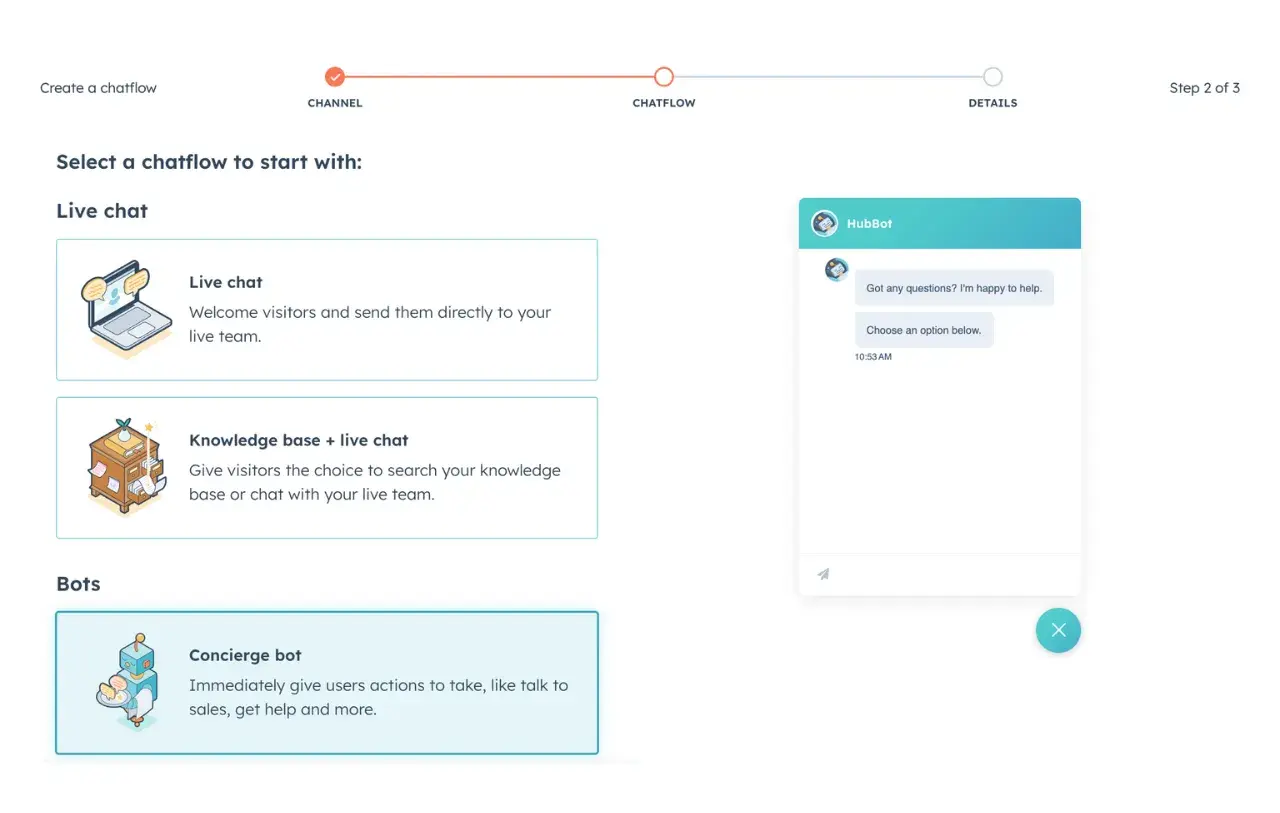
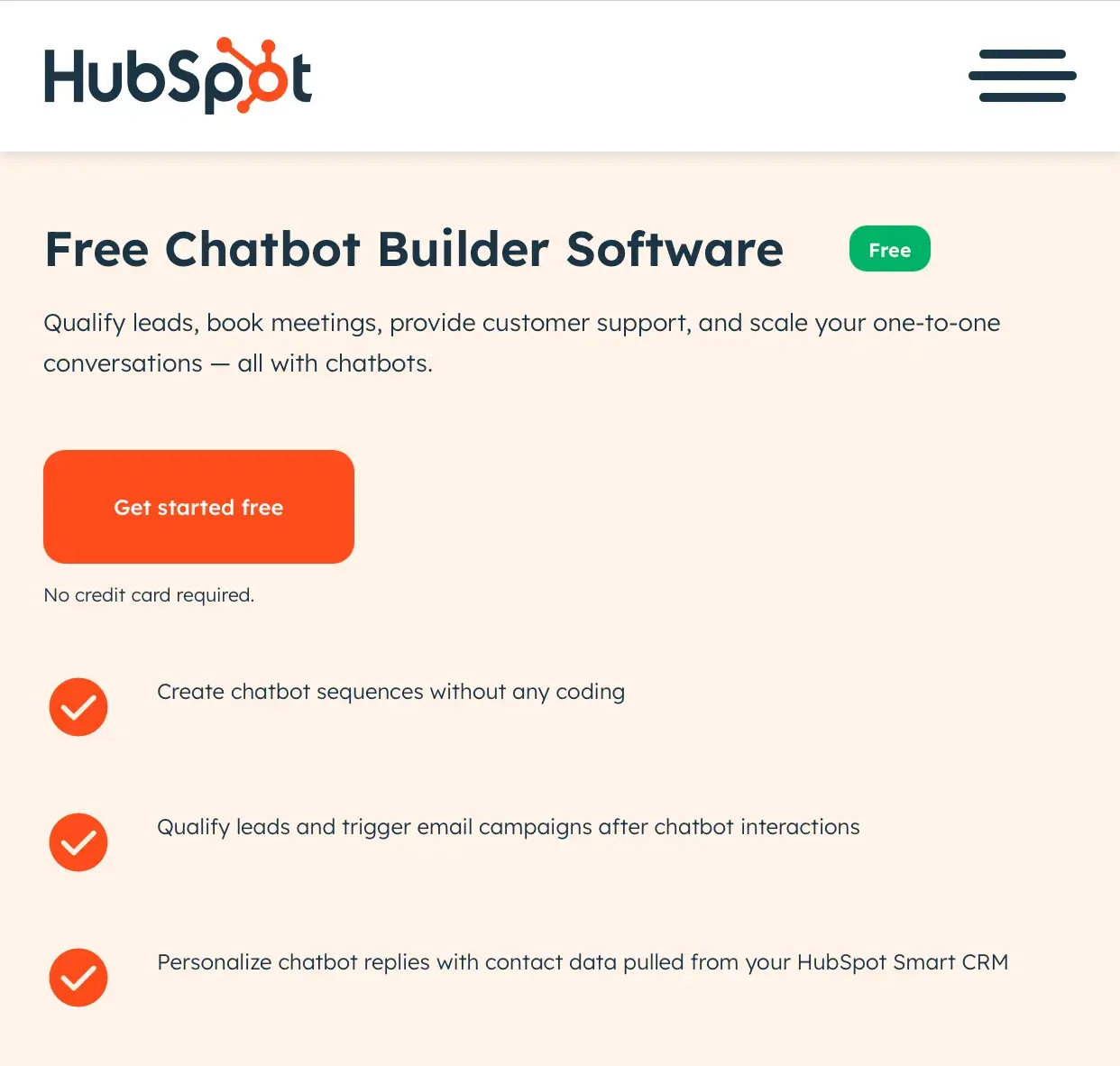

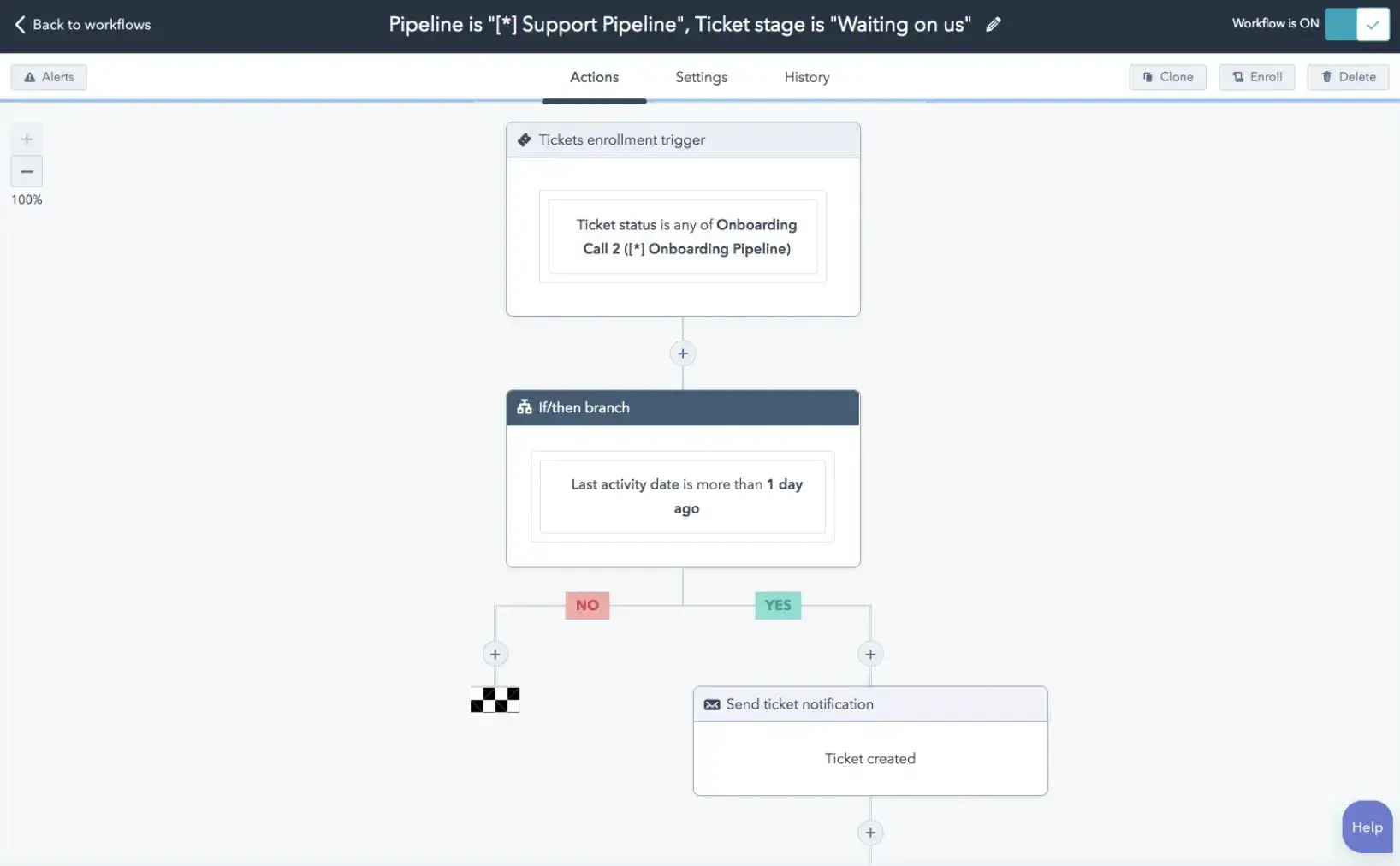
![→ Download Now: The State of Customer Service [Free Report]](https://no-cache.hubspot.com/cta/default/53/9c545446-aacf-47a3-bfb3-1998f78b79c8.png)